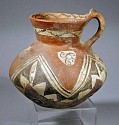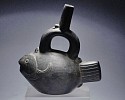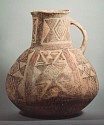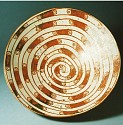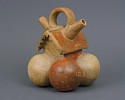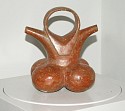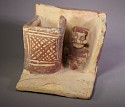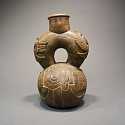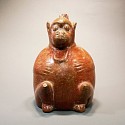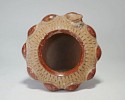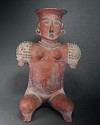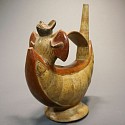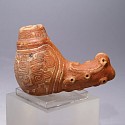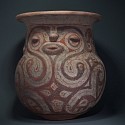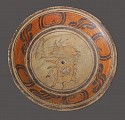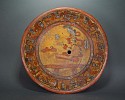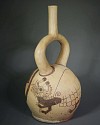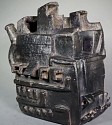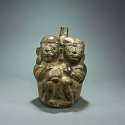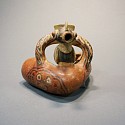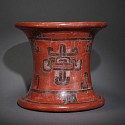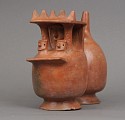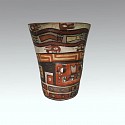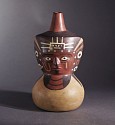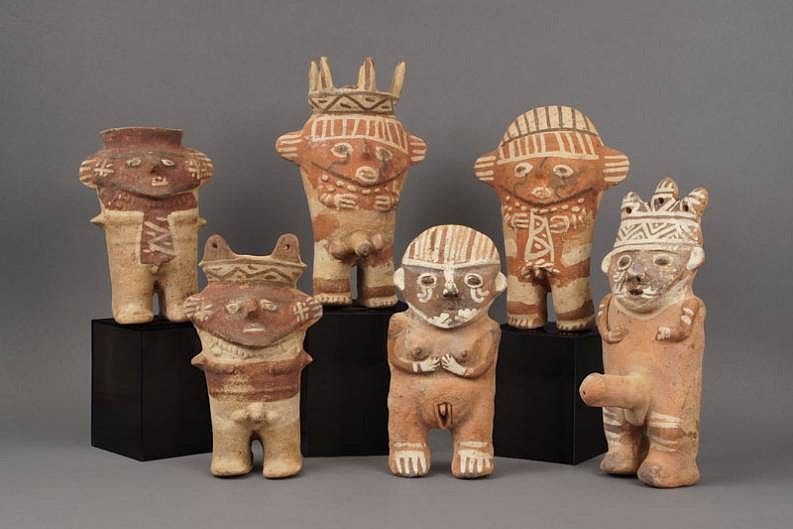
Peru, 3 Pairs of Early Chancay Fertility Figures
These are rare and unusual Chancay figurines with painted surfaces in brick, beige and brown umber. The strong brown umber painted lines suggest an early Chancay phase with Wari influence. The figurines are wearing costumes that suggest important status, particularly the male figures, which each have a crown. The women wear braided hairstyles. The genitalia are exposed in enhanced proportions, likely part of a fertility symbolism related to agricultural production.
Media: Ceramic
Dimensions: Height Males c.10" Height of Females c.9"
Price Upon Request
M9014Hb
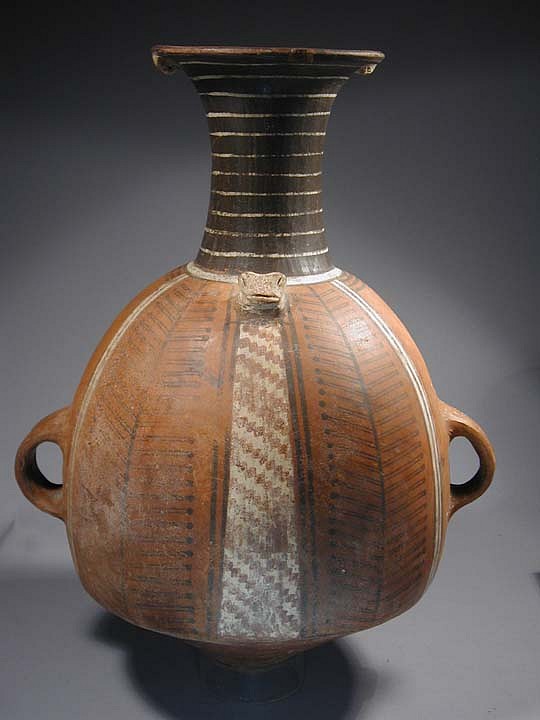


Chile, Arica / Inca Aryballus with geometric design from Chile
Although the Inca conquest of Chile lasted for a period of only seventy years until the arrival of the Spaniards, the magnitude of its aesthetic impact is undeniable. These two ceramic aryballus vessels are classic examples of that influence. Each vessel has two lug handles and a feline head knob to hold the temp line. Both are decorated in the expressively elegant geometry of the Inca. In very good condition with all original pigment intact. A similar example with a post fired cross hatching design is illustrated in Ceramics of Ancient Peru by Christopher donnan, fig 219. Another very similar example with the diamond motif is illustrated in "Chile Indigena", Museo Arqueologico de Santiago, Chile, 1991.
Media: Ceramic
Dimensions: Height: 14"
Price Upon Request
96090A
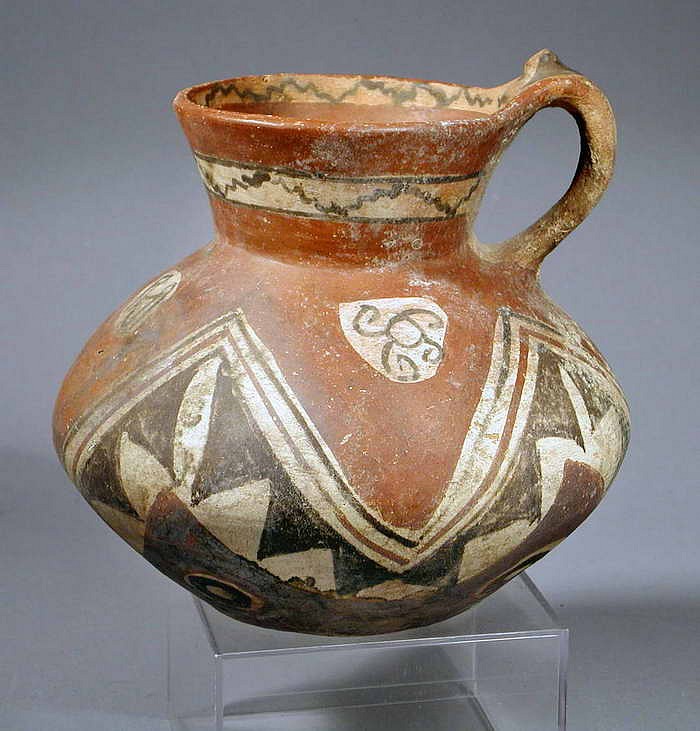


Chile, Arica Lug Handled Pitcher with geometric designs in black, white and red
San Miguel style white and black on red slip ground. The geometric design consists of four white circles inside a red ground, and underneath are a undulating bands of lines and triangles. Below this are black and white concentric cirles, and black and white bands inside and around the spout. The colors and designs are similar to a vessel illustrated in Cultures De Chile Prehistoria, Chile (1997: 196-a and d), and Excavations in Northern Chile by Junius Bird (1943: 199-jand f ).
Media: Ceramic
Dimensions: Height 6 1/2" x width 8"
$1,500
M3011
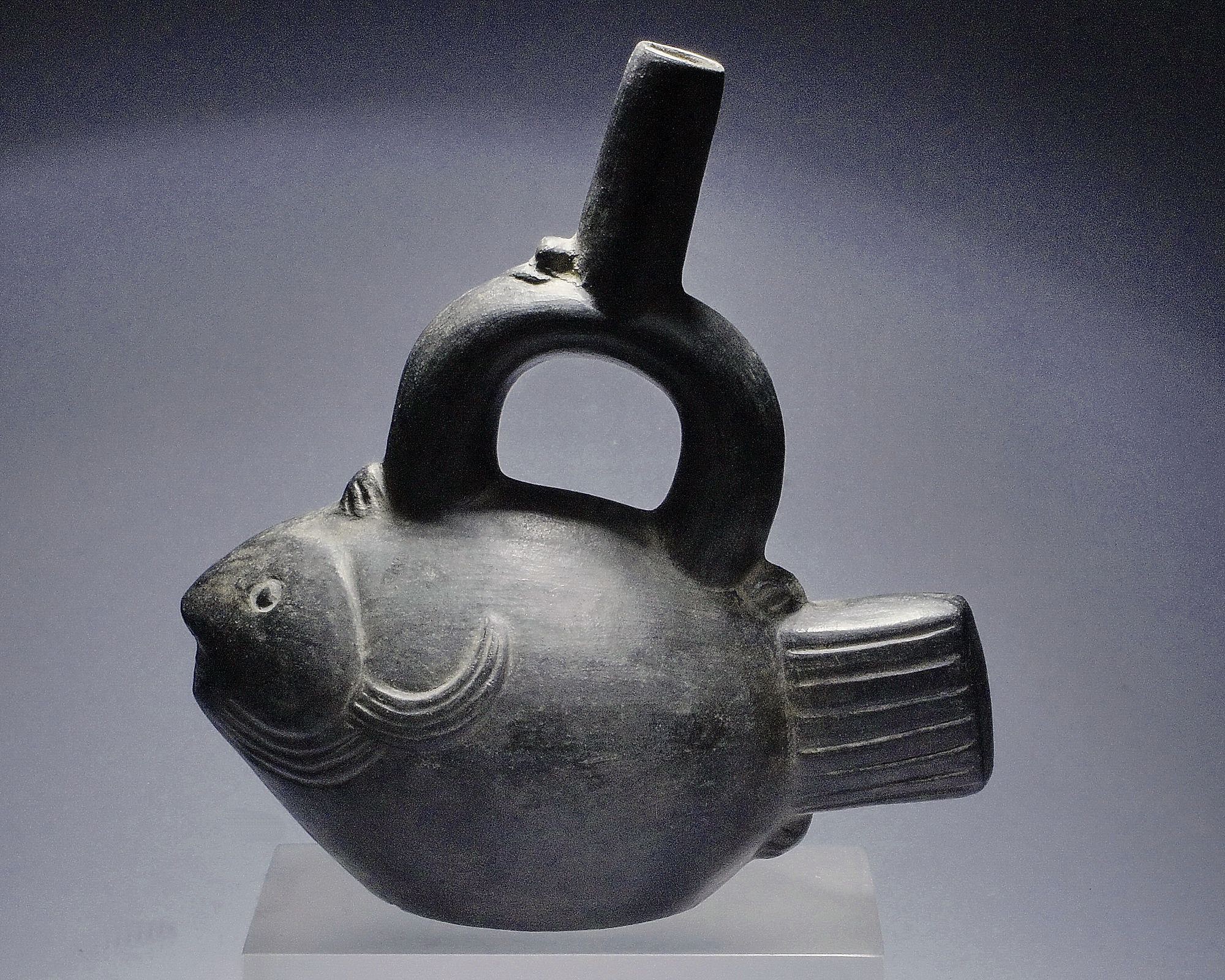




Peru, Blackware Vessel in The Form of a Bonito
This fish is identifiable as a bonito by its pointed mouth and teeth. In the same family as tuna, but smaller, the bonito is one of the most abundant fish in north coastal Peru.
Media: Ceramic
Dimensions: Length: 8" x Height: 8 1/4"
$1,500
n2016
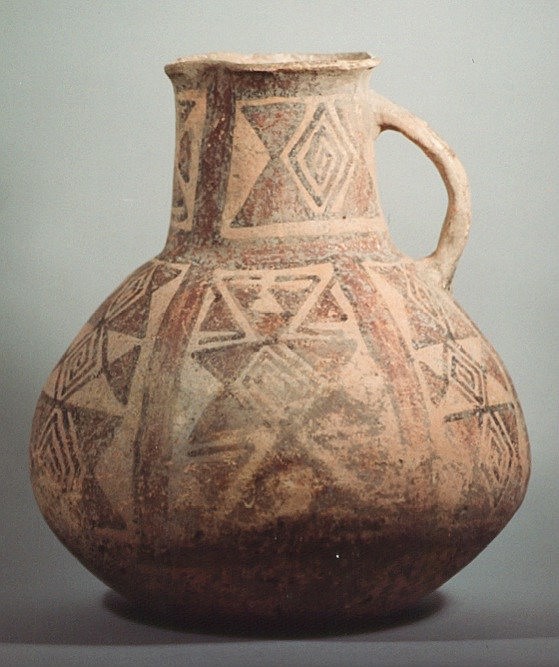
Bolivia, Bolivian Ceramic Vessel Decorated with Geometric Designs
Large ceramic jug handle vessel with geometric designs of concentric diamonds in red, brown, and black slip on a pink buff ground. Vessels with similar designs are also found in Arica, Chile and Southern Bolivia, and appear to be a regional integration style.
Media: Ceramic
Dimensions: Height 11"
94207x
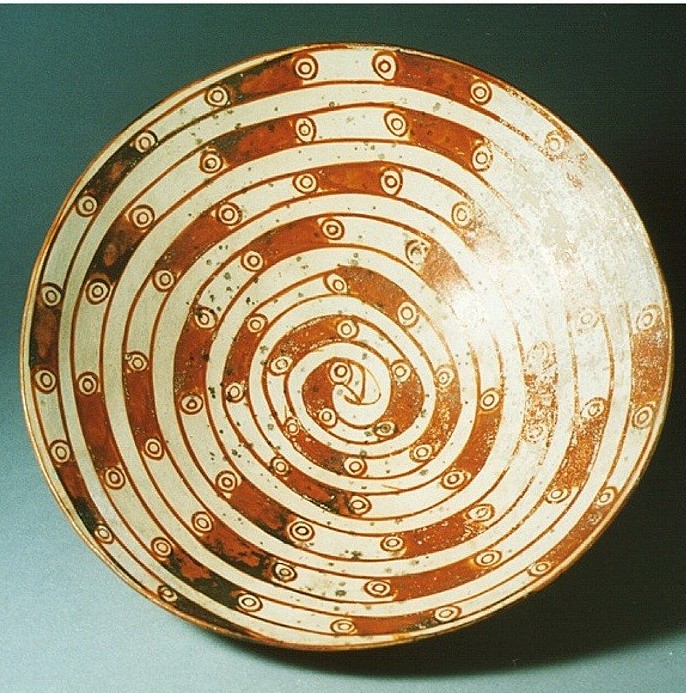
Peru, Cajamarca Low Orangeware Bowls with Coiled Serpent
This bowl has an orange and white spotted coiled serpent motif and a footed base. The Cajamarca culture has a long role in Peruvian pre-history going back to Chavin times until 1532 when the Inca king Atahualpa was killed by Pizarro. Today there still exists a beautiful cut stone "Inca Bath" of warm mineral water that was enjoyed by Inca nobility. A similar style of ancient plate from Cajamarca is in the Museum at Cajamarca. The orange and white slip decoration demonstrates the high artistic control that the Cajamarca artisans had over the medium. A great deal of control over the firing process was required to prevent the orange slip from turning brown
Media: Ceramic
Dimensions: Diameter: 10 inches.
Price Upon Request
97111a
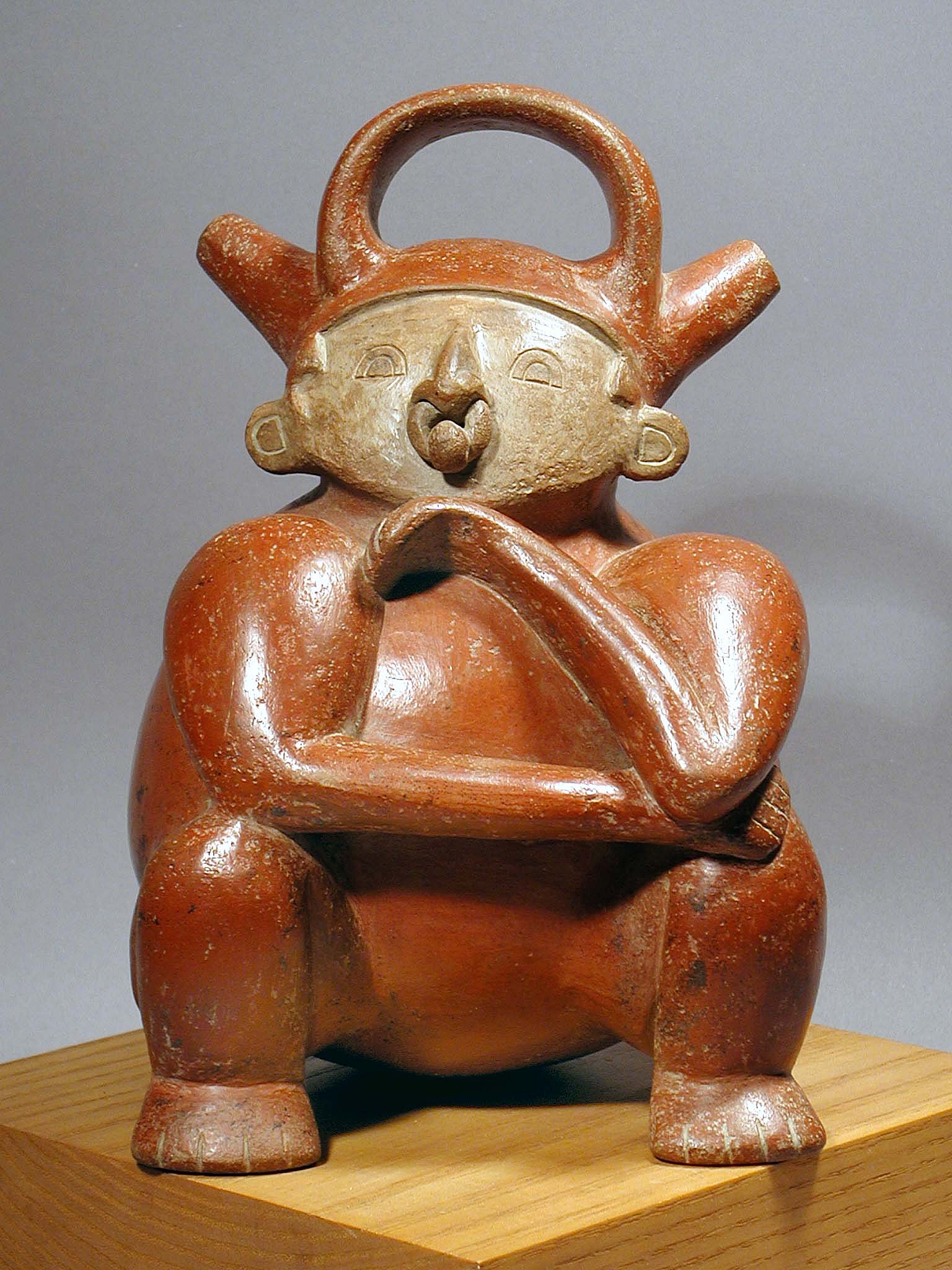



Colombia, Calima Alcarazza Effigy in the form of a Seated Shaman
A similar effigy is illustrated "Calima: Diez Mil Anos de Historia" by Schrimpff, Bray et. al. (1992: pl. 38).
Media: Ceramic
Dimensions: Height 8 3/4"
Price Upon Request
M4015
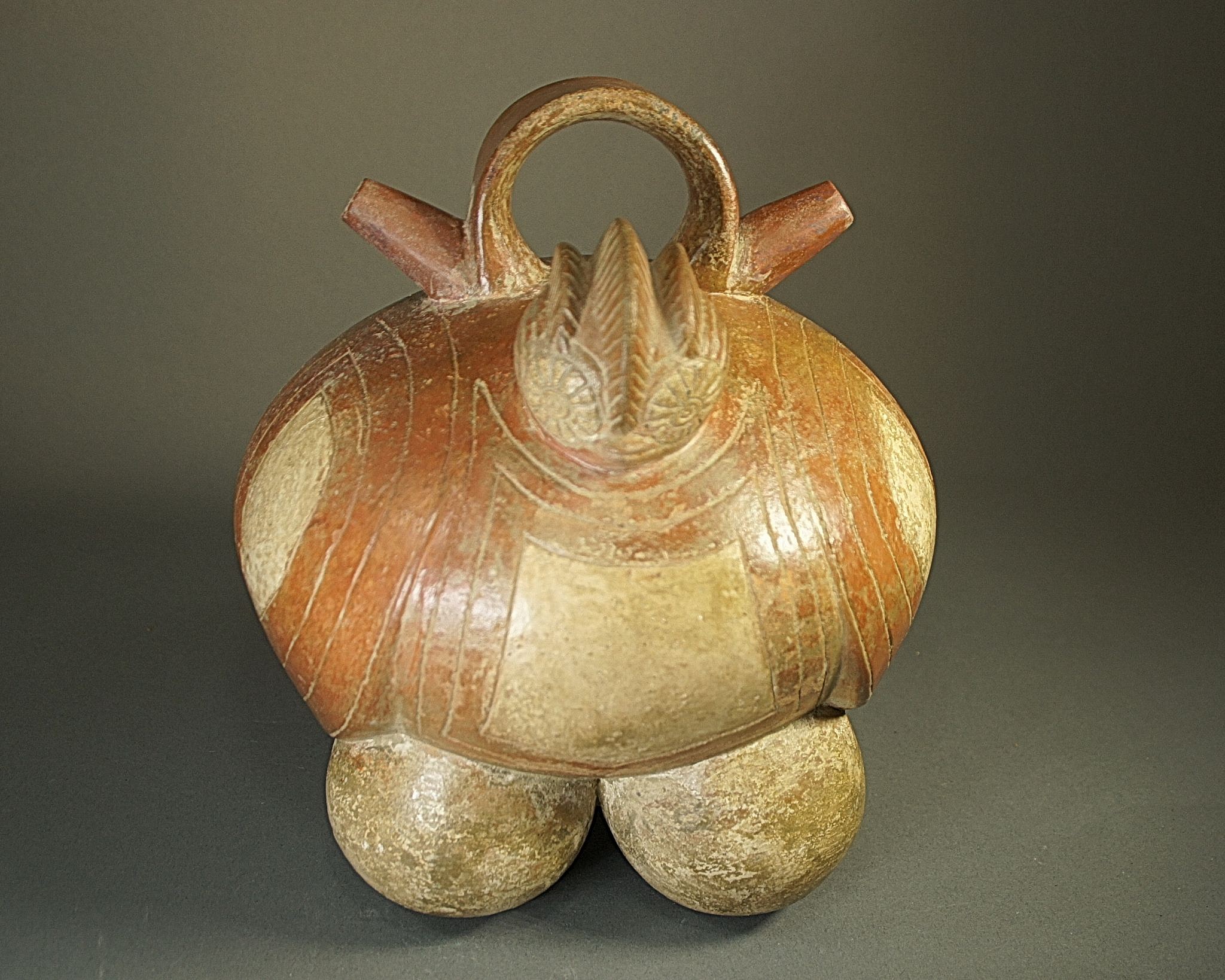





Colombia, Calima Alcarazza of a Crested Bobwhite With Rounded Body and Legs
The bobwhite has a small head with large gray eyes and is decorated with brick and buff toned slip highlights. The crested bobwhite is a member of the partridge family and is still found in Colombia today. A similar vessel is illustrated in CALIMA AND MALAGANA ART AND ARCHAEOLOGY IN SOUTHWESTERN COLOMBIA, pg.43.
Media: Ceramic
Dimensions: Height: 8"
Price Upon Request
m9009
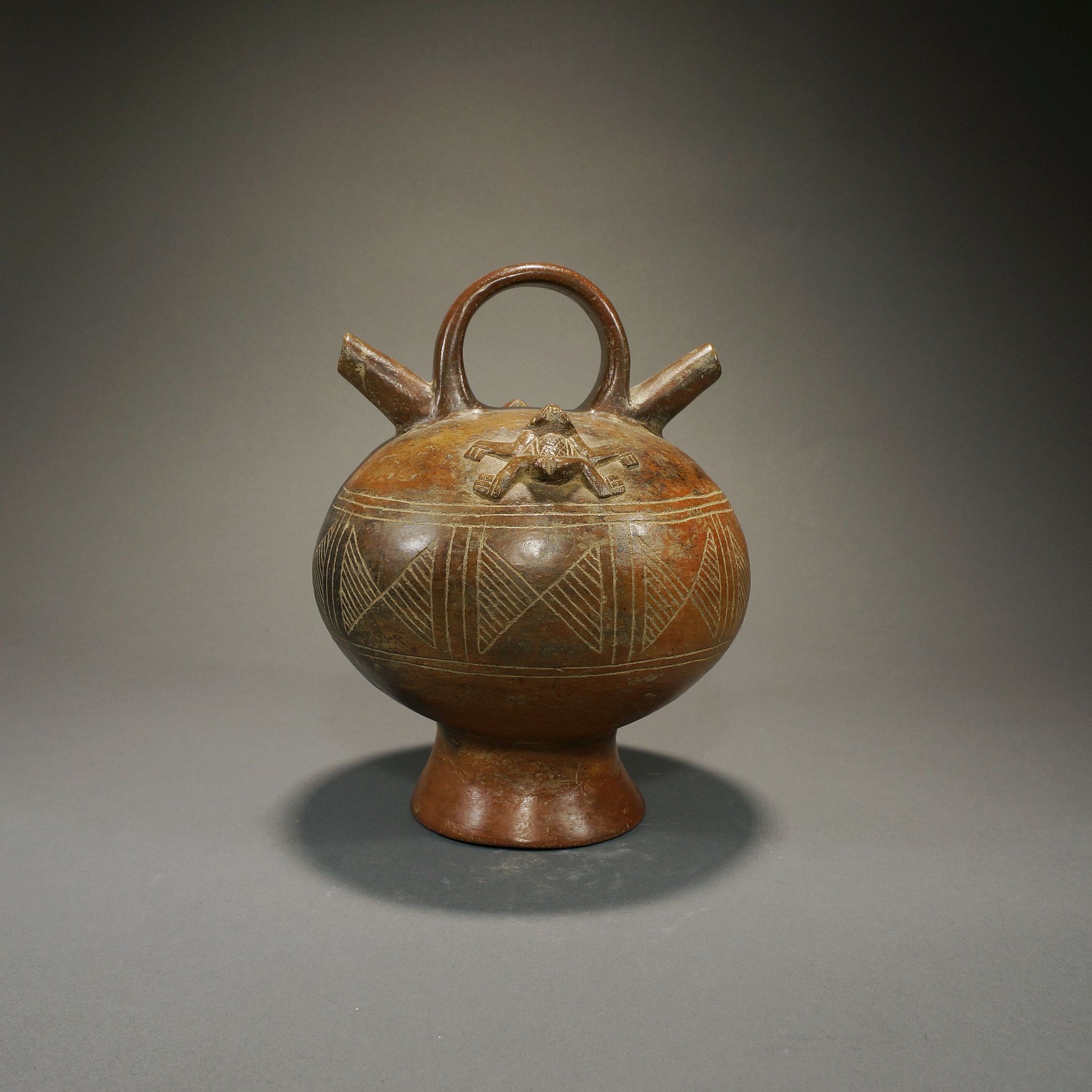
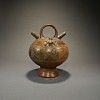

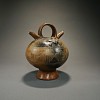
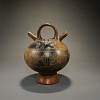
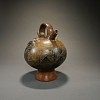

Colombia, Calima Alcarraza with Frog Relief Sculpture and Incised Geometric Designs
The Alcarazza is a style of ceramic vessel made by the Calima culture of ancient Colombia. Often they are decorated with geometric forms and occasionally can be animal effigies. They tend to be very elegantly styled. Similar examples are illustrated in "Colombia Before Colombus" by Armand Labbé (1986). These vessels were used for storing chicha beer for ceremonial occasions. The double spout allowed the liquid to pass evenly out one spout while air entered the other.
Media: Ceramic
Dimensions: Height: 7 1/2" inches
Price Upon Request
M7113
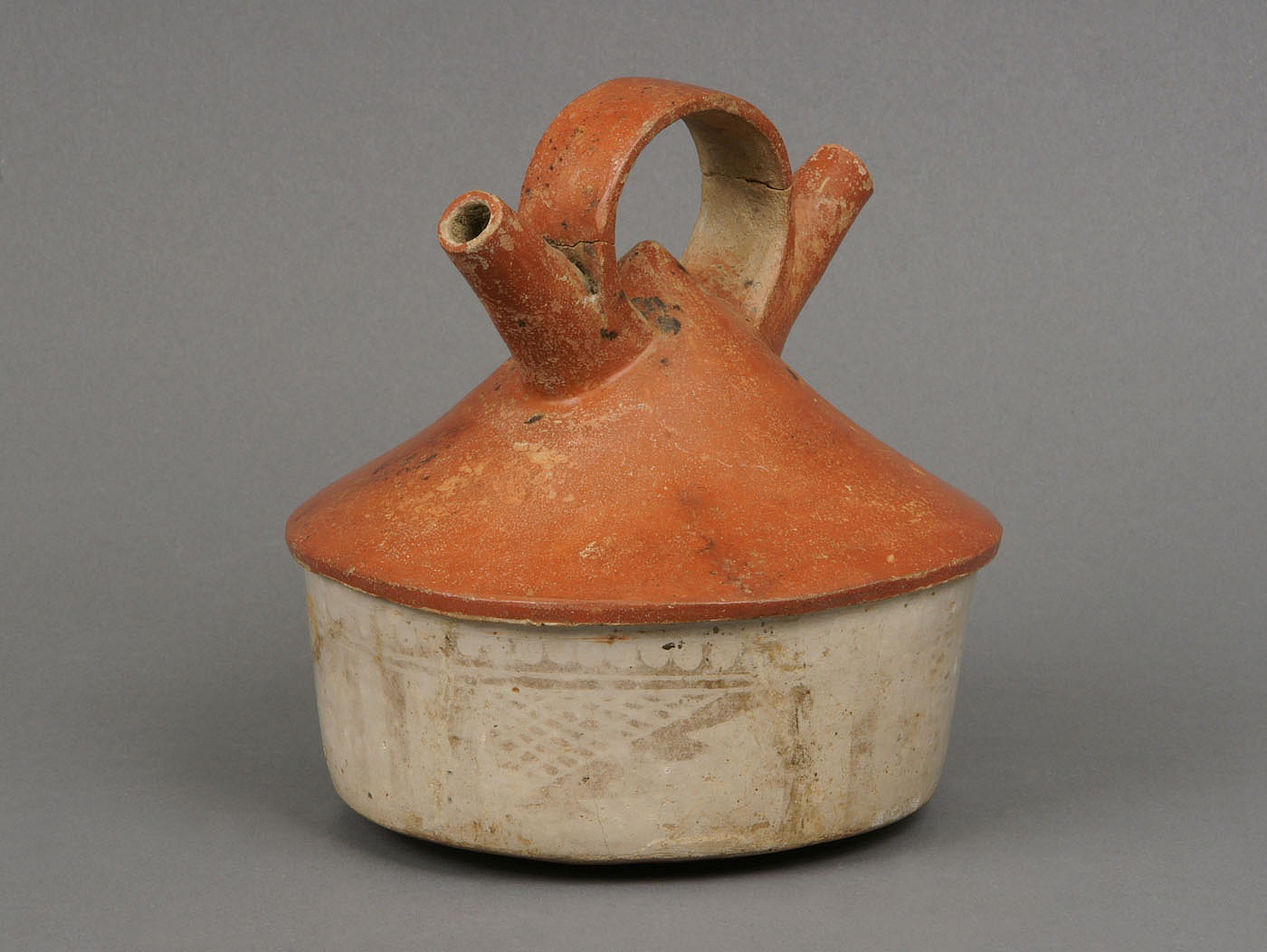


Colombia, Calima Ceramic Double Spout Vessel in Shape of a Circular House
Simply designed, Calima conventional style, slip painted, red and white ceramic "alcarraza" with a double spout bridge handle, in the form of a round house with a peaked roof. The creamy base retains traces of black resist geometric motifs in a lattice or net-like composition, considered to be a trademark of the Calima style (see Labbe, A."Columbian Gold and Ceramics in Antiquity", pp144-148) .
Media: Ceramic
Dimensions: Height: 6"
$4,500
MM032
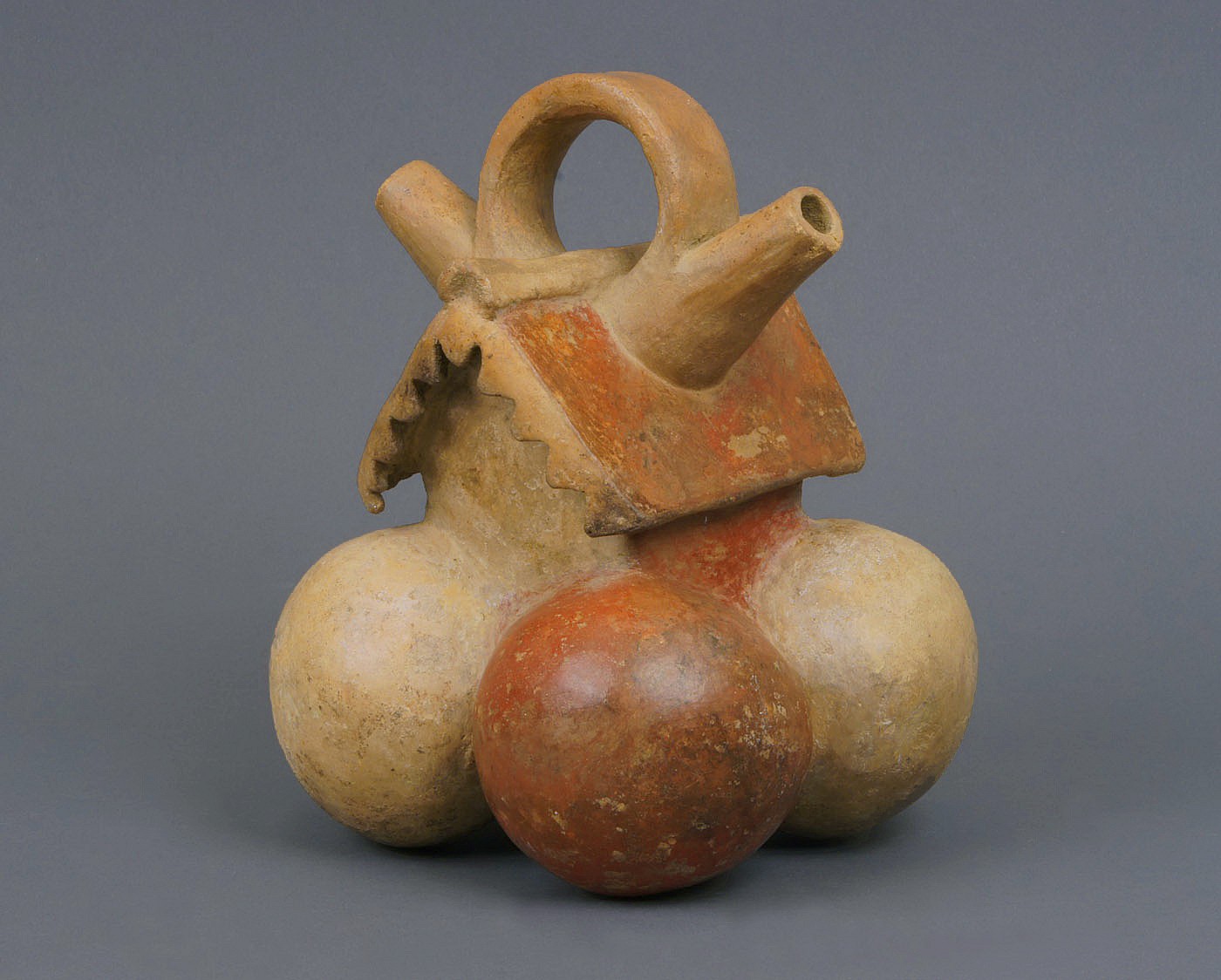


Colombia, Calima Effigy Vessel in the Form of a House
A house model resting on four globular feet. Vessels from the Calima region of Colombia, also known as alcarazzas, have a very distinct shape, typically with two spouts on the diagonal. For more examples, see "Colombia Before Columbus" by Armand Labbe (1986: 64-95) and "Calima" by de Schrimpff, Bray et. al. (1992: 113-118), which is where the reference drawing shown here has been taken from. A number of alcarazzas represent houses and probably mimic the actual dwellings of ancient societies in Calima.
Media: Ceramic
Dimensions: Height 8"
$3,500
99318
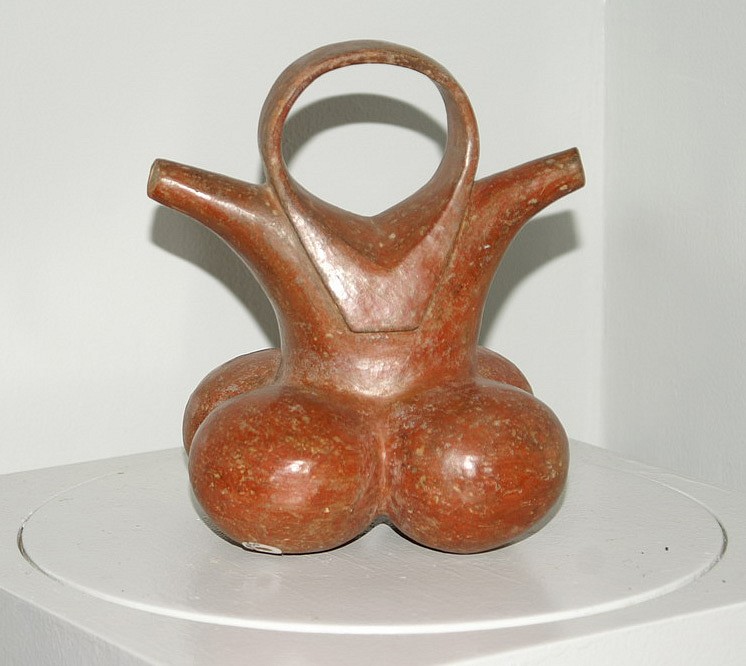
Colombia, Calima Redware Alcarazza with 4 globular sections
The Alcarazza is a style of ceramic vessel made by the Calima culture during the early Llama phase. Often they are geometric forms and occasionally can be animal effigies. They tend to be very elegant styled vessels. Similar vessels are illustrated in "Colombia Before Columbus" by Armand Labee, Bowere Musuem, Ca.. These vessels were ceremonial Chica storing vessels. The double spout allows the liquid to pass evenly out one spout while the air enters the other.
Media: Ceramic
Dimensions: Height 7 1/2"
$3,800
MM150
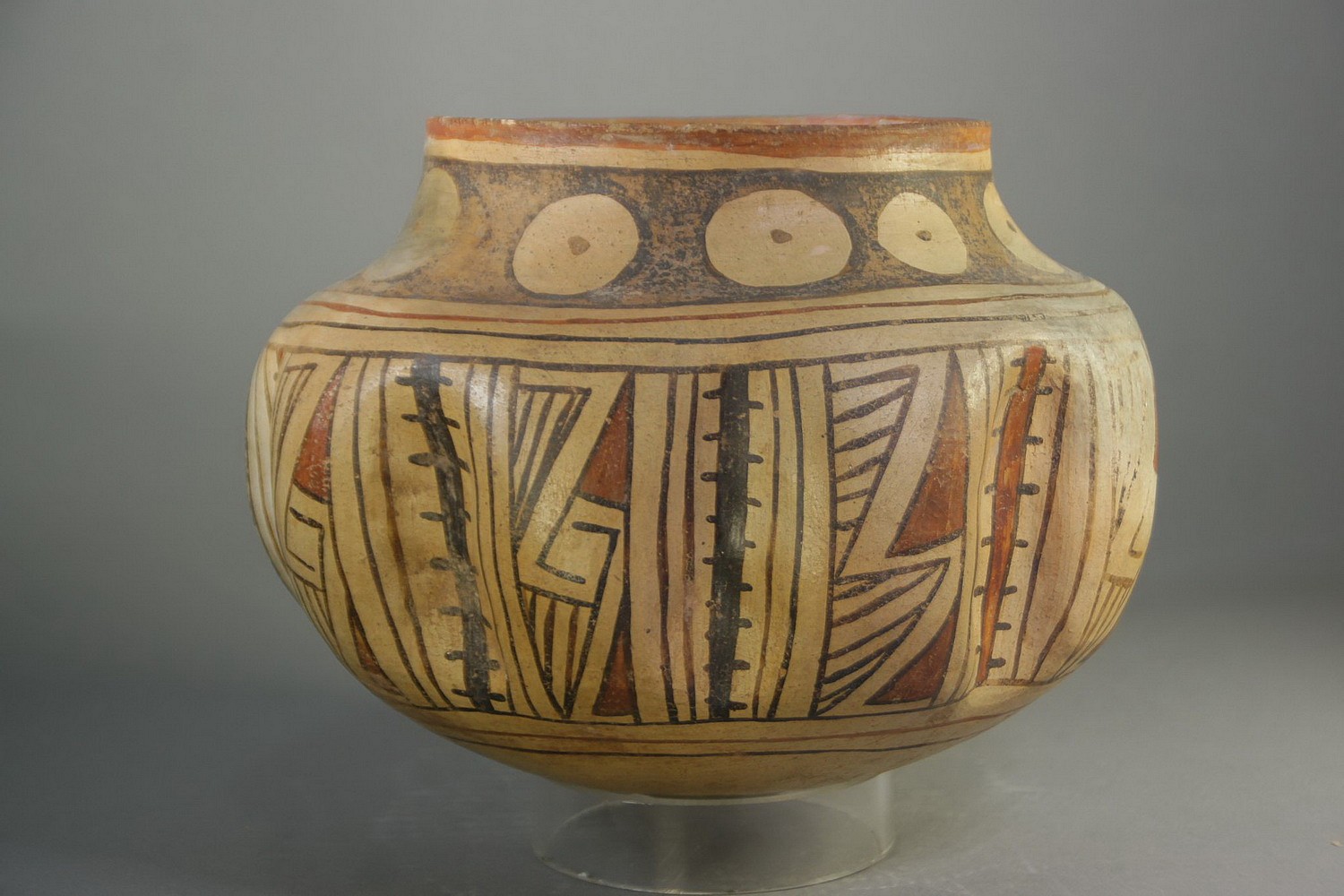




Mexico, Casas Grande Gadrooned Ceramic Vessel with Geometric Designs
This unusual ceramic bowl has nine fluted sections separated by symbolic cacti imagery. The bowl is painted with red and black geometric designs on a beige ground. On the bottom are three large concentric black lines. It has a tapered neck that is decorated with nine beige circles on a black ground. Each circle has a central black dot, which symbolizes an aerial view of a cactus. This vessel originates from Casas Grande, a site located in the Mexican state of Chihuahua, along the Casas Grande River and South of the US Puebloan ruins. A good reference is “Casas Grandes and the Ceramic Art of the Ancient Southwest†by Richard Townsend, published by the Art Institute of Chicago. The bowl is in good condition with one crack on the bottom restored and a small hole on one of the fluted sections. All parts original.
Media: Ceramic
Dimensions: H. 6" x W. 8"
$2,900
n2046
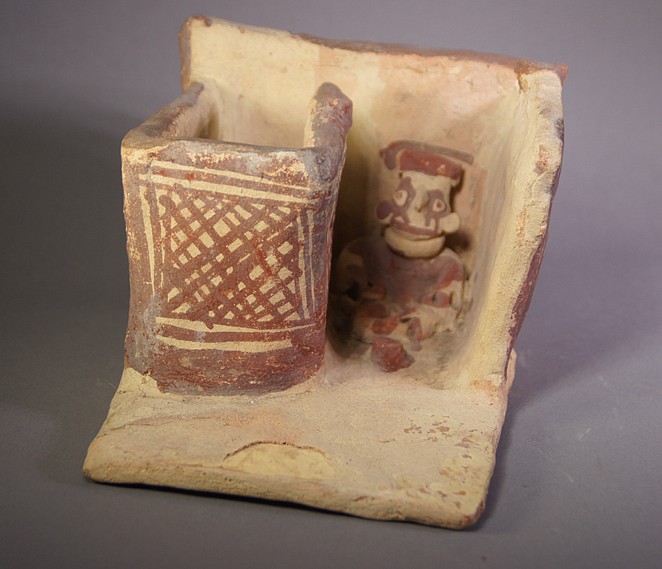




Peru, Chancay House with Seated Man in Two Room Interior
This ceramic piece represents the interior of a house. The inside is divided into two alcoves. One alcove is enclosed on three sides, with a crosshatch pattern on the exterior, and the other is open to expose a seated man facing outward. He sits with an open vessel in front of him. The two outside walls are higher than the ones inside.
Media: Ceramic
Dimensions: Length, 7 2/8 in, width 4 12/16 in, height 4 in.
Price Upon Request
92237
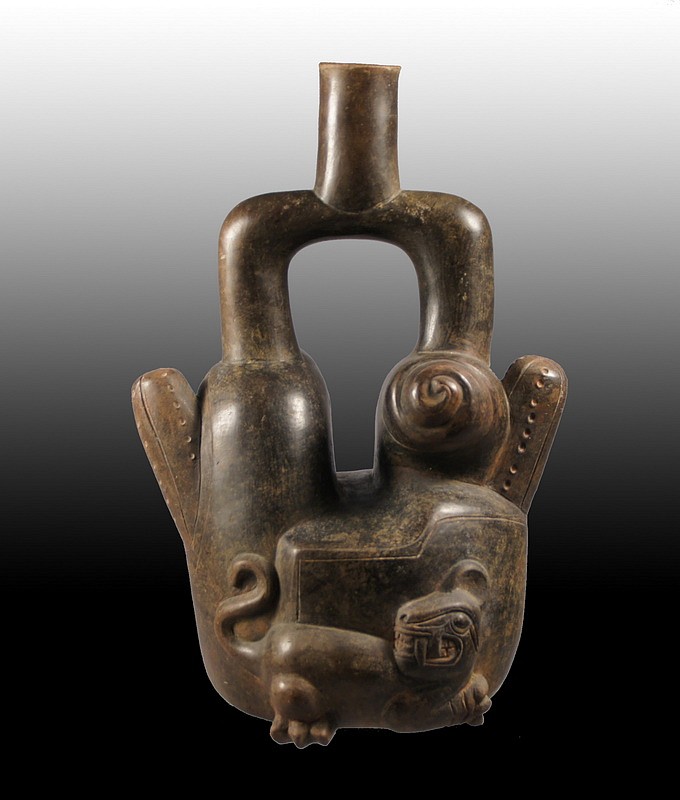







Peru, Chavin Ceramic Depicting a Recumbant Jaguar With San Pedro Cactus
On each side of the vessel there is a jaguar lying outside of a structure which is possibly a cave or a temple. A San Pedro Cactus is aside a Strombus shell; both have strong symbolic meaning for the Chavin feline cult. As the largest and the most -feared terrestrial carnivore in the Amazon, the jaguar serves as a natural symbol of raw aggression. Chavin shamans respected the jaguar for its nocturnal hunting skills and its ability to swim and climb into the forest, ruling earth, water and sky as their domain. Literary references of the same motif appear in The British Museum, The American Museum of Natural History, The Munson-Proctor Institute in Utica, and The Larco Herrera Collection at the Museo Nacional de Antropologia y Arqueologia in Lima.
Media: Ceramic
Dimensions: Height 10 3/4"
Price Upon Request
n2059
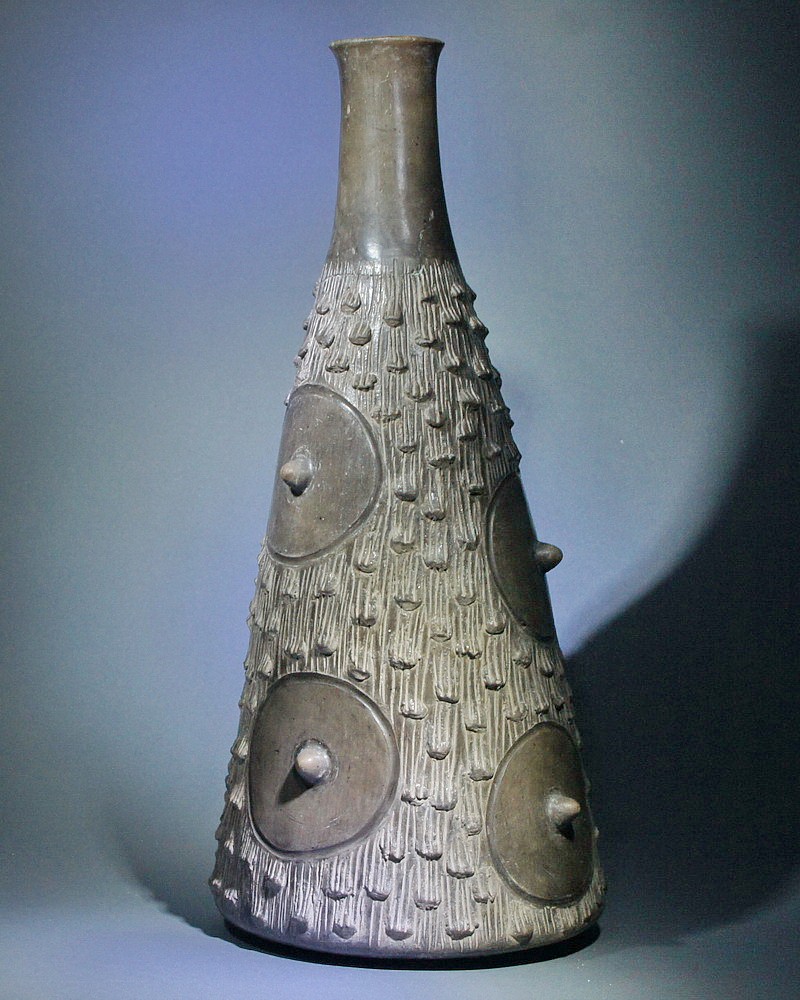
Peru, Chavin Cupisnique Style of a San Pedro Cactus
Vessel with long body, long spout, and concentric circular ornaments. Similar examples to be found in "Chavin Perus Geheimnisvoller Anden-Tempel" on page 285, and 359. Vessels like these were not usually made to destroy but to serve as vehicles for transporting the Chavin Cult. The surface area is highly burnished and original. The vessel is large for its type.
Media: Ceramic
Dimensions: Height 13"
Price Upon Request
n2058
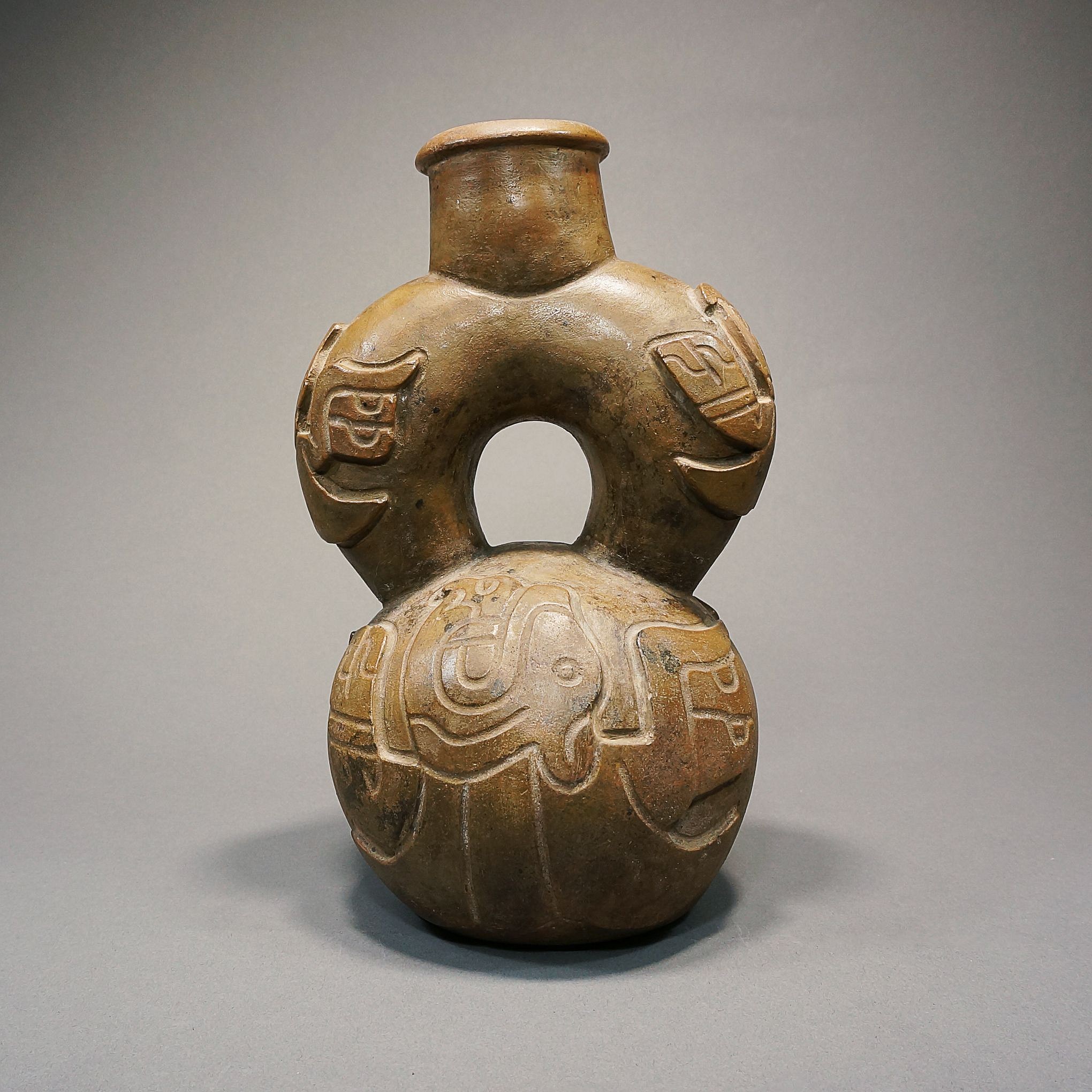
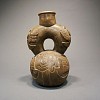

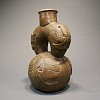
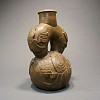
Peru, Chavin Cupisnique Style Stirrup spout Vessel Decorated with a Harpy Eagle.
Media: Ceramic
Dimensions: Height: 8"
Price Upon Request
n2067
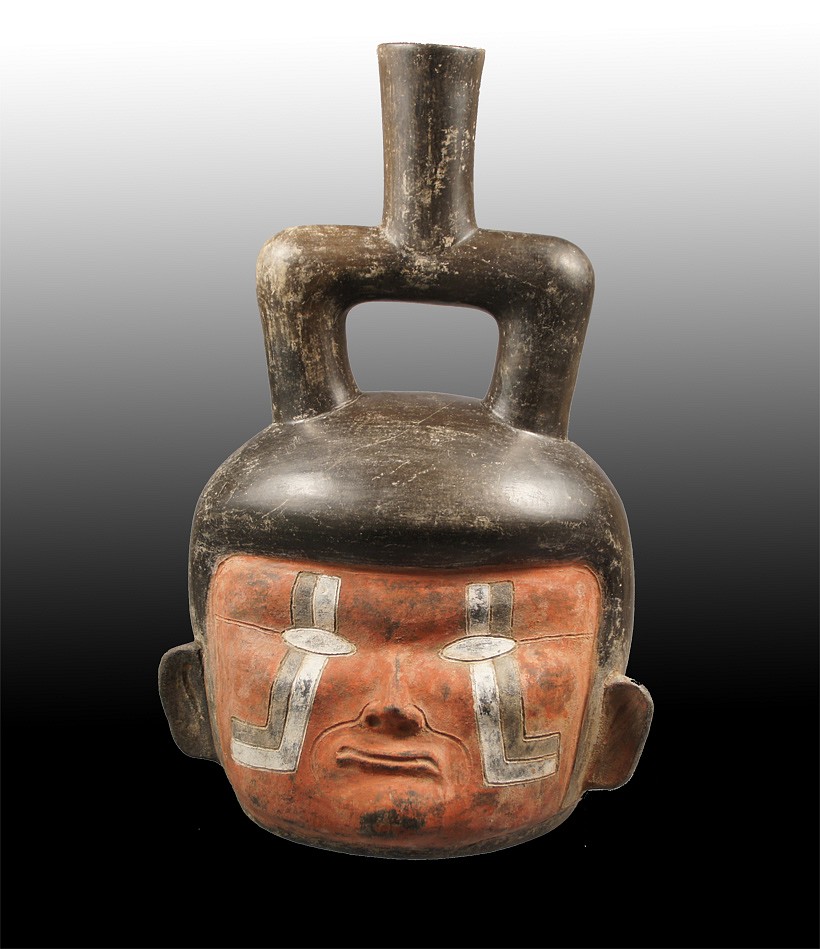
Peru, Chavin Stirrup Spout Portrait Vessel with Red Face and White Tears
There are few published, authenticated, Chavin ceramic portrait heads and this is the only known one of its kind with post -fire red and white pigment. The face has an unusually sensitive expression and delicately incised black and white tears that radiate outwards. There is a similar Chavin portrait vessel in the Linden Museum- Stuttgardt. Another Chavin portrait in the Larco collection and illustrated in THE SPIRIT OF ANCIENT PERU (pg.81) also has similar facial features: small ears, slanted eyes, small nose and thin lips - but in addition also has wrinkles. Author Richard Burger identifies this portrait as an elderly person. It is possible that the red-faced portrait is also a depiction of the same person that the Cupisnique people may have revered.
Media: Ceramic
Dimensions: Height 12 3/8" x Width 8"
Price Upon Request
n2108
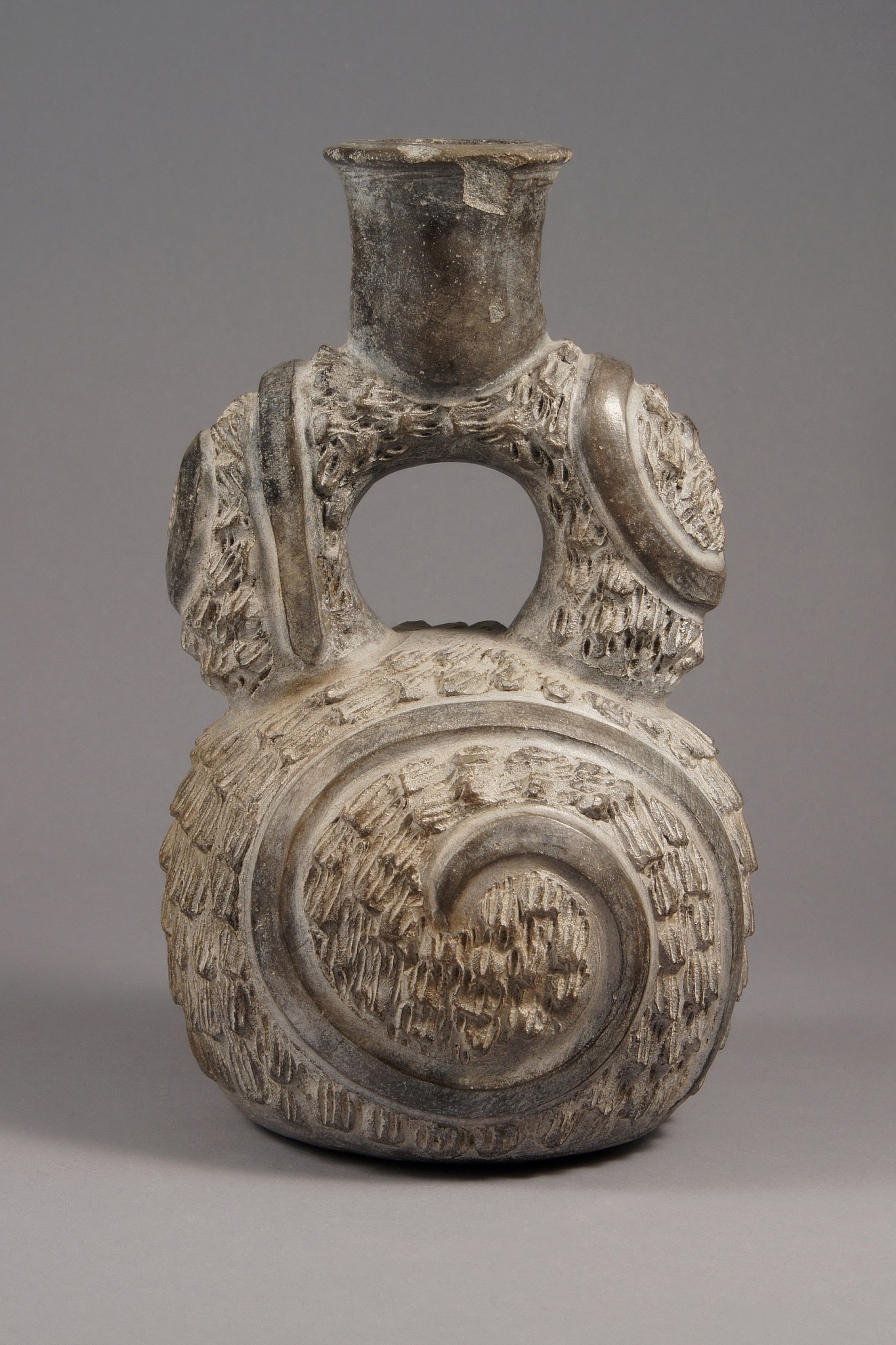






Peru, Chavin Stirrup Spout Vessel
This is an early and characteristic vessel from Cupisnique in the north coast of Peru, including the spiral design and comb texturing. A similar one is illustated in Donnan, "Ceramics of Ancient Peru" (1992: 29).
Media: Ceramic
Dimensions: Height 9"
Price Upon Request
M5044
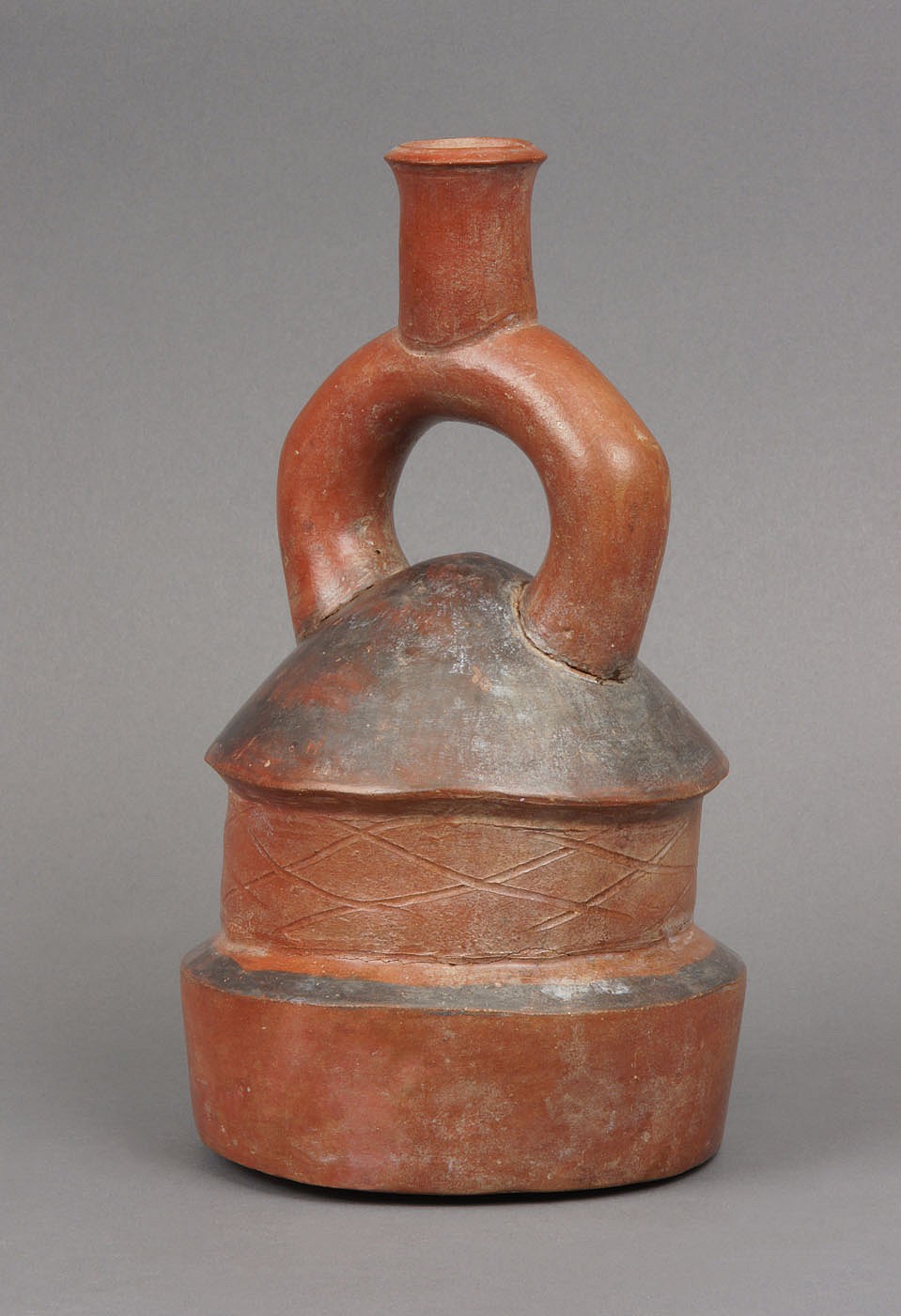
Peru, Chavin Stirrup Spout Vessel in the Form of a House
An unusual architectural motif of a round house which could have been a temple or ceremonial center. Round stone burial towers are found in the early Tiwanaku culture. This may have been what they were seeing and influenced their designs in Boliva.
Media: Ceramic
Dimensions: H. 9 in.
$7,500
92082
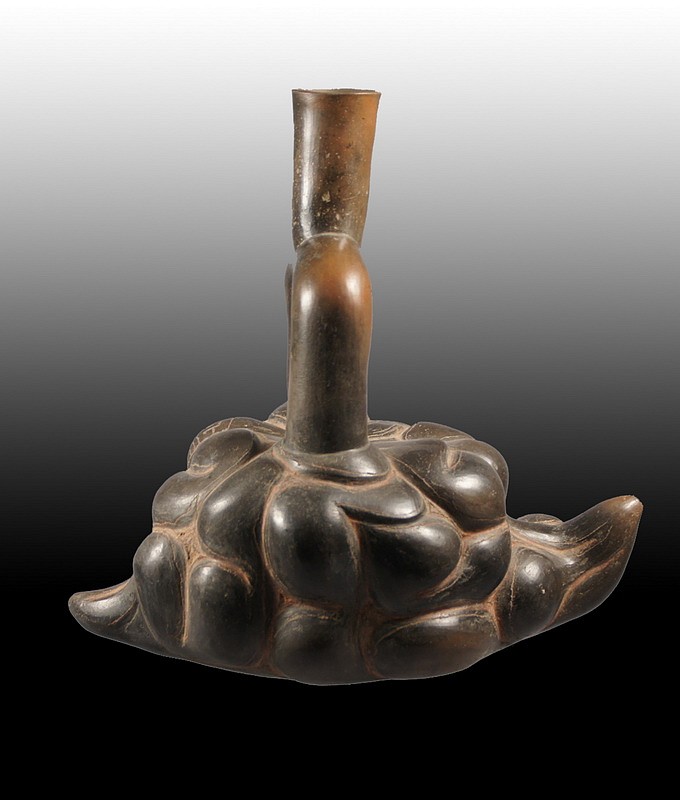
Peru, Chavin Stirrup Spout Vessel in the form of the Pijuayo Fruit
This Chavin Stirrup Spout Vessel has been shaped to mimic a ripe branch of Pijuayo (Peach Palm) fruits. Each individual fruit is red and semi-circular. It was mainly eaten after boiling in salt water for two hours, and has the taste and texture of a chestnut. Ancient Peruvians placed high value on the fruits and vegetables that surrounded them. To express this admiration of the transcendence that the plants in their daily life had, they often made works of art in tribute to them and the gods that made them. Similar fruit inspired vessels to this one are found in "Plantas Alimenticias en el Antiguo Peru" from pages 145 - 160; 1985. The peach palm was especially revered for its hard wood, which was used to carve spears. (The Ethnobotany of Pre-Columbian Peru pg. 28,1961).
Media: Ceramic
Dimensions: Length: 10" Height: 9"
Price Upon Request
n2096
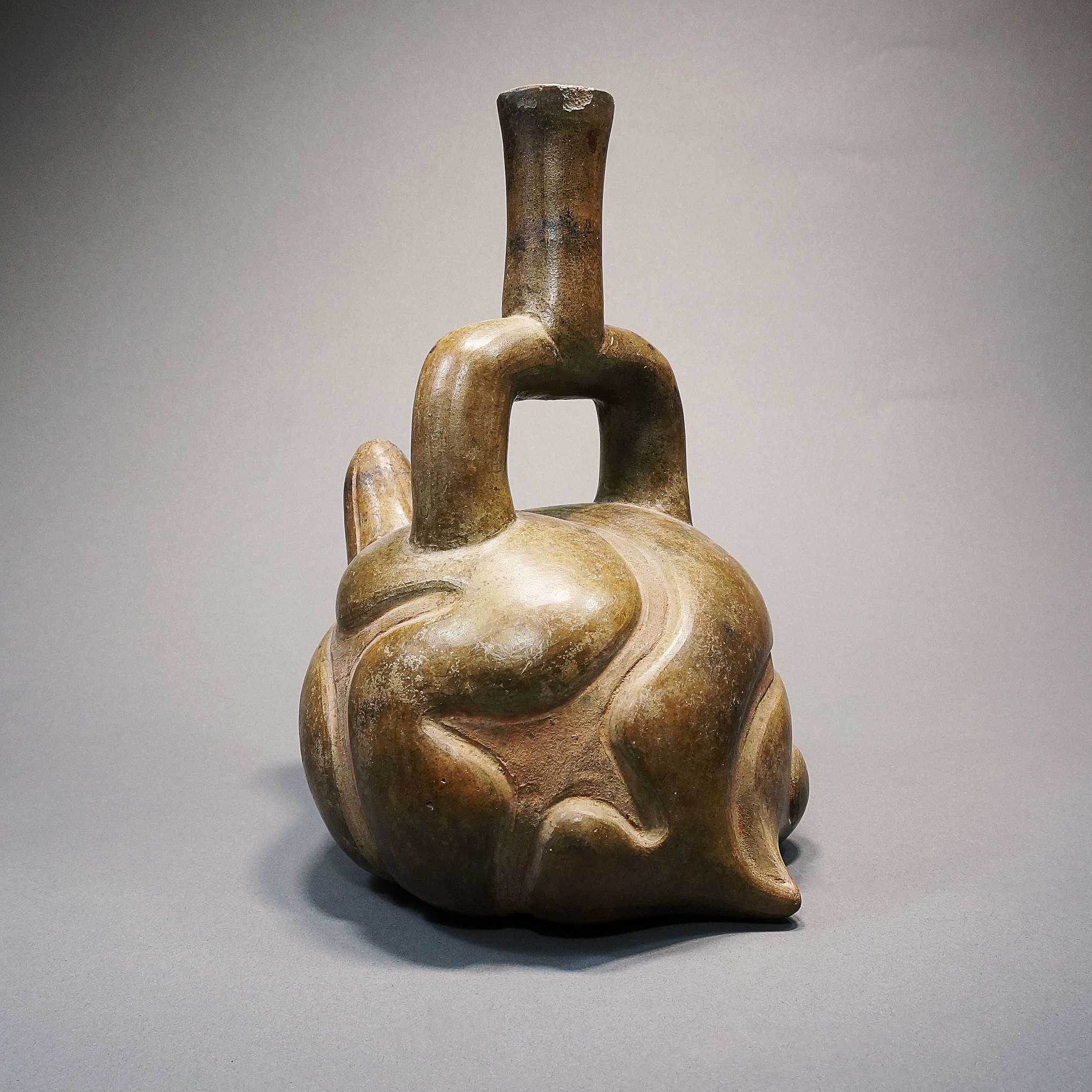
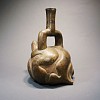
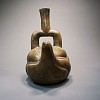
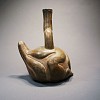
Peru, Chavin Tembladera Style Stirrup Spout Brownware Vessel in the form of an Abstract Animal
Media: Ceramic
Dimensions: Height 9 1/4"
$8,500
n2056
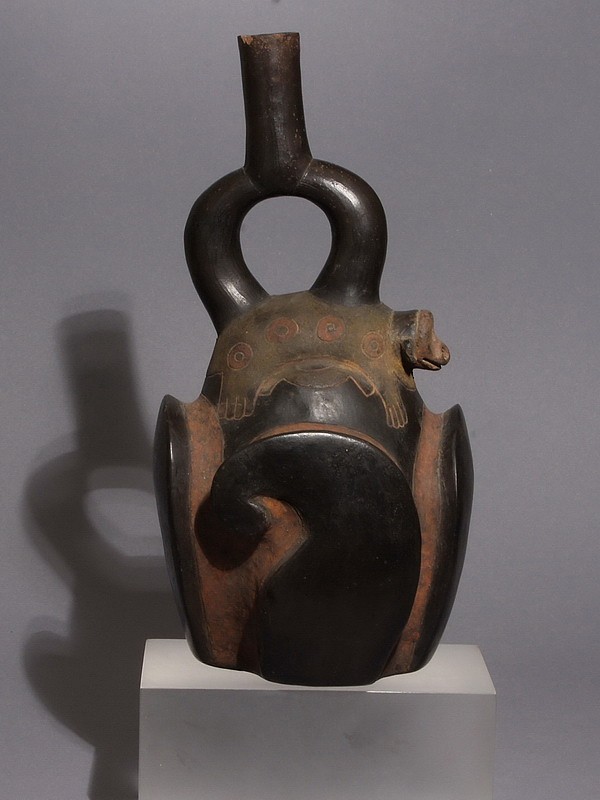
Peru, Chavin Tembladera Style Stirrup Spout Vessel Decorated with Sea Lion Deity
The animal appears to a splayed sea lion with flippers. The animal deity at the top is in a protective posture, as if birthing or protecting its young. All four sides are decorated with a wave-like element in high relief
Media: Ceramic
Dimensions: Height 9 1/4"
Price Upon Request
n2055
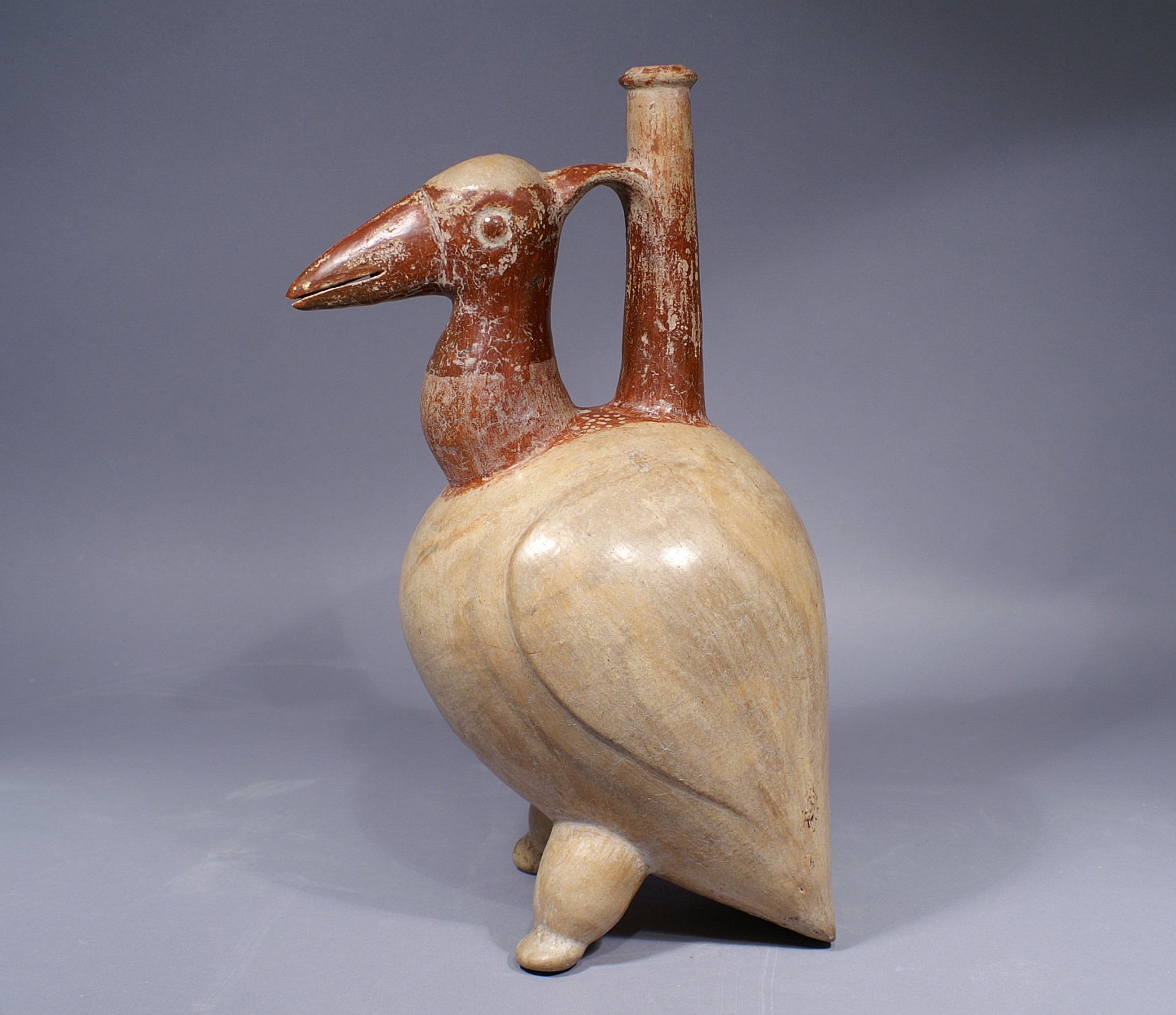



Ecuador, Chorrera Avian Effigy Spouted Vessel of a pelican
This effigy vessel represents a pelican decorated with red-brown slip on the head and neck over a buff body. The wings are softly modeled at the sides of the body, while the tail and quasi human feet support the vessel in a vertical position. Anthropomorphic effigy bottles with tall spouts are one of the hallmarks of Chorrera art, and may have been for high-status beverages for chiefs and shamans, probably alcoholic brews laced with hallucinogenic ingredients. They were also placed in tombs as offerings for the dead. The characteristic tall spout was almost certainly for the manipulation of liquid, and its slender height would have prevented spillage. A nearly identical vessel is published in Klein and Cevallos, eds., "Ecuador: The Secret Art of Precolumbian Ecuador" (2007: pl. 46). This pelican is slightly taller at 13 3/4" inches, and his head is turned 90 degrees, but the artist painted the head and feet in the same red-brown over a buff body with modeled wings.
Media: Ceramic
Dimensions: Height 12 1/2"
Price Upon Request
94295
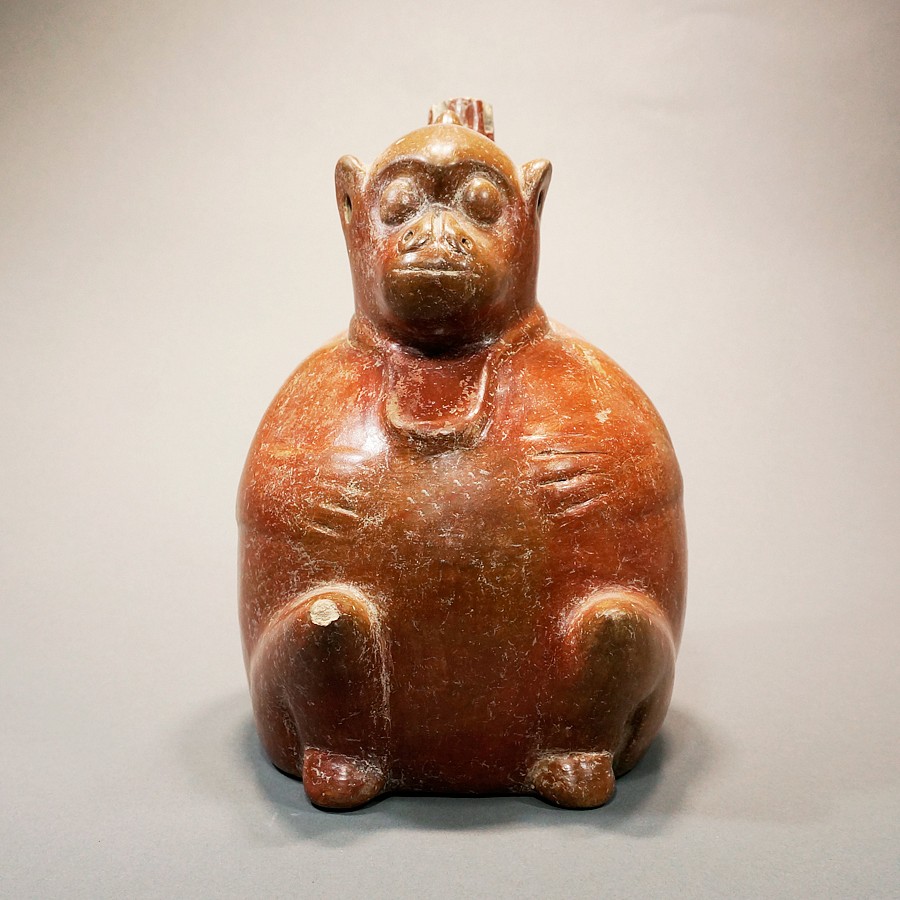
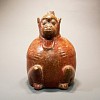
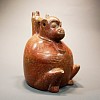
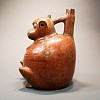
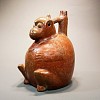
Ecuador, Chorrera Ceramic Baboon
Red brown bridge spout vessel of a baboon effigy with hands on chest and wearing a pendant. A similar example is illustrated in Valdez and Veintimilla, "Ameridian Signs: 5000 Years of Precolumbian Art in Ecuador" (1992: 54. The Chorrera culture, along with the Moche of Peru, were the only Andean societies to produce realistic ceramics at a very high level.
Media: Ceramic
Dimensions: Height 8.1/4"
$15,000
94008
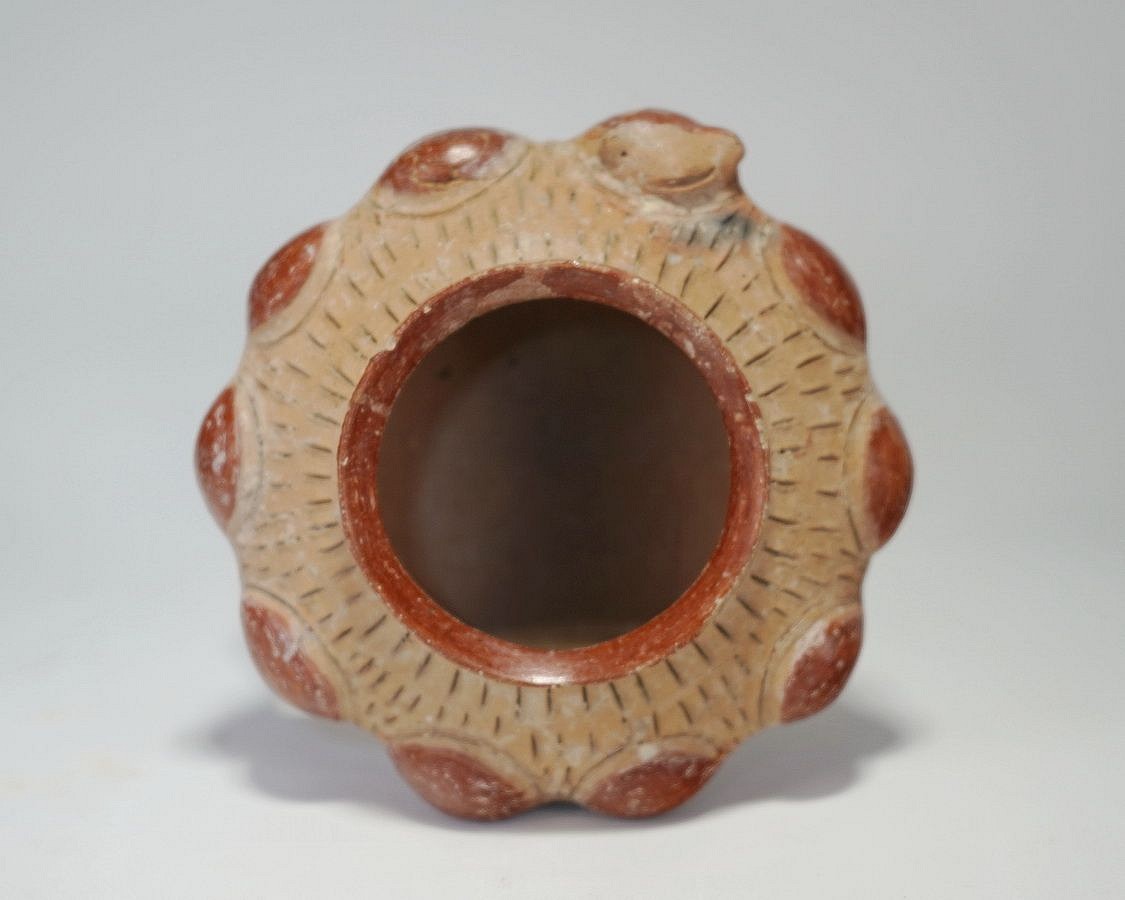




Ecuador, Classic Chorrera Miniature Bowl
This vessel is decorated with a circular ring of heads. This style of vessel is known as a meeting themed vessel. One head faces forward and the others appear to be in trance. Dimensions: Height: 2 1/2" x Diameter: 4 1/2"
Media: Ceramic
Dimensions: "
Price Upon Request
M6016
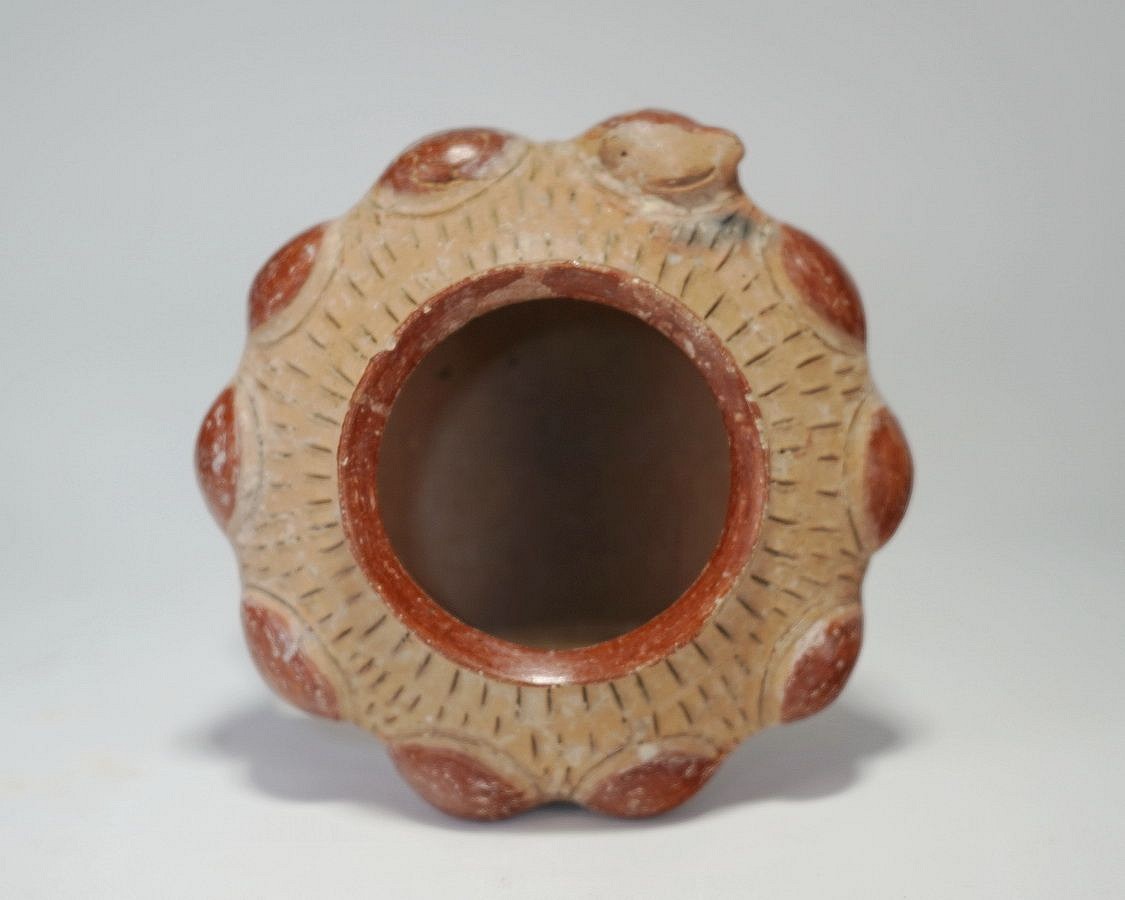





Ecuador, Classic Chorrera Miniature Bowl
This vessel is decorated with a circular ring of heads. This style of vessel is known as a meeting themed vessel. One head faces forward and the others appear to be in trance.
Media: Ceramic
Dimensions: Height: 2.5" x Diameter: 4.5"
$1,500
m6106
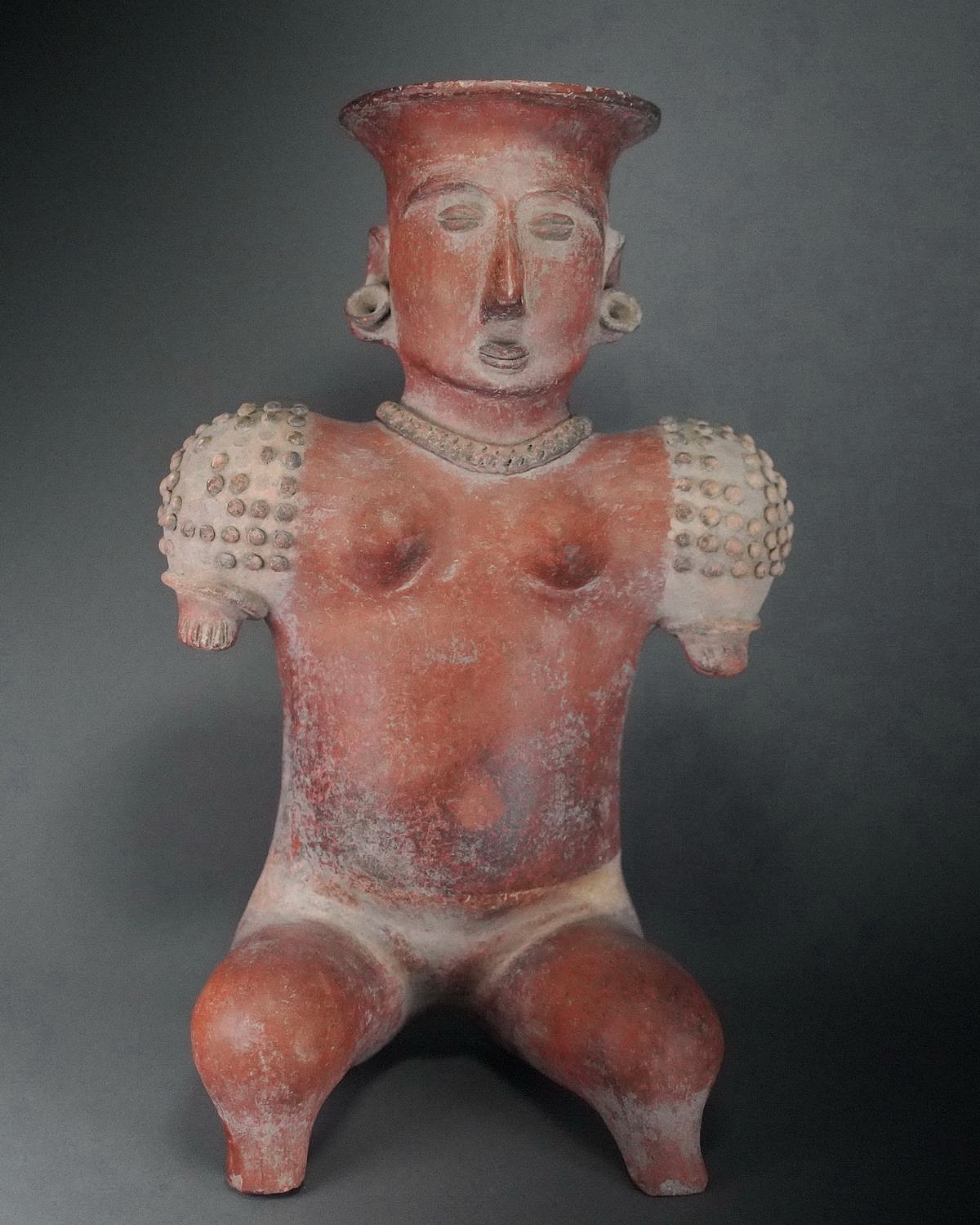




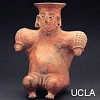

Mexico, Colima Seated Ceramic Sculpture of a Female
This seated female wears a necklace and earspools. She is adorned with shoulder pellets and has short arms that end with stubs in place of hands. The pellets may represent armor intended as protection for a person with short arms. Female figures in Pre-Columbia may have been linked to concepts of the earth and fertility and are thought to represent initiated women ready for marriage and childbirth. Usually, these figures appear to be disengaged from daily life. Similar style Coahuanyana Valley figures are in the collection of the Fowler Museum at UCLA, and The Arizona State Museum of Natural History. Ex-collection Hiroshi Miura, Tokyo, Japan acquired prior to 1970's.
Media: Ceramic
Dimensions: Height: 15.5"(38cm) x Width: 10"(22cm)
Price Upon Request
p1055
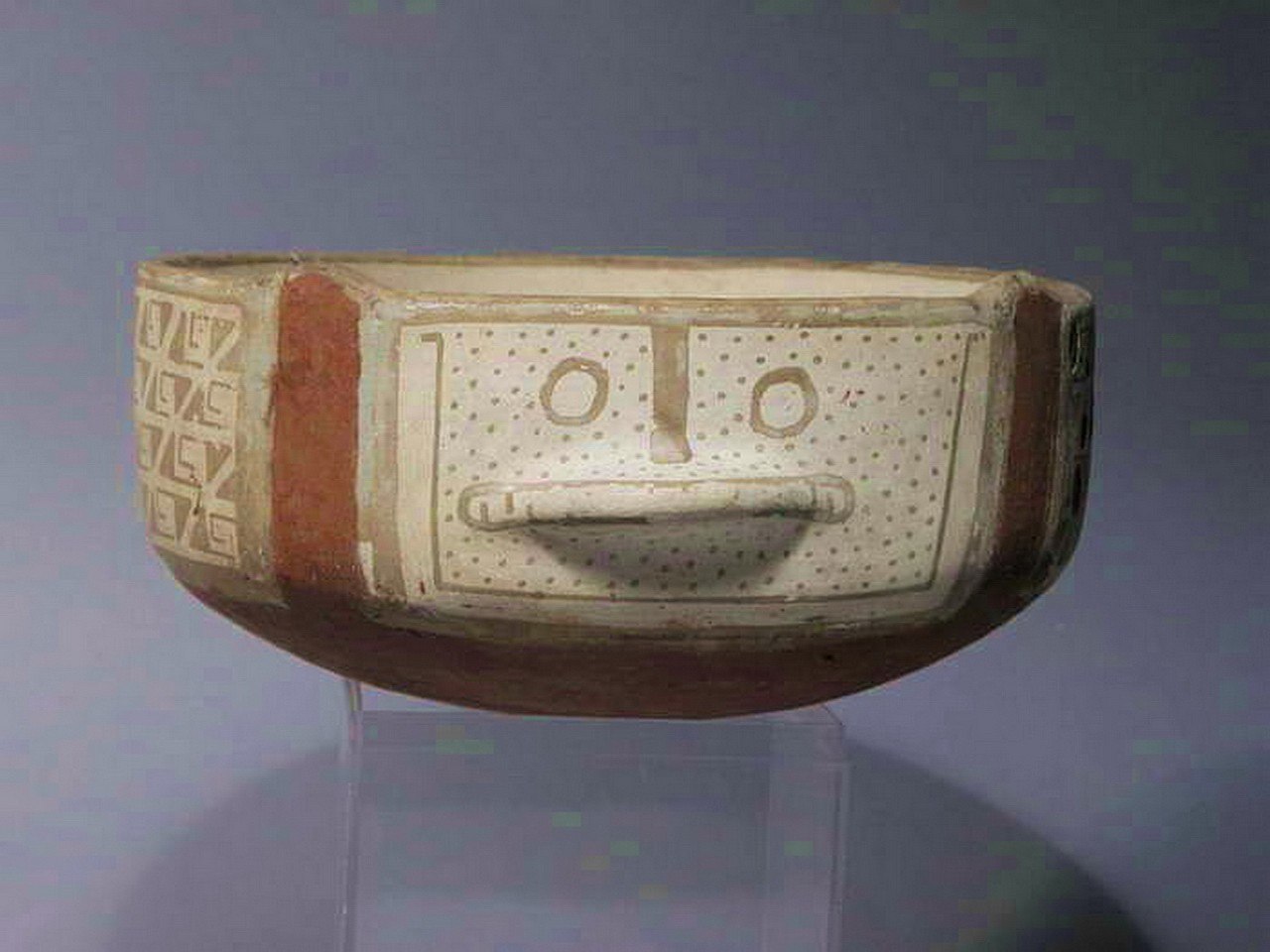
Chile, Diaguita Phase II Shallow Bowl with Animal Face and Step Frets
This second phase Diaguita bowl exhibits a ornithomorph with a protruding mouth and a small protrubance in the rear. The high outer walls are decorated with a band of repeating step fret symbols. A similar bowl is illustrated in "Chile Indigena, Museo Arqueologico De Santiago,Chile," pl. 76.
Media: Ceramic
Dimensions: Diameter 7" x Height 3 1/2"
Price Upon Request
M3143
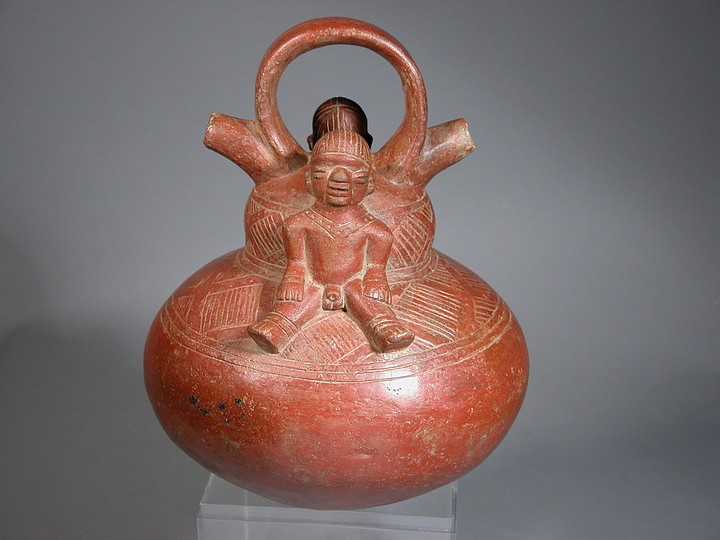
Colombia, Early Calima Alcarazza with male and female figures
A couple are seated back to back on an early form of this "alcarazza" vessel type, which was characteristic of Calima ceramics from Colombia. The globular body, modeled figures and incised decoration were typical of the earliest "Llama" phase of Calima pottery. Later examples of alcarazzas are less globular, with multi-chambered bodies, and vessels tend to be smaller. See Cardale de Schrimpff et. al., "Calima: Diez mil anos de historia en el suroccidente de Colombia" (1992) and Armand Labbé, "Colombia Before Columbus: The People, Culture, and Ceramic Art of Prehispanic Colombia" (1986).
Media: Ceramic
Dimensions: Height 8 1/4"
$4,500
M4053
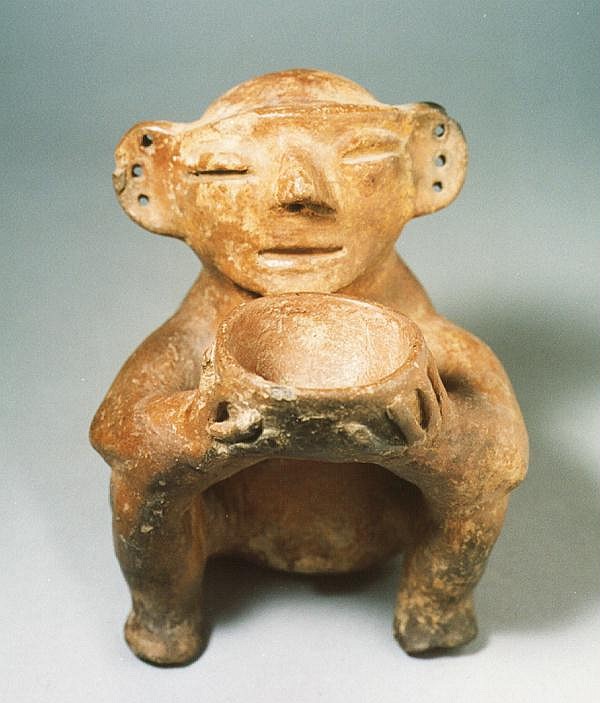
Ecuador, Ecuadorian Ceramic Seated Figure Holding a Bowl
This beautifully serene, meditative figure, perhaps a shaman, is seated in a restive position and offering a bowl. This bowl was perhaps used to inhale tobacco smoke or for drinking a ritual alcoholic or psychedelic libation. The historical record of the ancient Andes indicates shamanic use of mind-altering substances for religious rituals. A similar example is illustrated in
Meggers Evan’s Archeological Investigations on The Rio Napo.
Media: Ceramic
Price Upon Request
88203
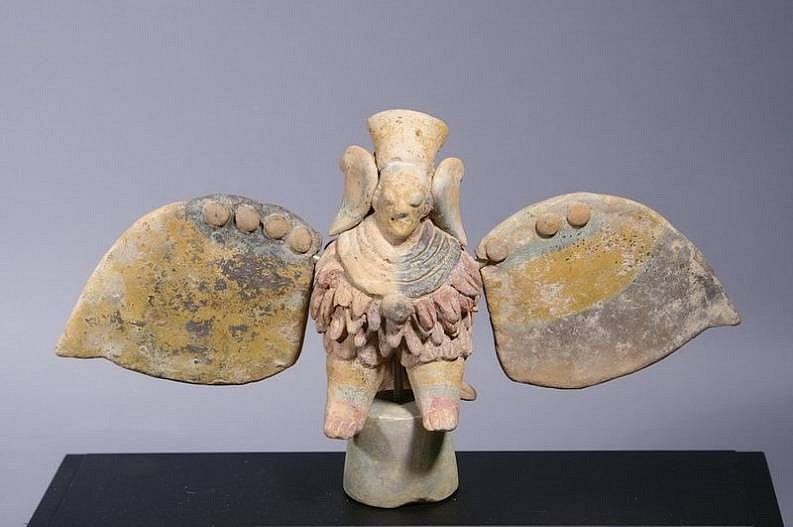



Ecuador, Guangala Bird Transformation Figure with detachable wings
This figure represents a shaman in a trance and envisioning himself turned into a bird that could fly to the otherworld to communicate with ancestors and spirits. He is wearing a feather poncho, detachable wings, and the back of the figure has a bird's rounded body and tail. The base elevates the figure off the ground as if he were actually flying. On the front of the figure there are traces of post-fire blue and yellow pigments.
Media: Ceramic
Dimensions: Height: 5" x Width: 10" with wings
$4,500
M7090
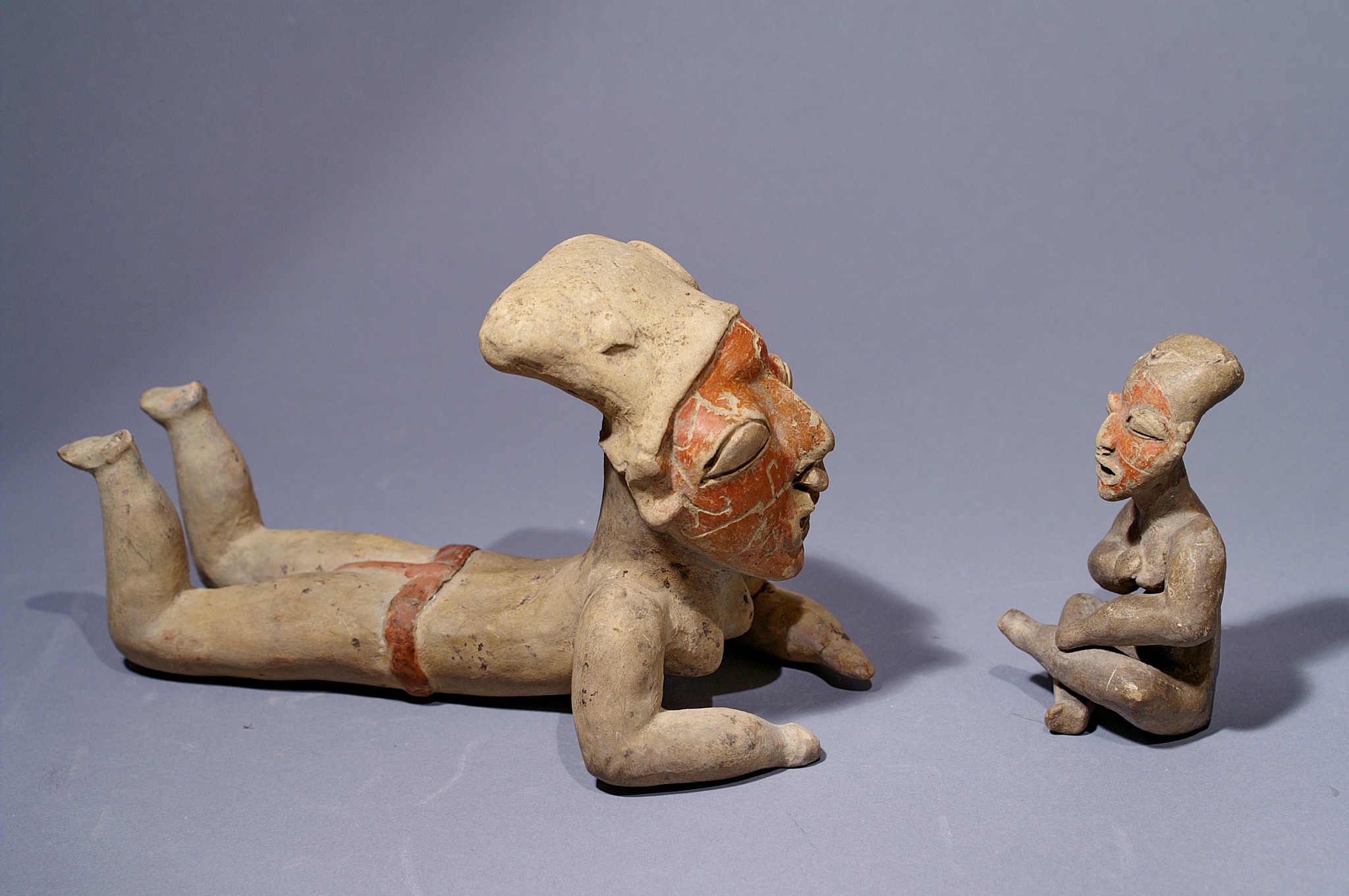




Ecuador, Guangala Pair of Female Figures, one lying down and one seated with hand to breast
The prone position of the larger female may have been borrowed from the neighboring Jamacoaque, but the facial incisions are typical of Guangala figures. The smaller seated female is similarly marked with carved facial designs. Guangala ceramics are unique in the northern coast for incising such markings on pottery figurines.
Media: Ceramic
Dimensions: Height: 7 3/4" lying down, 3 3/4" seated
$12,000
M7089
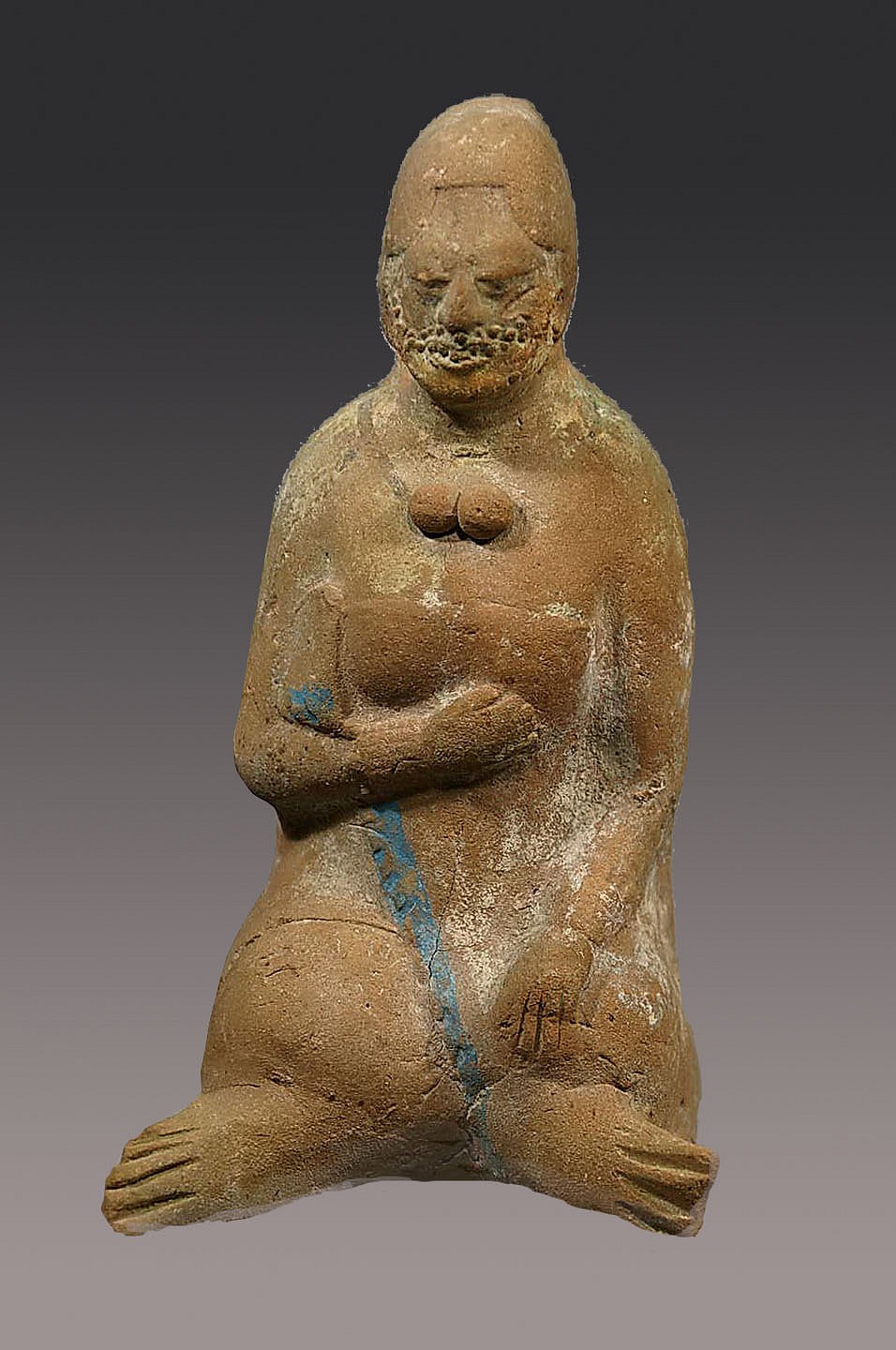



Mexico, Jaina Ceramic Efiigy Whistle of a Seated Woman
This cast ceramic whistle depicts a lady with a tattooed face, holding her hand to her breast. Post-fire blue pigment outlines the edge of her huipil, which was knotted on the upper right side of her chest.
Mold-cast figurines are thought to be later than solid hand modeled examples. Jaina Island, off the coast of Yucatan, was used as a cemetery for high-ranking nobles from the mainland.
Media: Ceramic
Dimensions: Height: 7"
Condition: With a minor chip on the right foot.
Price Upon Request
88167
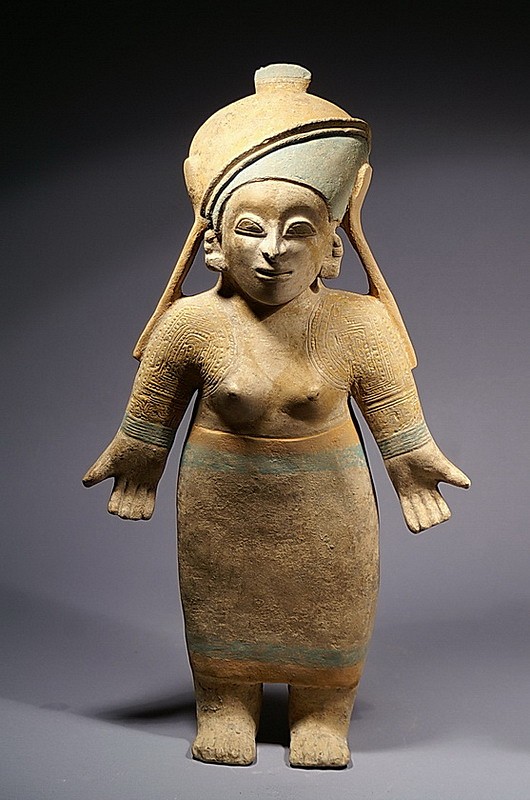







Ecuador, Jama Qoaque Large Standing Queen Figure with Hands Held Out
The queen is wearing an elaborate hair style and with rich ornamentation. The figurine is standing in a hierarchical pose with traces of aquamarine pigment and a highly burnished short sleeve blouse. The arms are fully tattooed. a sign of high status. Besides the traditional ear and nose ornaments and libret. The queen is wearing a set of necklaces and has ornamented sleeves. This is one of the largest examples for the style as most of the other large examples are less than 40cm. A closely related figure with the same sleeve decoration is from the Cruz DePerone Collection, Quito and illustrated in Amerindian signs, fig 80.1. The condition is good with cracks in back of the neck in shoulders restored. All parts are original.
Media: Ceramic
Dimensions: Height 17.5"( 44cm) x Width 11.5"(29cm)
Price Upon Request
M9020
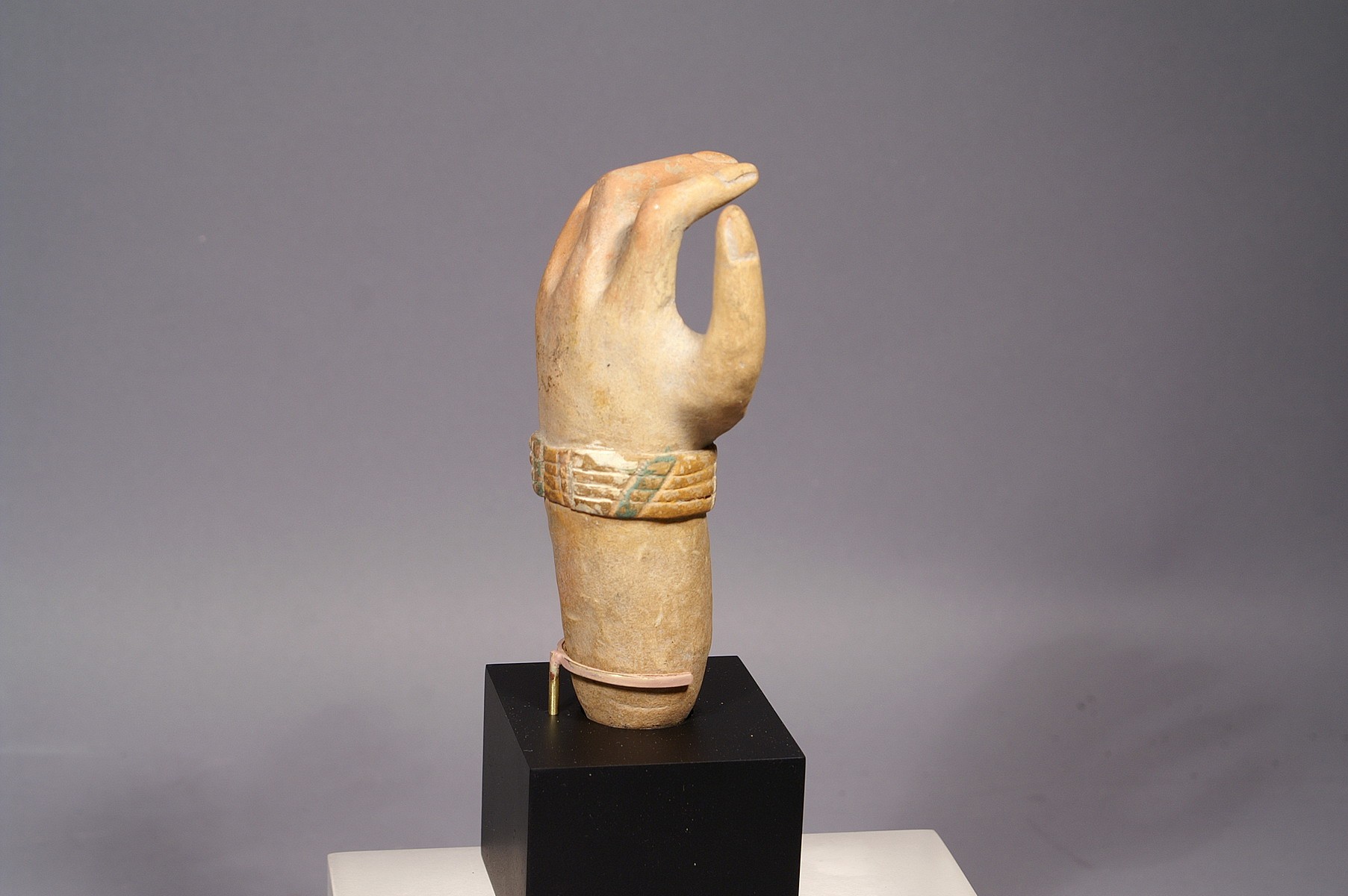





Ecuador, Jama-Coaque Ceramic Hand
This is a lovely small sculpture by itself, but the wrist has a drilled hole which suggests that it was originally part of an articulated ceramic figure.
Media: Ceramic
Dimensions: Length: 6"
Price Upon Request
M7164
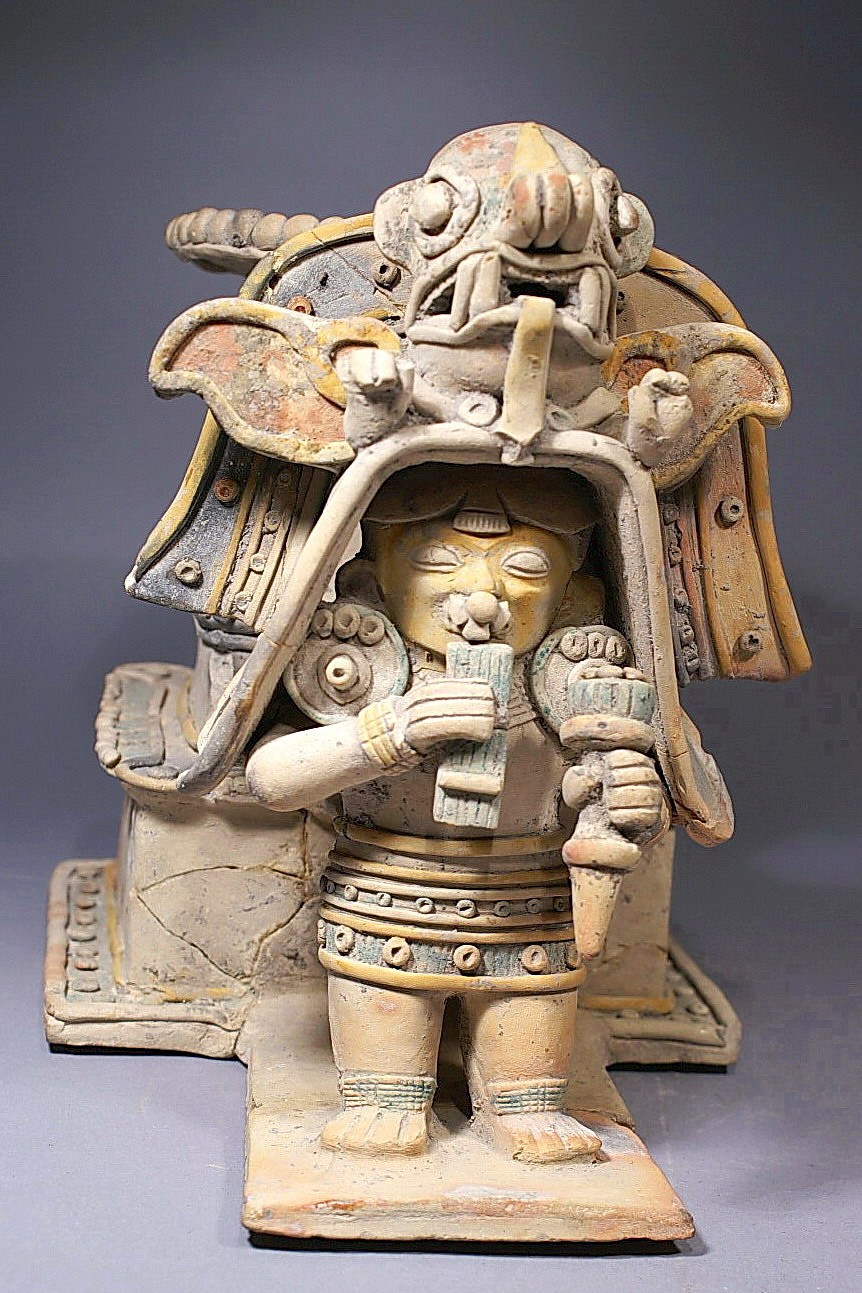




Ecuador, Jama-coaque Temple Scene with priest playing a flute
The priest is in full regalia with a spectacular headdress. He is playing a flute and shaking a rattle as if dancing in front of the temple behind him. This structure is an elaborate three tier temple with a high altar and delicate details. Traces of the original post-fire pigments are intact over the entire work in hues of blue, red and yellow. The only other temple from this early period is in the Banco Central (Quito, Ecuador). The authencity of the work has been confirmed through a series of X-ray scans by Dr. Marc Ghysels (Tomodensitometric Analysis 2007).
Media: Ceramic
Dimensions: Length 10.5" x Height 9"
$29,500
M6012
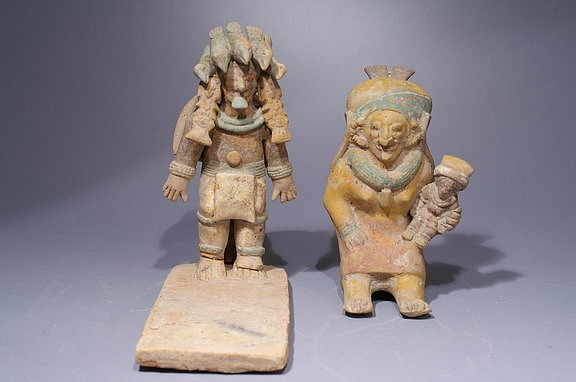
Ecuador, Jamacoaque Platform with priest and woman holding a small figure
This scene had a figure which was knocked off the platform and lost in antiquity. The female substitute included here represents the same type as the original. The Jamacoaque seem to have taken over centers occupied by the preceding Chorrera culture in the northern Guayas region of coastal Ecuador. The pottery of Jamacoaque potters focuses on the costumes and accessories of ritual and prestige worn by high-ranking men and women. There is precedent for this female figure in the Chorrera sequence, in which a woman appears to be holding a child, but on closer inspection, the baby is really a small man. Here, the small male wears a complete adult costume, including turban headdress, large necklace, bracelets and ligatures on his legs. He's a supernatural miniature rather than a human baby. There was a tradition in the nineteenth century among the inhabitants of Guayas of a female statue with a small figurine in her lap, kept in a temple on an island just off the coast (Valdez, "Ameridian Signs: 5.000 Years of Precolumbian Art in Ecuador," 1992: 68). Local natives visited the shrine bringing gold and silver body parts which they offered in order to cure the diseased or maimed. Such curing rites may be the scenario of the platform group presented here. The male is elaborately dressed as a chief or shaman with heavy jewelry, long earrings designed as fish, an array of birds on top of his headgear, and behind him, is his semicircular staff.
Media: Ceramic
Dimensions: Height: 6 3/4"
Price Upon Request
M7040
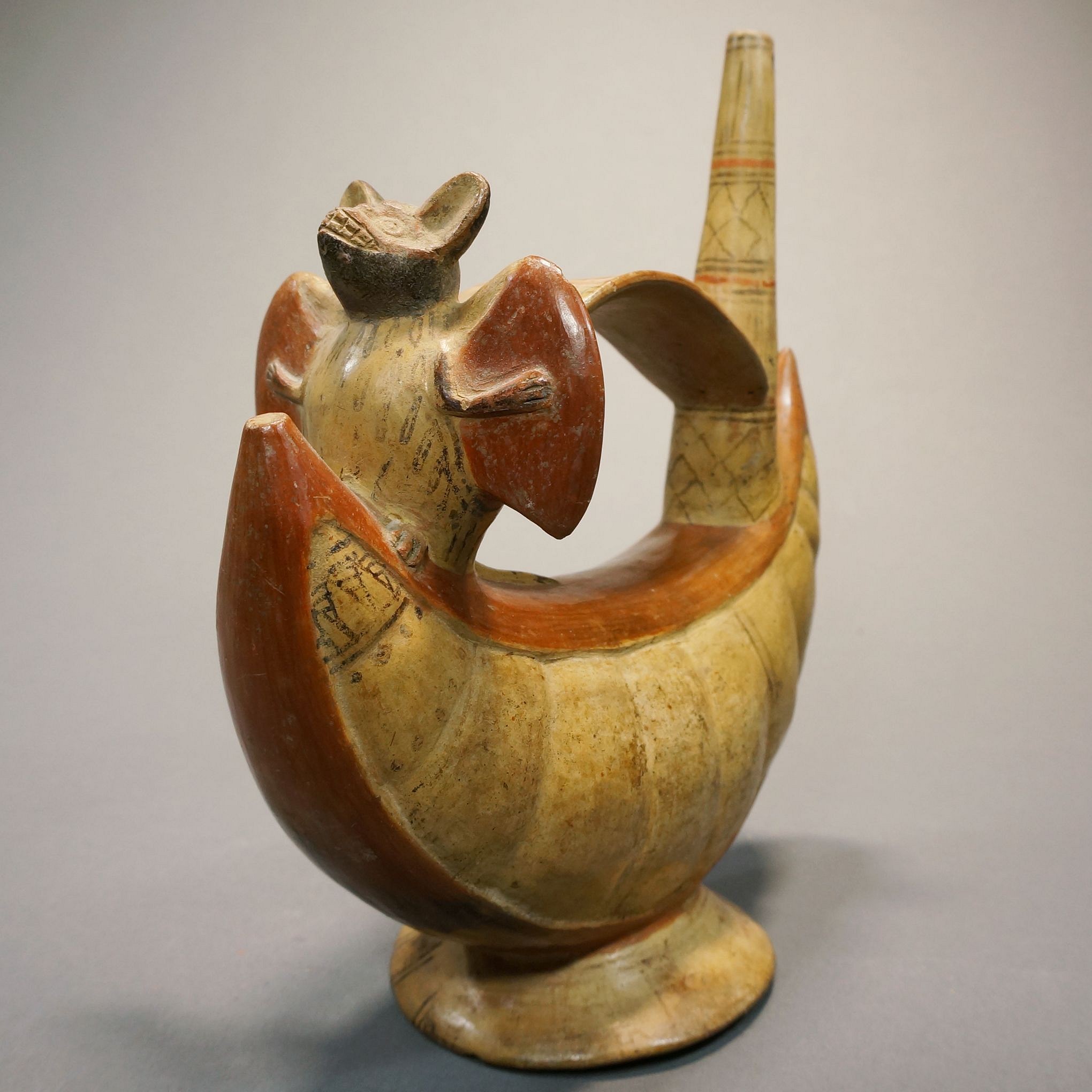
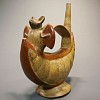
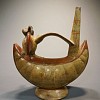
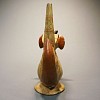
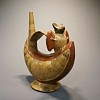
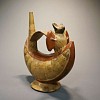
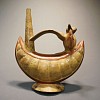
Peru, Lambayeque Whistling Vessel with Bat Atop Pacay Fruit
This ceramic bridge-spout whistling effigy vessel was crafted in the shape of fruit bat resting atop a Pacay. The Pacay fruit, found in the Amazon, is related to mangoes and guavas. Fruit bats have an extremely good sense of smell and sharp teeth with which to open the tough skins of fruits. The whistle built into the vessel, customary for Lambayeque vessels, is seen just behind the bat. Bats are a rare motif and quite meaningful in ancient Andean mythology as they are associated with transport to other worlds. The vessel was painted with orange slip and black octopus ink on a buff ceramic ground. There are only two other known Lambayeque vessels with sculptures of bats, one is illustrated in "Ceramics of Ancient Peru" by Christopher Donnan, 1992, p.89, and the other is the property of The American Museum of Natural History.
Media: Ceramic
Dimensions: Height 8" x Length 6 1/2"
Price Upon Request
mm145
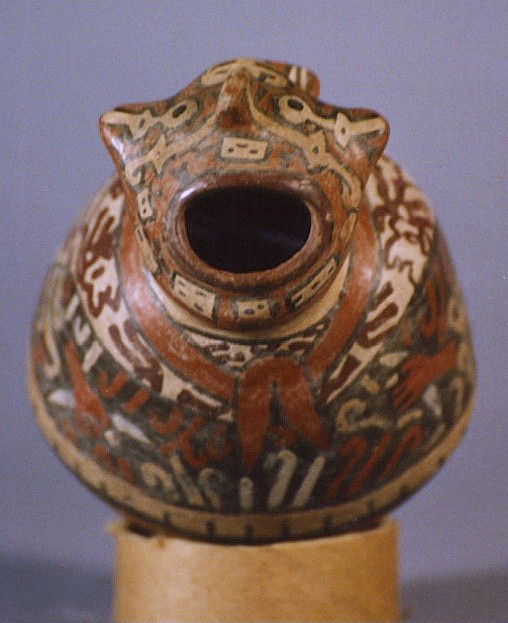







Peru, Late Nazca Ceramic Vessel in the form of a Howling Man
A very delicately modeled and painted miniature vessel of a howling man. The face can be read upside-down as well. Seen from right-side up, the figure appears to be wearing a tunic and cape decorated with abstract heads. From upside-down the tunic turns into a scarf, and the cape becomes the tunic. The face also changes according to the direction the object is seen from. The howling image is associated with decapitation and the trophy head ritual.
Media: Ceramic
Dimensions: Height: 4 1/4"
Price Upon Request
92037
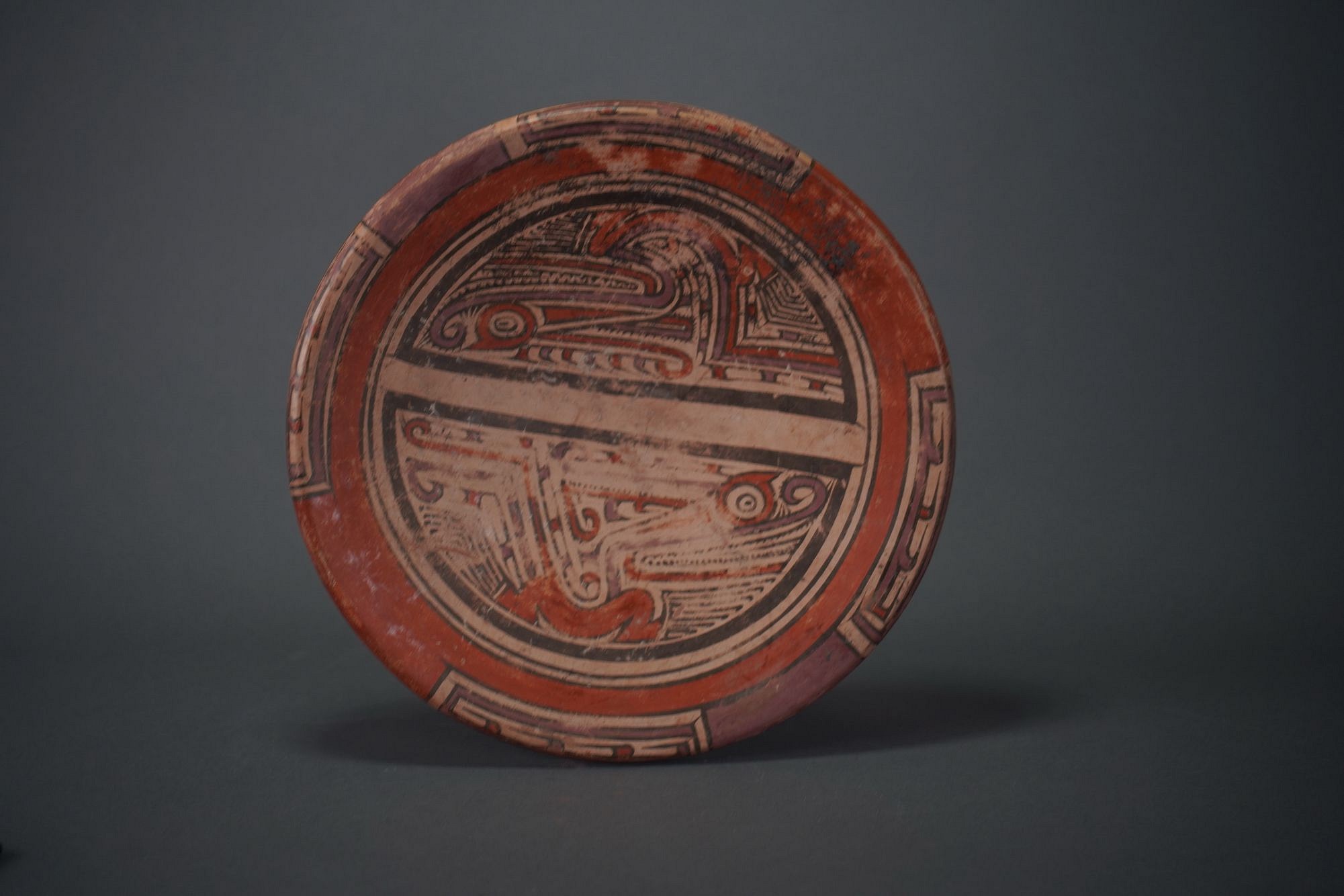



Panama, Macaracas Stye Ceramic Dish Decorated with Stylized Pair of Saurians
The Saurian figures appear in profile in opposite directions and are separated by a narrow band. Violet and red pigments are used to skillfully define the shapes of the creatures. The Saurian figures appear on the front, back, and sides of the dish. Similar saurian designs are illustrated in GUARDIANS OF THE LIFE STREAM by Armand Labbe, fig. 41. Ex- Los Angles collection.
Media: Ceramic
Dimensions: Diameter: 7 1/2"
$2,250
P1056
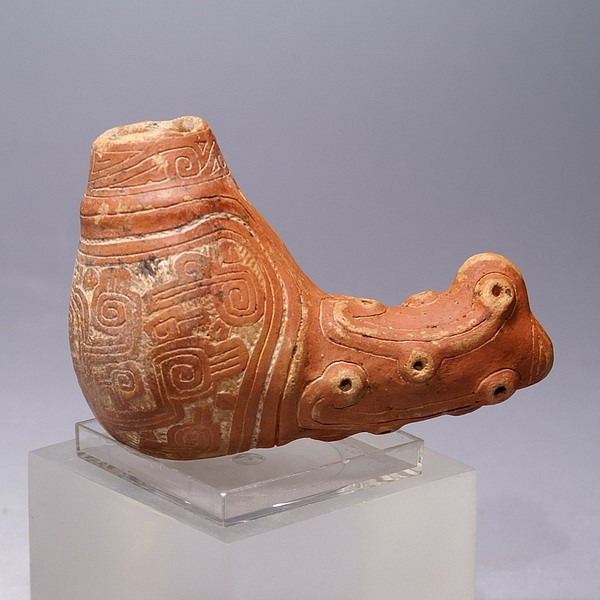





Brazil, Marajo Ceramic container in the form of a Mythical Cayman
These containers are highly valued because of the quality of artistry. They have a hole to tie a string through, either for suspension or to attach a cover. This vessel has a stylized Cayman's snout and finely incised designs depicting stylized birds’ heads on the chamber. Similar vessels illustrating a Cayman's head can be found in UNKNOWN AMAZON, on page 150 and in the catalog O MUSEU PARAENSE EMILIO GOELDI, on page 134.
Media: Ceramic
Dimensions: Length 4.4" x Height 3.1"
$3,800
N1056
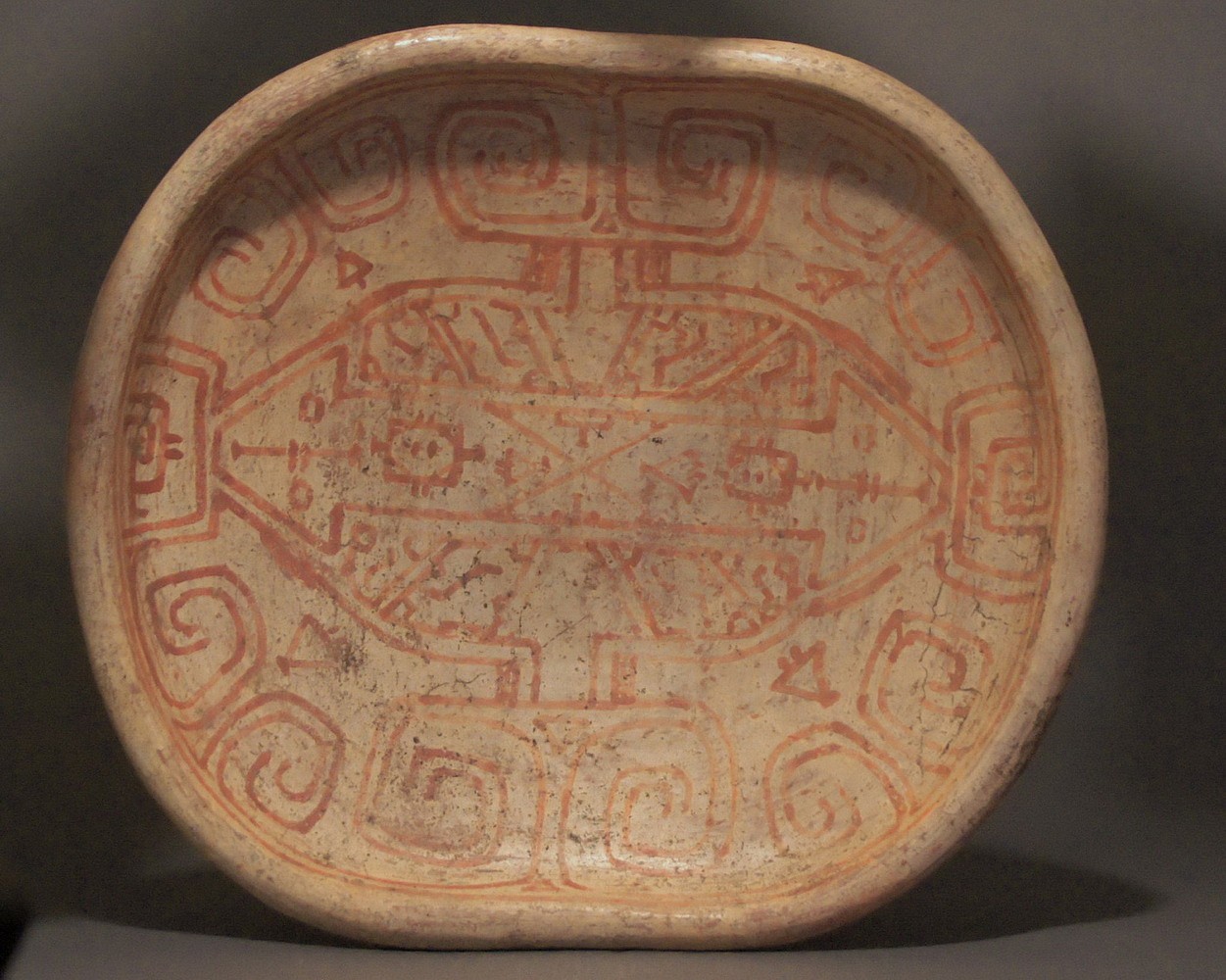





Brazil, Marajo Decorative Ceramic Painted Plate
This is a classic six-sided plate done in the Joannes Painted style with rolled rim. The inside surface is decorated with an abstract double-headed serpent in a reddish-brown slip. The plate has a slight curved shape and is in good condition.
Media: Ceramic
Dimensions: Length: 33 cm. x Width: 29 cm.
Price Upon Request
n3004
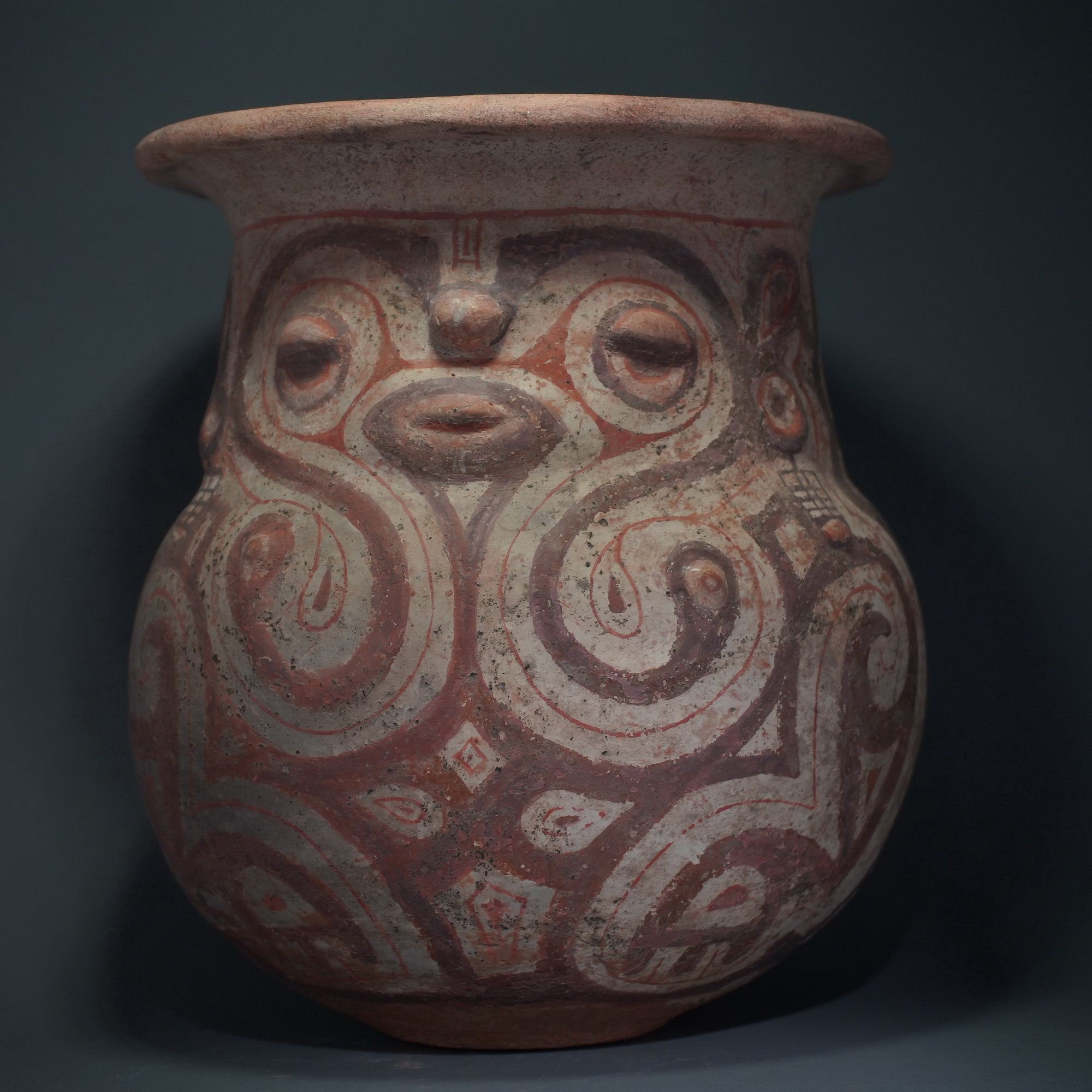
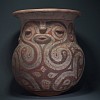


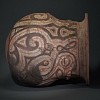



Brazil, Marajo Janus-Figure Burial Urn
The figure is wearing ear ornaments and has symmetrical serpents encircling the eyes, terminating on the body. Below is a pentangular Venus element. A similar vessel is illustrated in MARAJO-Ancient Ceramics from the Mouth of the Amazon, 2011, Denver, fig 75.
Ex-Collection Jean Lions Riode Janerio, Brazil circa 1970's.
Media: Ceramic
Dimensions: Height: 12 1/4"
$7,750
p1061
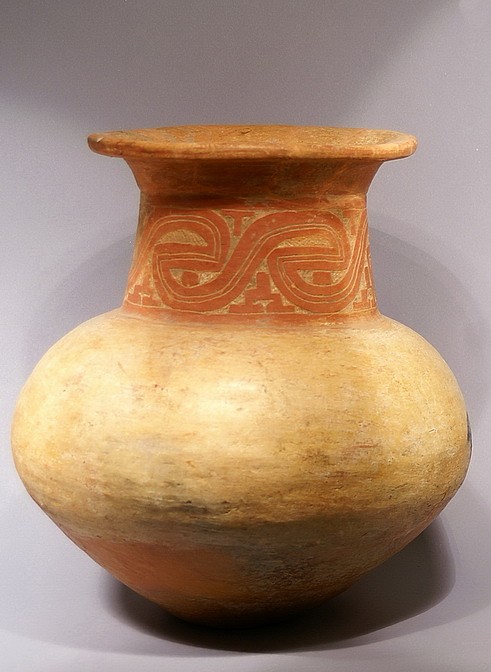
Brazil, Marajo large ceramic bichrome vessel with incised neck
This large ceremonial urn/vase is globular in form and tapers at the base. The neck is long and incised with a scroll pattern and fluted rim. The incised scroll design on the neck is a common motif in Marajoara art. Zoomorphic in character, theses scroll designs appear on the bodies of both humans and animals and on representations of clothing and furniture such as stools. Because of their similarity to painted patterns that have ritual significance in the art of remaining descendants of the culture, some interpretation of their symbolic significance can be reached. Sometimes they are referred to as "spirit" designs according to shamans who during drug induced trances report the appearance of these markings upon the bodies of ancestral spirit people. With the possible exception of certain elite groups, the Marajoara peoples tended not to decorate their common household objects. However, they took great care to elaborate objects of ceremonial function such as funerary urns used as receptacles for the remains of the deceased. Although the actual function of this vessel is not known with certainty, it is too sophisticated in both form and decoration to have been merely utilitarian, but too small to be used as a burial urn. It is reasonable to assume, however, that it was used in a feasting ceremony. This jar has a smudge stain from the firing process on one side. Several examples of similar style and iconography are illustrated and discussed by Anna C. Roosevelt in "Moundbuilders of the Amazon: Geophysical Archaeology on Marajo Island, Brazil", San Diego, Academic Press, Inc, 1991.
Media: Mixed Media
Dimensions: Height: 16"
$17,500
MM069
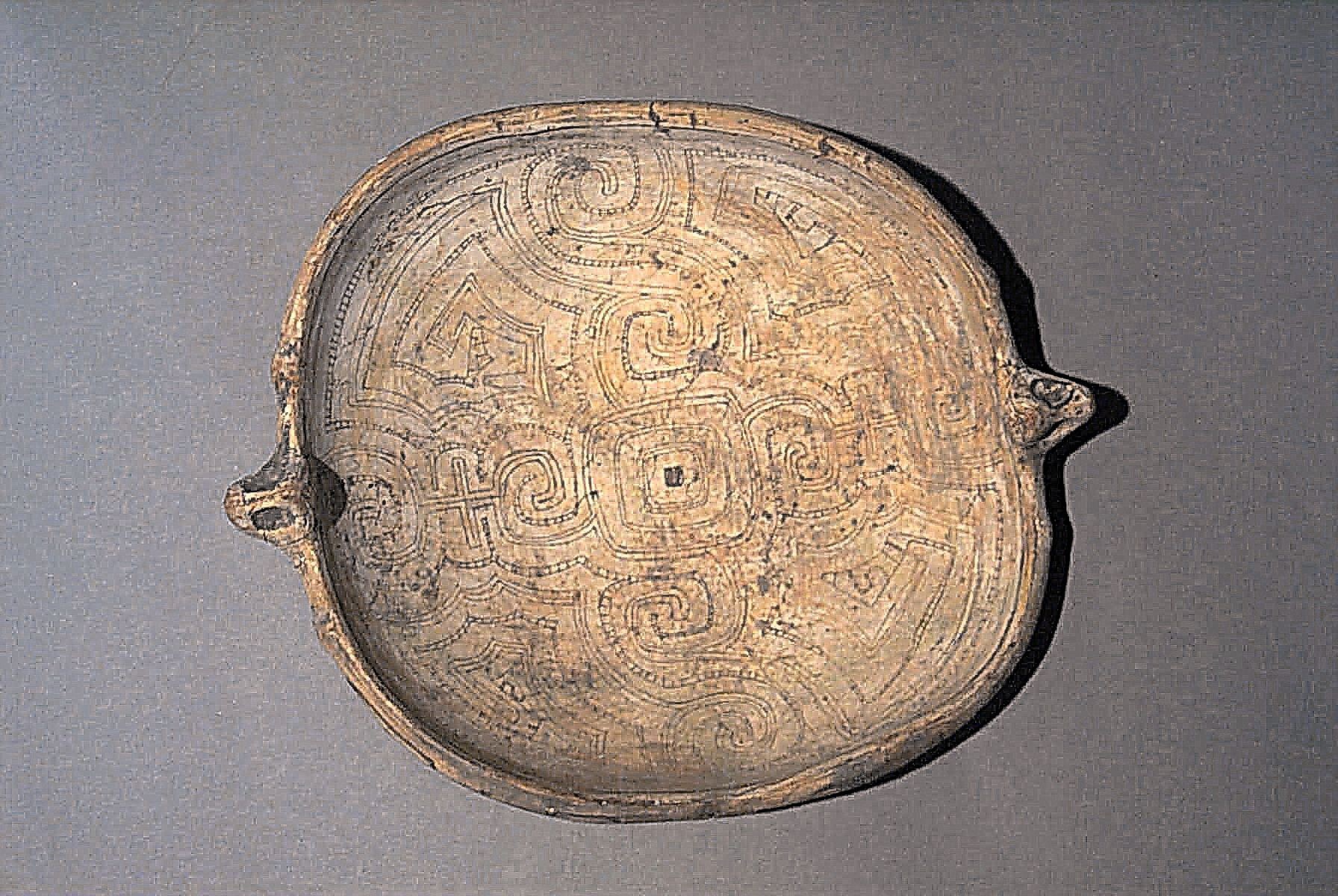




Brazil, Marajo Plate with incised geometric design and zoomorphic handles
Ceramic dish used for ceremonial offerings is decorated in buff color slip over incised geometric curvilinear designs on the interior and underside of the rim which is embellished by two zoomorphic adorno handles. The overall shape suggests a possible interpretation of a turtle, an animal motif that appears frequently in Marajo ceramics. The fineline incised geometric pattern that decorates the interior begins with a central theme of a square within the square which is surrounded by S-shaped scrolls, hooks and cruciform designs. These types of geometric motifs which occur exclusively on ceremonial vessels designate this as a very special dish. A combination of fine and wide incised geometric lines decorate the outer portion of the rim. The underside is plain orange-wear. The painted incised interior, a hold-over from earlier phases is consistent with the design work from early Taino ceramics of the Carribean. One example illustrating similar geometric design and incising technique can be seen in"O Museu Paraense Emilio Goeldi", Banco Safra, 1986, p. 133
Media: Ceramic
Dimensions: Length: 13" x Width: 10 1/4"
$9,500
99203
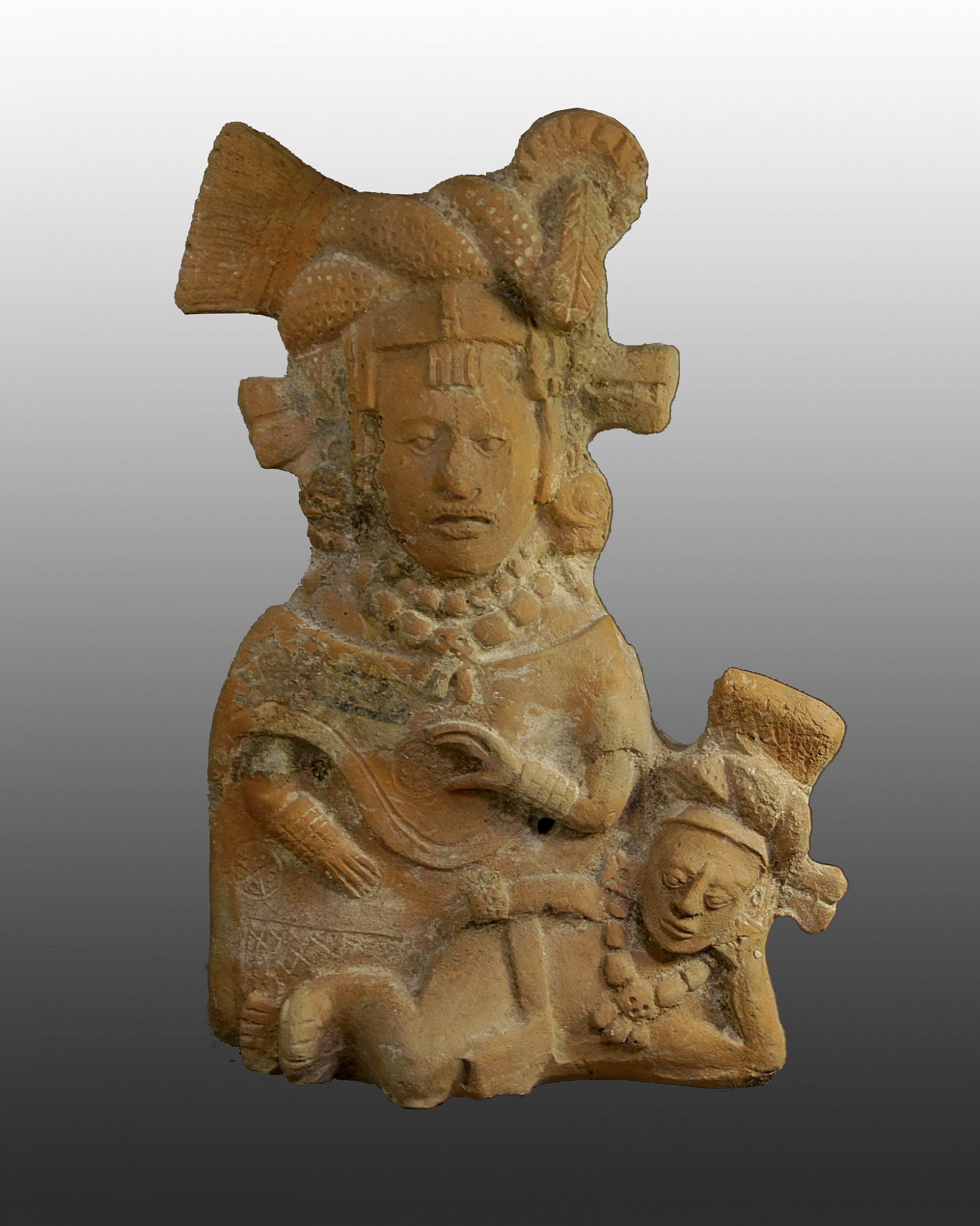





Mexico, Mayan Ceramic Figural Rattle of A Female Figure with Child
This high-ranking noble Jaina female wears a cloth and feather turban, ear spools, a heavy beaded collar piece and a slip-on quexquemitl over a skirt decorated with roundels and cross-hatching around the hem. Her face has a discreet scarification pattern in the center of the forehead and around the upper lip. The male child lying at her feet has a similar turban, beaded necklace, and a simple loincloth. Jaina-style figurines were exchanged along a 500 mile trade route. These figurines were hand-modeled with hollow, mold-made bodies, and joined to plain backs made by hand or molded. This figure can function as a whistle, flute, or rattle. For the Maya, enabling figurines to make sound animated them with the essence of life: air.
Media: Ceramic
Dimensions: Height: 8 1/2"
Price Upon Request
N6011
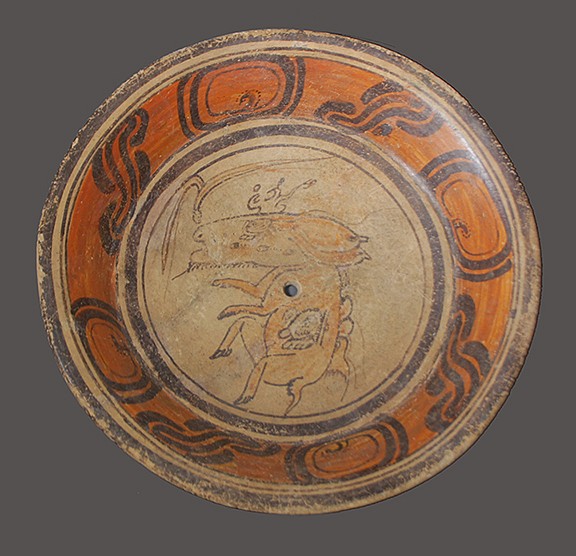



Guatemala, Mayan Ceramic Plate with Capybera and Glyphs
This beautiful plate features a Capybera, a giant rodent with an unusual large rectangular head that is native to South America. Cabyberas are highly social animals that inhabit dense forest areas and were hunted by the ancients as a meat source. There is a kill hole in the center of the plate above a glyph on the animal.
Media: Ceramic
Price Upon Request
N6013
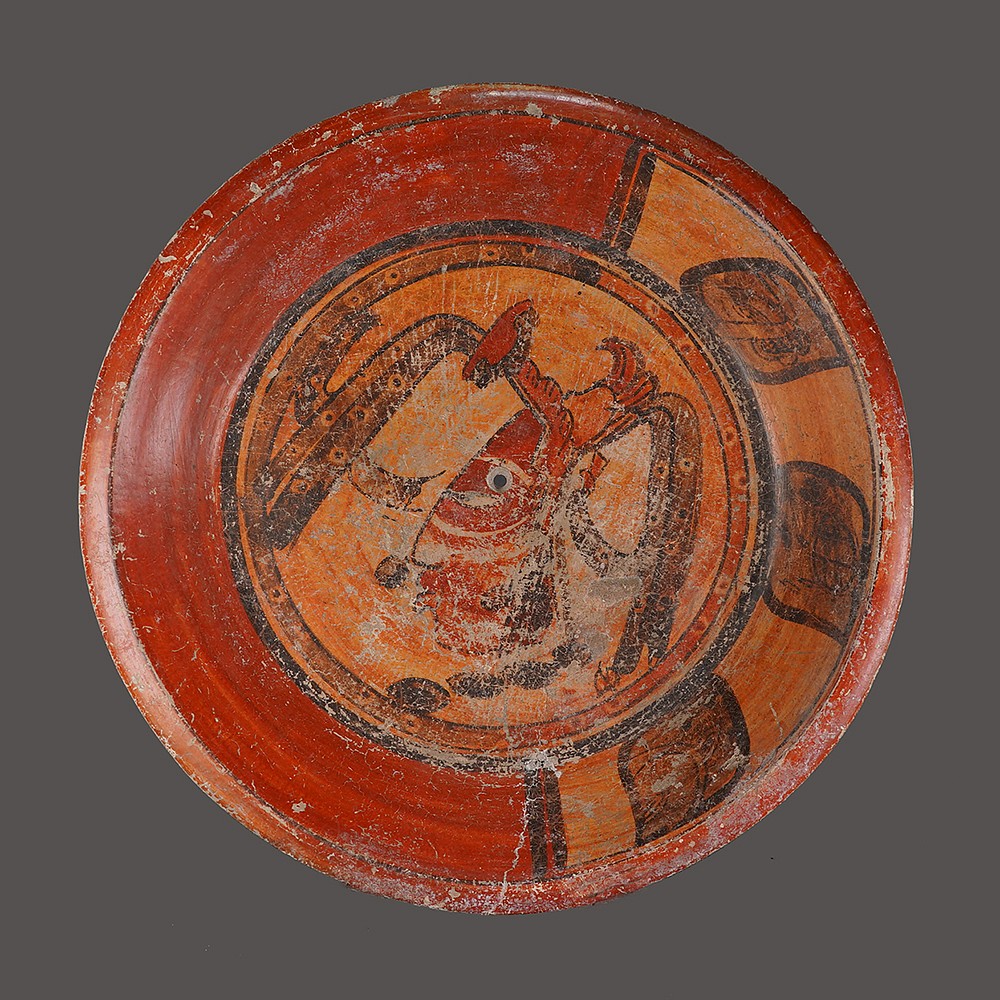
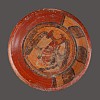


Guatemala, Mayan Ceramic Tripod Plate with Profile of a The Maize God Hun Hunaphu
The glyphs on this plate translate to LORD and the figure depicted is the Maize god Hun Hun Hunaphu. He is the father of the Hero Twins as told in the Maya creation myth, Popol Vuh. He can be identified by the extreme sloping forehead and tuft of hair on top of his head. He also wears a necklace with a pendant and elaborate ear ornaments. This plate has a "kill hole" above the eye, which was in the center of the plate. The plate was likely used to serve corn dumplings at a Mayan ritual feast. Private collection, acquired in Tokyo, Japan, prior to 1970.
Media: Ceramic
Dimensions: Diameter: 12" (30.5 cm) x Height: 3"(8 cm)
Price Upon Request
n6014
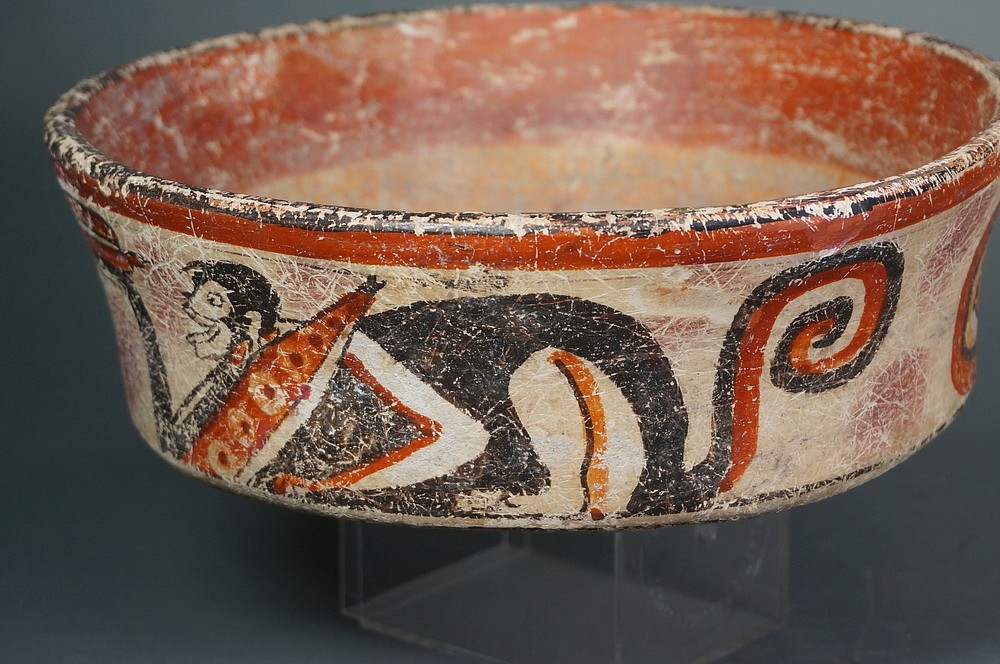





Guatemala, Mayan High Walled Dish with Repeating Monkey Motif
This dish features a repeating scene of monkey serving a dish featuring a cacao pod with seeds, followed by a glyph with the sound of O. It is likely that the monkey is serving a chocolate dish; chocolate was revered by the Mayans as a life-giving substance. The bottom is attractively painted with a typical Mayan brush design.
Media: Ceramic
Dimensions: Height: 2.5" x Diameter: 7.25"
$6,000
n5050
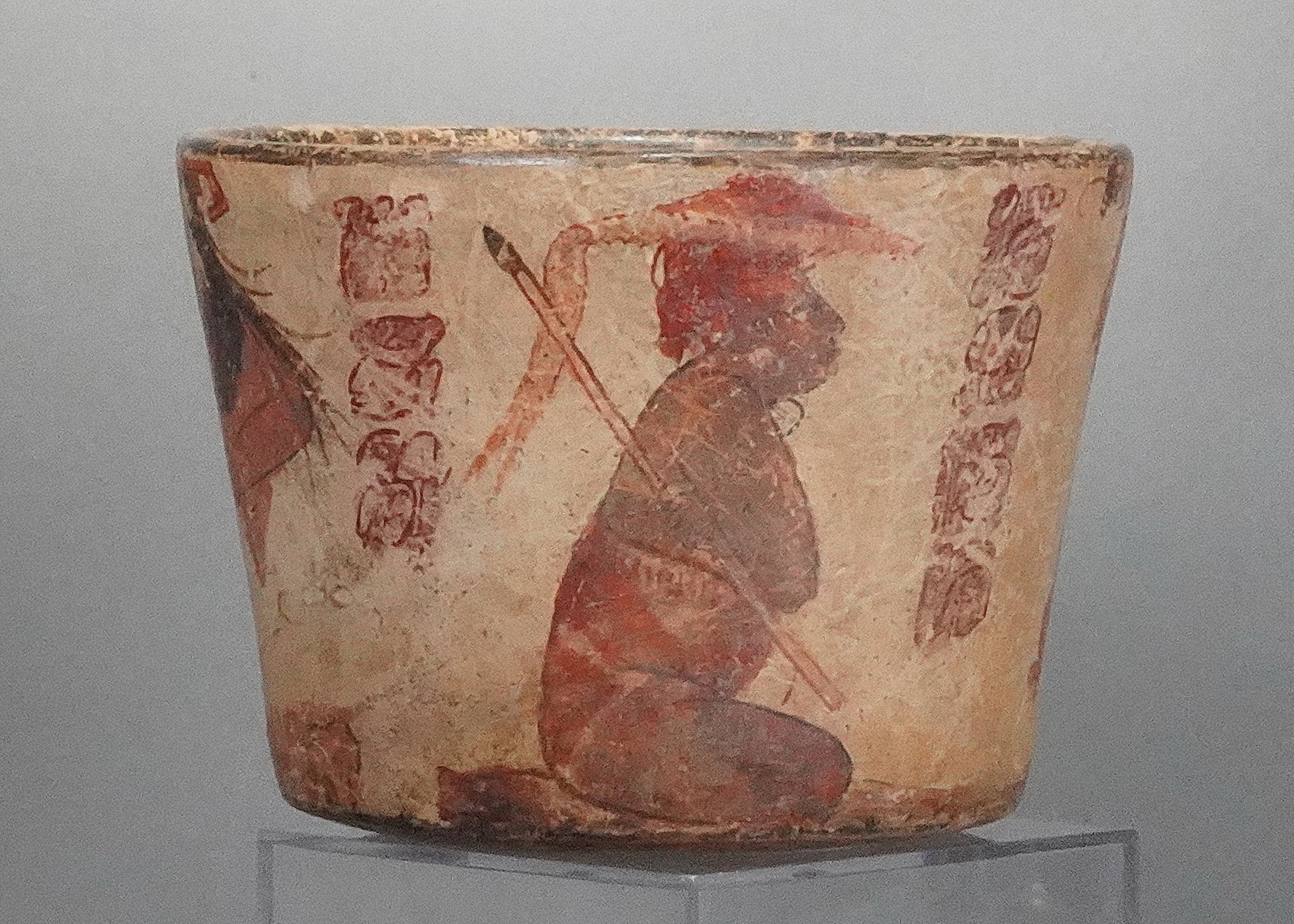





Guatemala, Mayan Polychrome Dish with Two Priests in the Motul de San Jose Style
This painted ceramic dish depicts two scenes. The first scene features two seated figures facing each other, separated by three glyphs. In this scene, the figure at right holds a staff and wears an elaborate headdress, while the figure at left wears a jaguar kilt and is making a gesture of resignation. The second scene depicts three figures, including a surrendering prisoner presenting himself to his captor, who is joined by a member of his entourage. Bishop Diego de Landa, c. 1524 - 1579, described the trope of captors and prisoners in Mayan art, referring to the “sign of resignation or humility before a conqueror or superior person.†This vessel also depicts a shaman wearing a black mask, who appears to be painting the glyphs and narrating the story. The glyphs on both sides of the vessel likely provide the names of the characters in the story.
This vessel was acquired from Gallery Hana in Tokyo, Japan, prior to 1970.
Media: Ceramic
Dimensions: Height: 4"
Price Upon Request
n5025
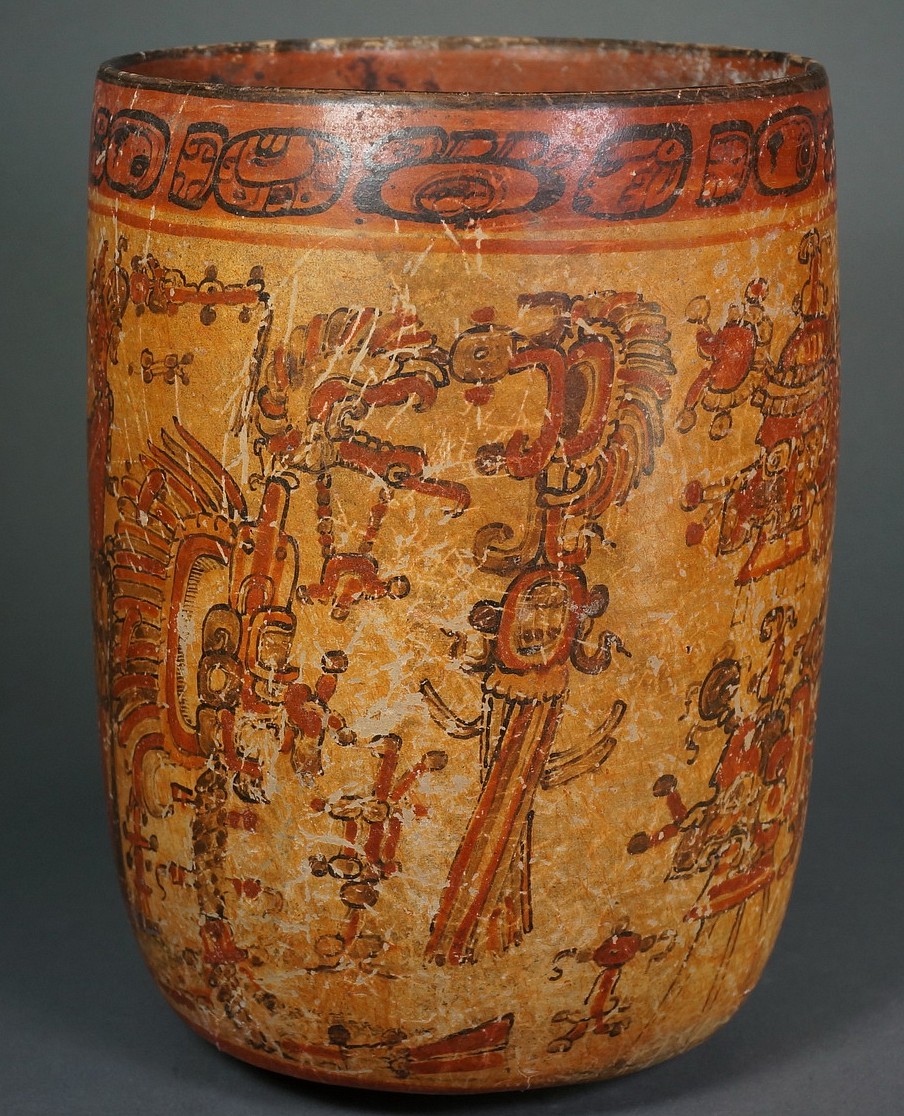







Guatemala, Mayan Tepeu 1 Style Mayan Painted Cylinder With Complex Palace Theme
This Tepeu 1 Style cylindrical vessel features complex iconography and a hieroglyphic inscription under the rim. There are two young, idealized male lords who likely represent Maize gods, as well as isolated floating motifs which are common in Mayan art. Deity heads with long snouts appear in front of the lords, possibly representing headdresses or possibly representing actual deities. The sets of three lines at the bottoms may represent stands or tripods for the masks. This vessel was reported on by Dr. Nicholas Hellmuth and exhibited at the MIHO Museum in Osaka in July of 2011. See Hellmuth's Late Classic (Tepeu 2) Vases: Throne Scenes essay for reference. Vases with Hieroglyphic Inscriptions Formerly in the collection of Hiroshi Miura, Tokyo, Japan, prior to 1969.
Media: Ceramic
Dimensions: Height: 7 1/2" x Diameter: 5 1/4" inches
$12,500
N5026
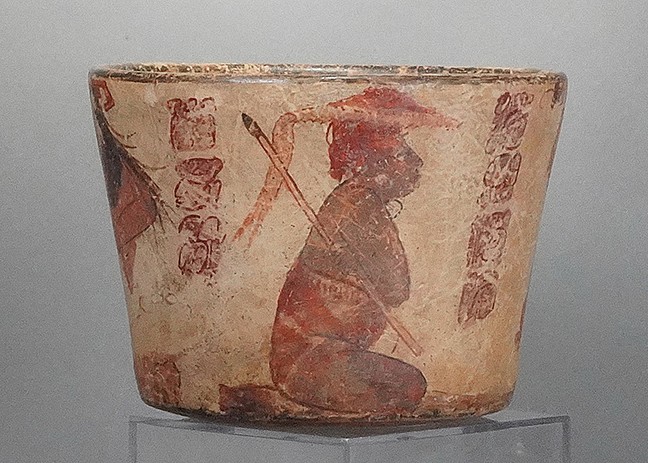






Guatemala, Mayan Tepeu 2 Polychrome Dish with "Fat Cacique" and Victim
This painted ceramic features 5 figures. In one scene, a staffbearer oversees another figure with a jaguar kilt who is making a gesture of resignation. The second scene depicts three figures, including a surrendering victim presenting himself to his captor, who is joined by a member of his entourage. The captor is a recognizable in the Mayan lexicon idenfied by scholars Jason Kerr and Nicolas Hellmuth as "The Fat Cacique."
Bishop Diego de Landa, c. 1524 - 1579, also described this trope of captors and prisoners in Mayan art, referring to the victim's posture as a “sign of resignation or humility before a conqueror or superior person.†This vessel also depicts a scribe wearing a black mask, who appears to be painting the glyphs and narrating the story. The glyphs on both sides of the vessel likely provide the names of the characters in the story. This vessel was acquired from Gallery Hana in Tokyo, Japan, prior to 1970. This vase is illustrated in Dr. Nicholas Hellmuth's book, Mayan Vases, in chapter Chapter 10: Tepeu 2 Vases- Throne Scenes.
Guatamala, Mayan, Petan, Late Classic, c. AD 700 - 800 AD
Media: Ceramic
Dimensions: Height: 4"
$8,500
n5025
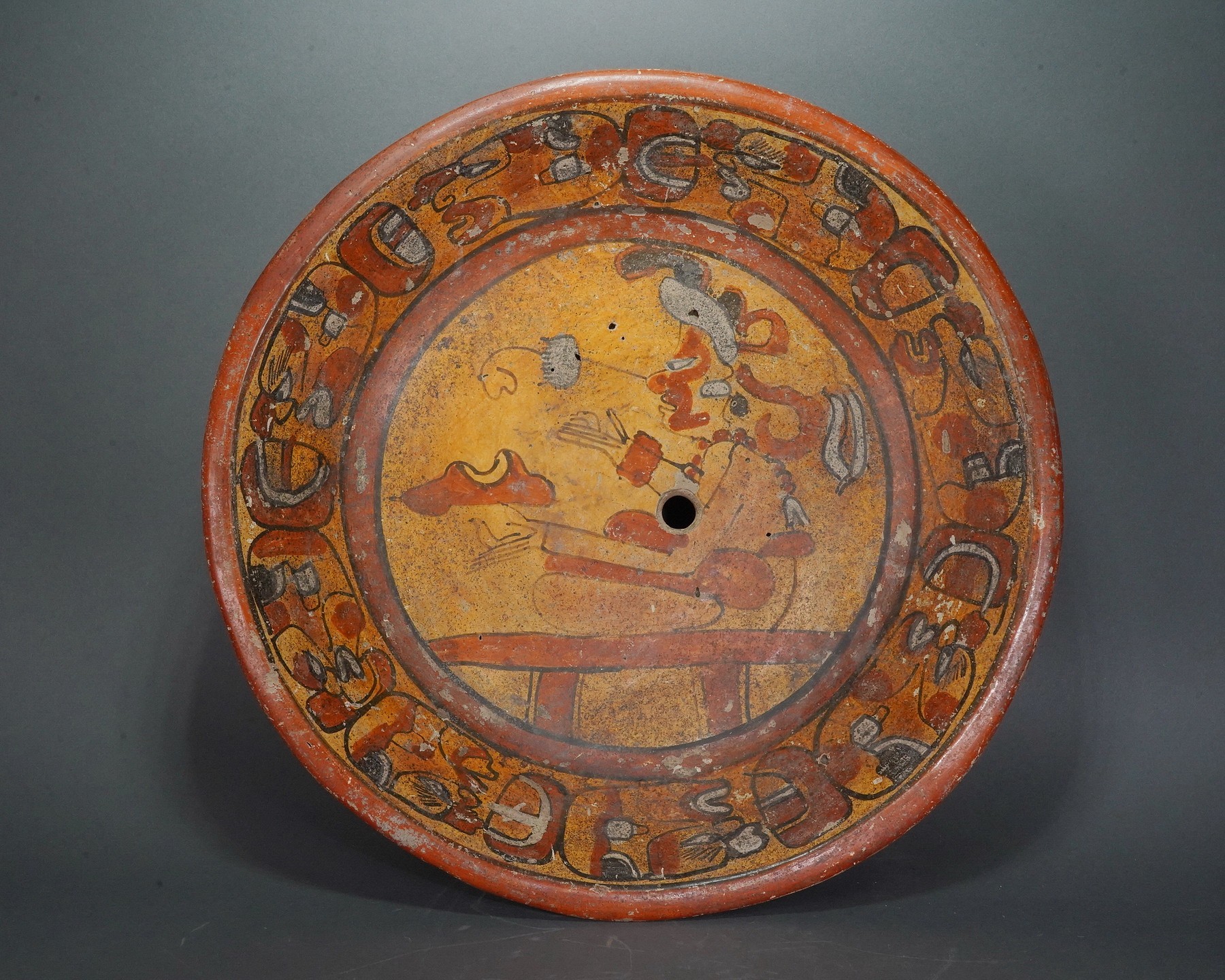






Guatemala, Mayan Tripod Dish with Seated Figure
This painted Mayan tripod dish features eight repeating glyphs of deity heads in profile painted around the inside edge. The central seated figure is likelay shaman. He is holding two birds, which represent communication. There is a "kill hole" in the center of the dish. The back of the dish is painted with scallop design. Formelry in the collection of Hiroshi Muira, Tokyo, Japan, prior to 1980.
Media: Ceramic
Dimensions: Diameter: 11" X Height: 3 1/2"
Price Upon Request
n6012B
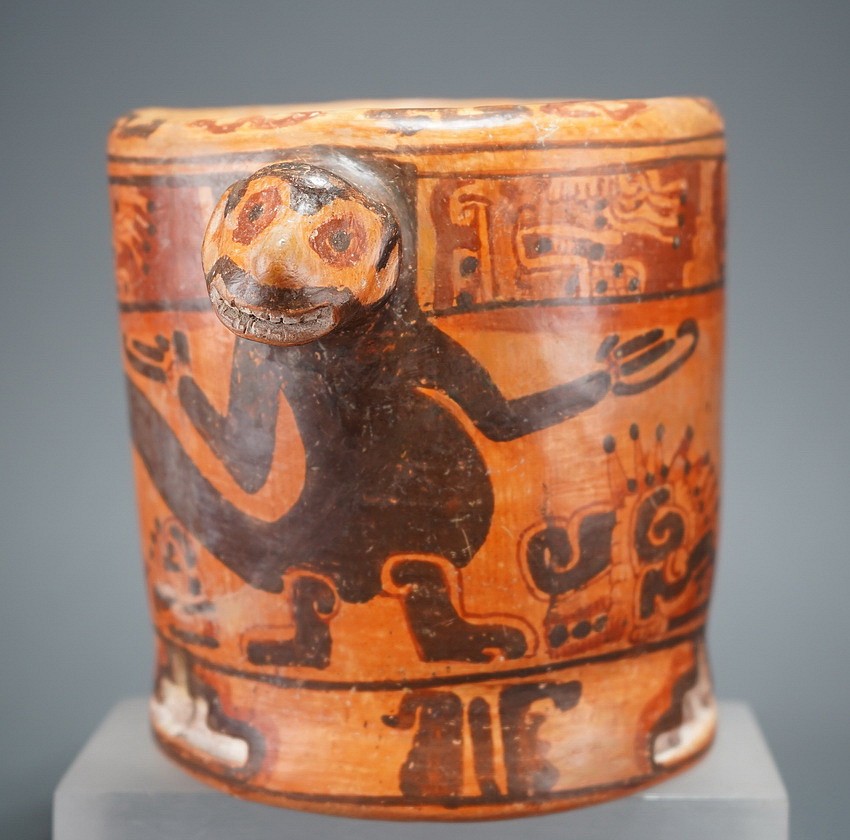

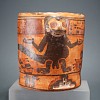
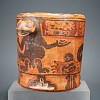

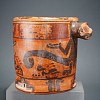

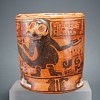
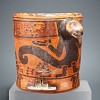




Honduras, Mayan Ulua Valley Ceramic Vessel with Protruding Monkey Head Handles
This is an excellent example of a painted Mayan ceramic vessel from Honduras, Late Phase. It is decorated with two bold monkeys with large tails. There is a band of glyphs around the top edge of the vessel, and glyphs separating the monkeys below. The monkeys' heads are cleverly sculpted in three dimensions to form the handles. The bottom of the vase is painted to resemble a classic Ulua Valley marble vase. This the finest known example of a Mayan vase depicting a monkey from the Mayan region of Honduras. A similar vase is illustrated in the Mayavase.com website, reference number 5668. Formerly in the Eisenberg estate in CT, prior 1980.
Media: Ceramic
Dimensions: Height: 5 3/4" (14.6cm) x Diameter: 4 7/8 (12.5cm)
Price Upon Request
P3050
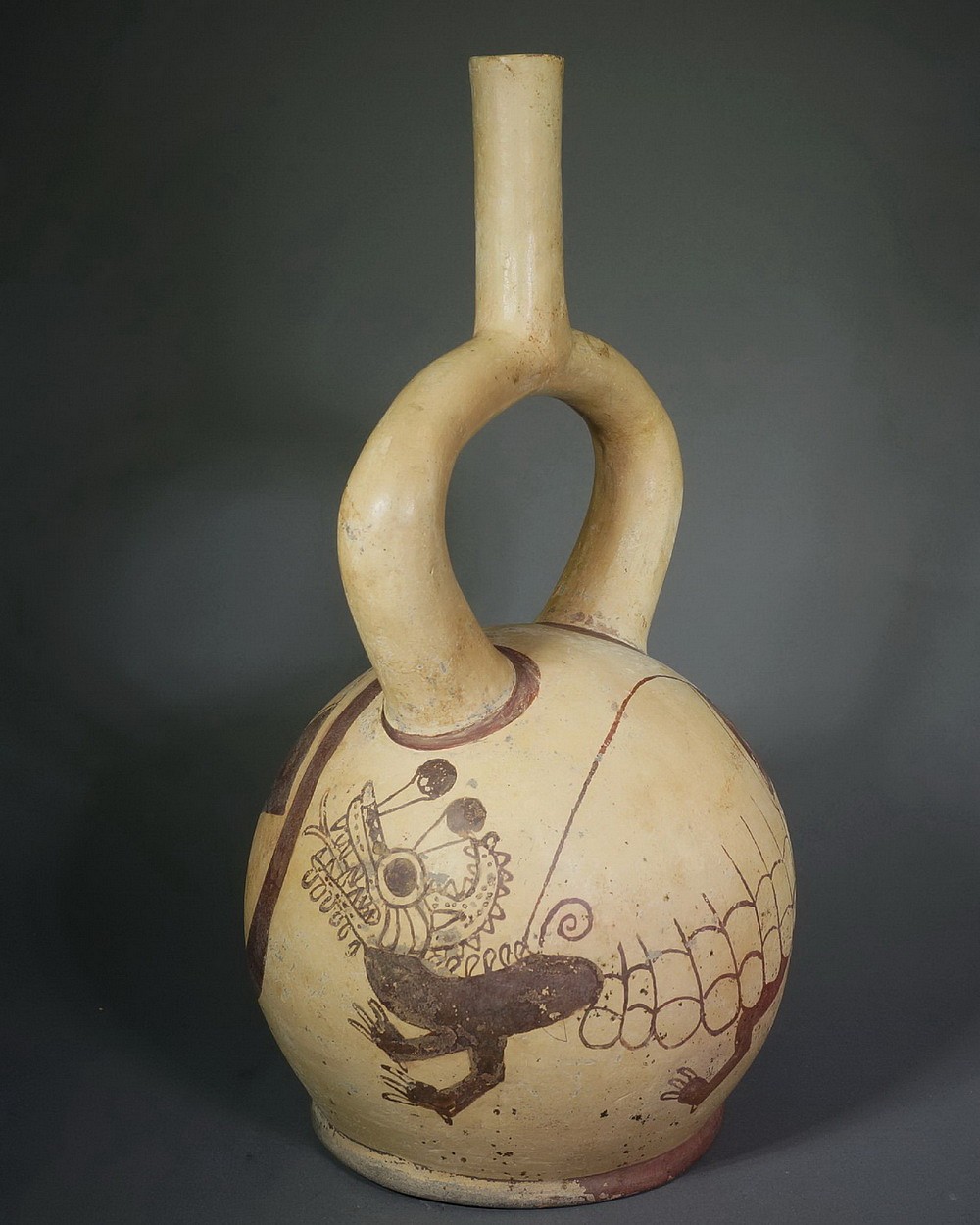





Peru, Moche 4 Stirrup Spout Vessel painted with a Strombus Monster
The vessel is finely drawn with reddish brown slip on a cream ground and depicts a Strombus galeatus monster coming out of its shell on both sides. The monster has a long curving tail and an exposed a front leg. Christopher Donnan describes this monster in MOCHE ART OF PERU, pg. 64. From the estate of Philip L. Herman prior to 1970.
Media: Ceramic
Dimensions: Height: 12 1/4"
$6,500
n6048
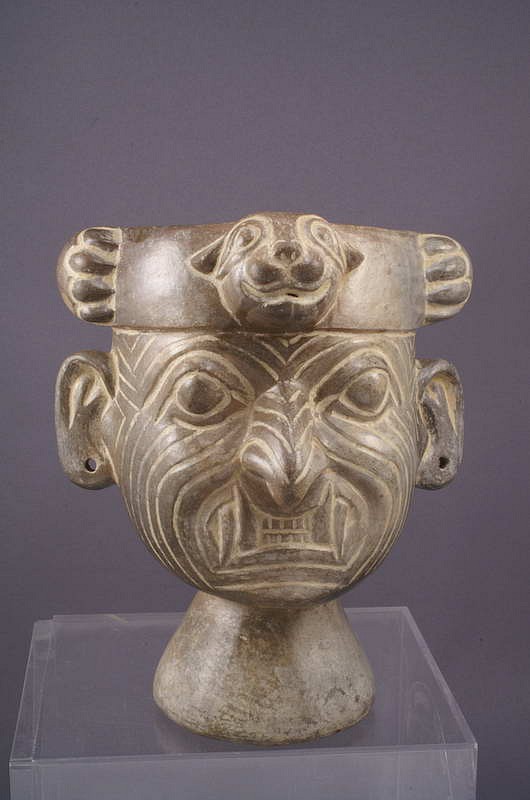
Peru, Moche Grayware Rattle Cup with the Decapitator
A well modeled portrait of Ai Apaec wearing his characteristic puma ring headdress with its tail incised on the back of the vessel. The perforated base of the cup contains clay beads which make the vessel rattle with movement. Ai Apaec was an old wrinkled god associated with war and sacrifice, hence his other titles as the Decapitator and Wrinkle Face.
Media: Ceramic
Dimensions: Height: 5 1/4" x Width: 4 1/2"
$5,200
M3147
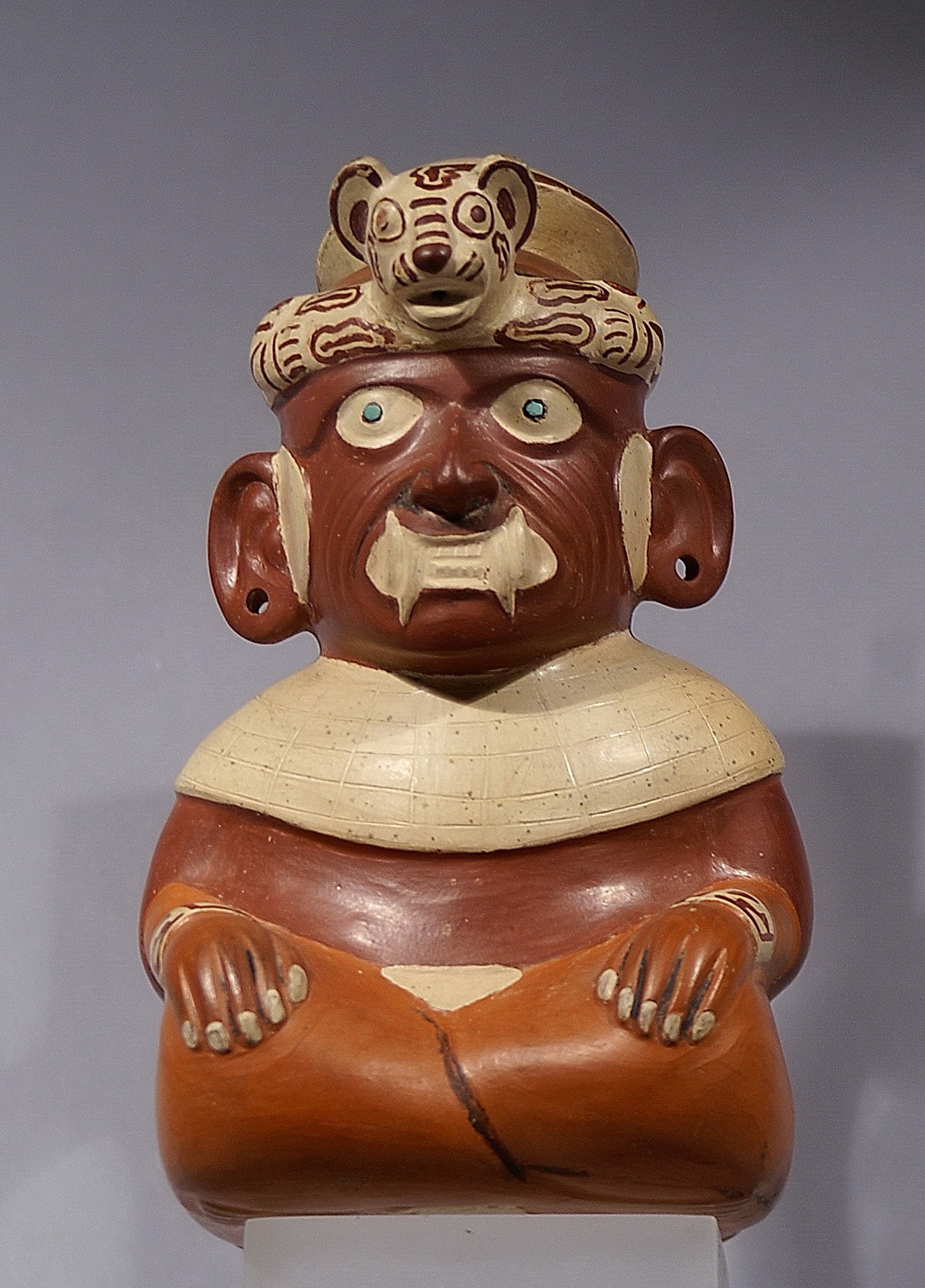






Peru, Moche I - II Effigy Vessel of the Decapitator Ai Apaec
This is an early version of the Decapitator deity known as Ai Apaec. The deity always wears a feline headdress, but early versions also show him with a turban. This headdress not only has a puma skin but also a Plume of feathers represented by the conical form ontop of his head. He also wears a lovely Pectoral with individual plaques sewn onto a leather backing. The Decapitator is one of the earliest supernaturals in the Moche ceramic sequence, and he frequently carries a tumi knife and a decapitated head. The Decapitator continued into later cultures, notably the Wari and the Chimu. Formerly in a European collection since the 1970s.
Media: Ceramic
Dimensions: Height: 7 1/2"
$29,000
M7073
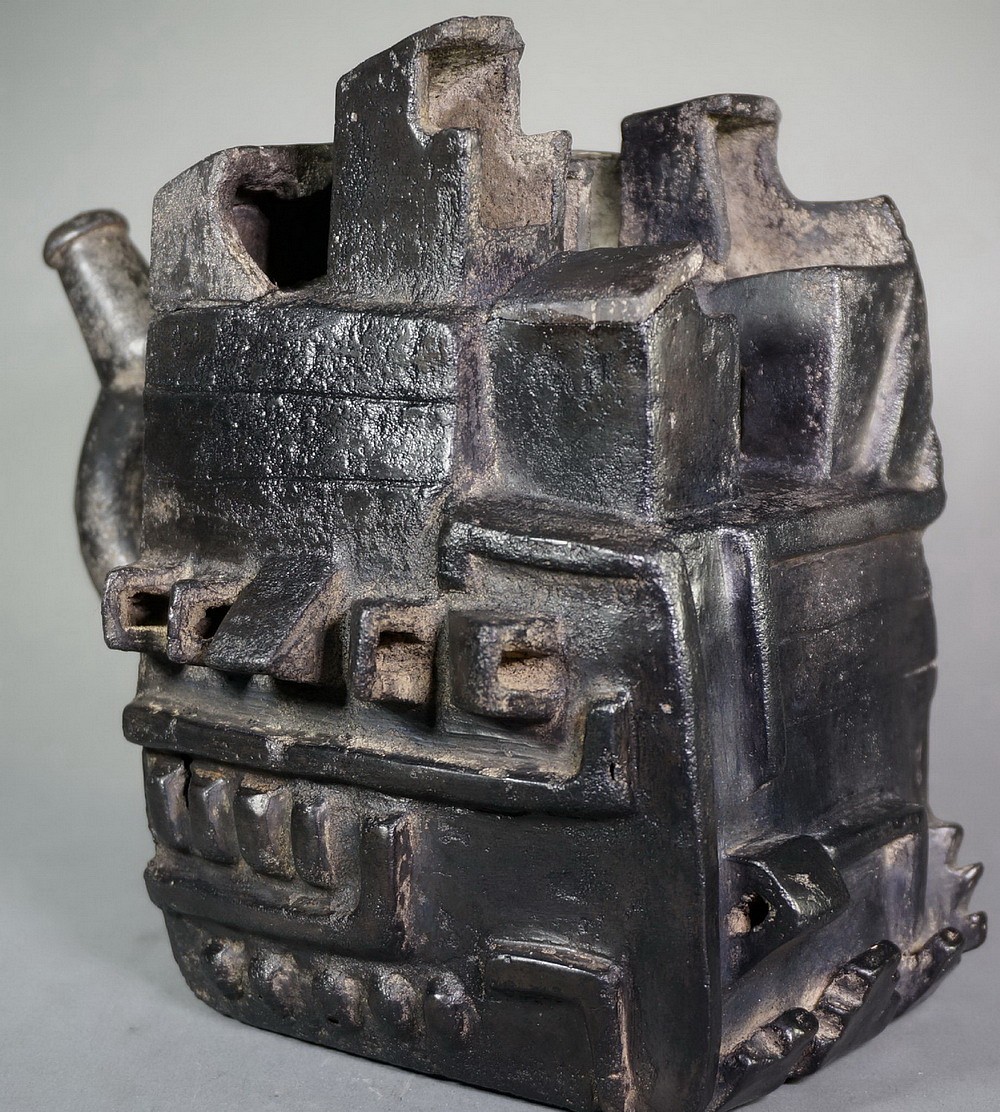








Peru, Moche I Blackware Architectural Model Depicting An Adobe Temple Site
This model is like one now in the National Museum of Archaeology in Lima, Peru (#c-54613). It was originally drawn as it might have been seen in ancient times by artist Alejandro Gonzales in 1936. This drawing is published in ARCHITECTURAL VESSELS OF THE Moche, by Juliet Wiersema, p.3, University of Austin Press. According to Dr. Christopher Donnan, a Moche scholar, the Moche often produced nearly identical ceramics with the same theme. From the estate of Philip L. Herman and collected in the 1950's -1960's.
Media: Ceramic
Dimensions: Width: 6" x Length 4 1/2" x Height: 8"
$12,000
n6047
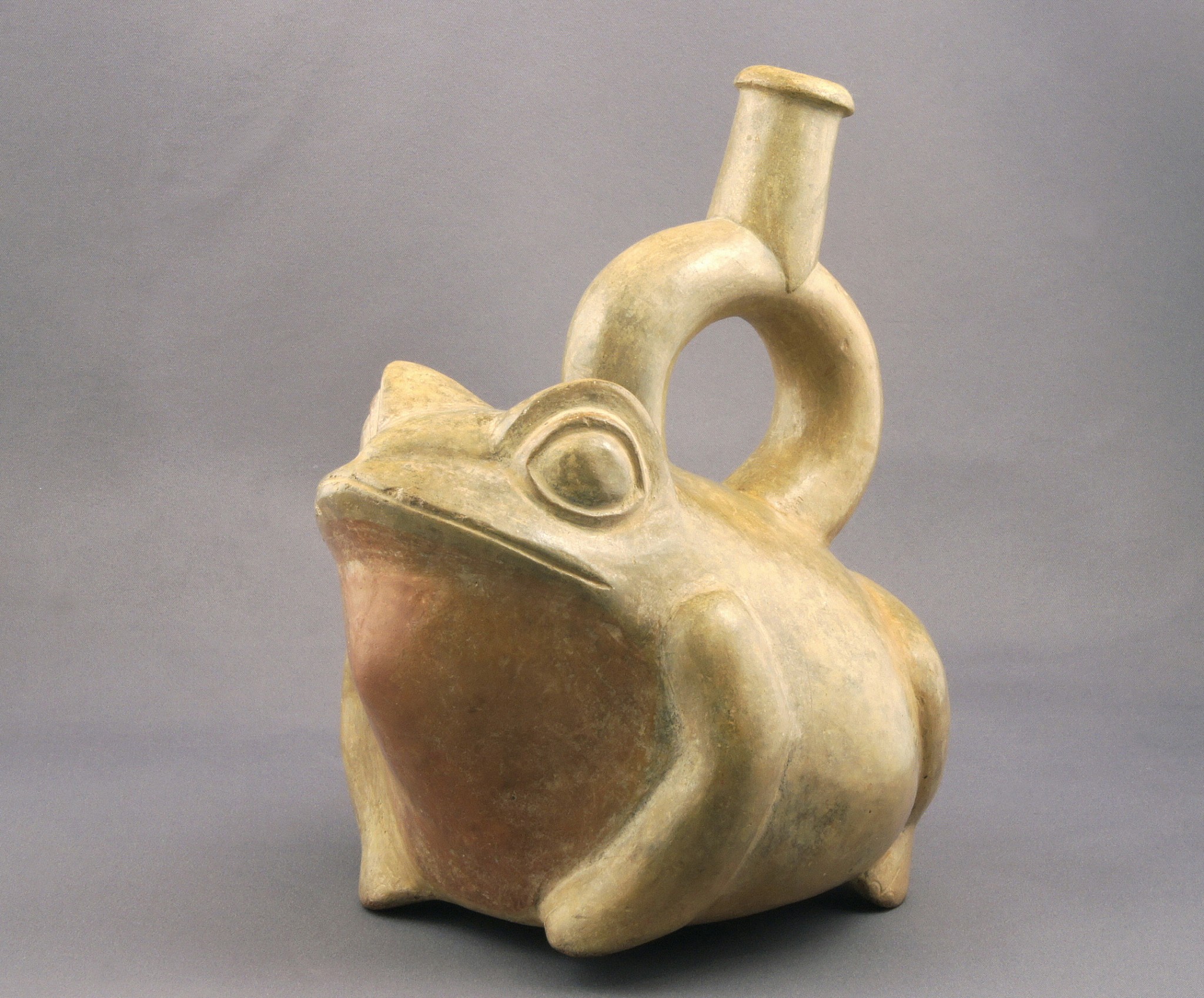




Peru, Moche I Ceramic stirrup-spout effigy of a seated toad in buff with red throat
This stirrup spout vessel depicting a life-like frog/toad attests to the Moche artist's fond awareness of the natural world. Such careful attention and adeptness at naturalistic portrayals of animal images is common of Early Moche ceramics. Frogs have bulbous eyes, strong, long webbed feet, and slimy skin, while toads have stubby bodies, warty, dry skin, different chest cartliage and paratoid glands behind the eyes. Their large eyes are defined with a ridge. Also, toads do not have teeth, while frogs have upper teeth. This rotund fellow with his alert wide-eyed gaze and attentive posture seems all too ready to ambush an unsuspecting fly. It is slip painted in cream and the head tilts upward, exposing a rosy orange gullet beneath the determined, down-turned mouth. Images of frogs and toads (anurans) are commonly interpreted in the art of many Pre-Columbian cultures. Because of their musical croaking performances after heavy rains, frogs and toads are associated with water, vegetation , fertility, and in some cases (usually toads), toxicity. The cyclic quality of their development --the change from the fish-like tadpole to adult frog, allude to a natural affiliation with mythical concepts of transformation. Similar examples are illustrated in "Pre-Columbian Art of South America", by Alan Lapiner, fig. 281, p129, and in "Moche Art of Peru", by Christopher B. Donnan, fig. 81, p.57. as well as in Ceramics of Ancient Peru by Donnan, 1992, UCLA, p. 128.
Media: Ceramic
Dimensions: Height: 7" x Width: 5"
$5,400
98439
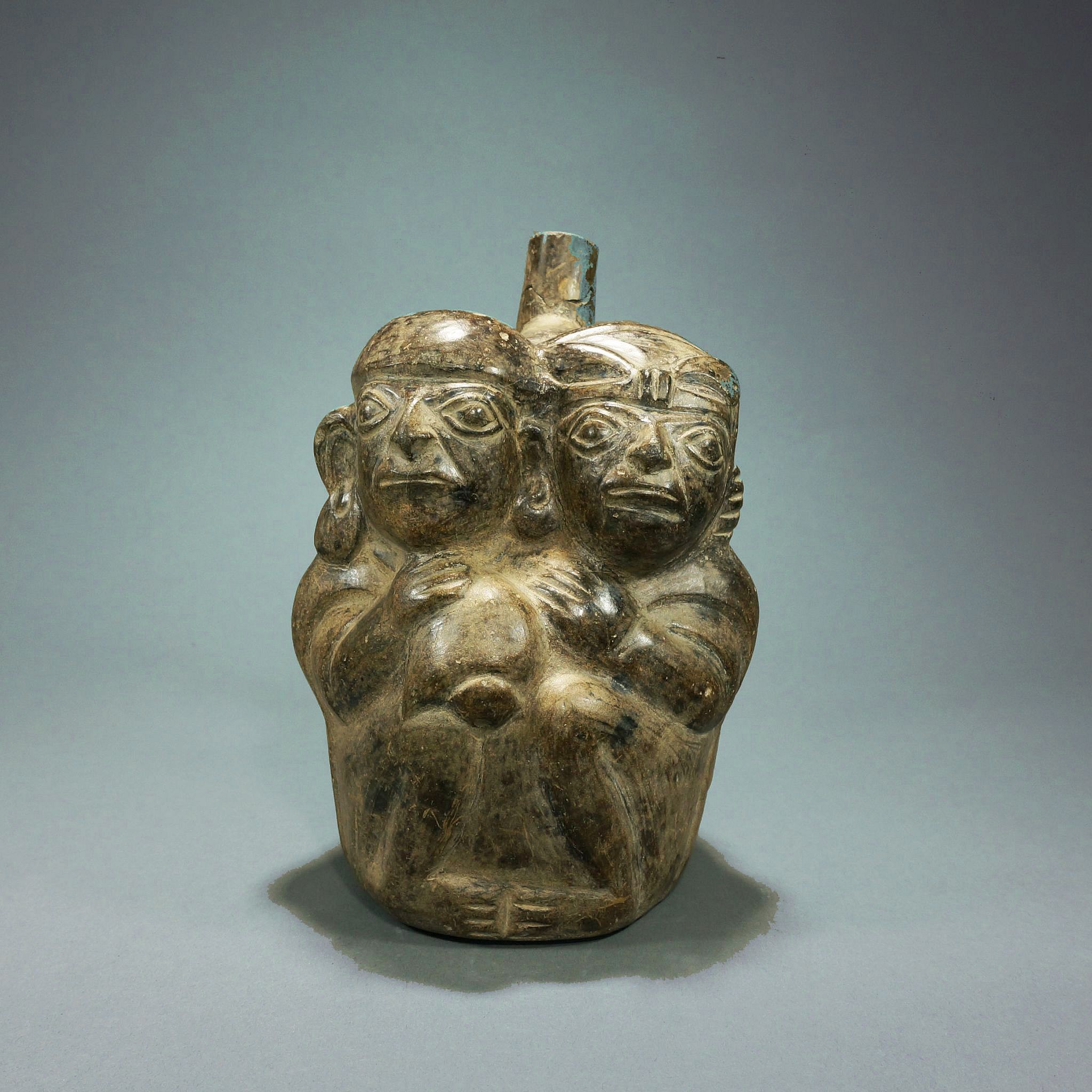
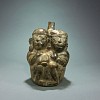
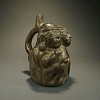


Peru, Moche II Grayware Vessel with Embracing Couple
An embracing couple is an extremely rare subject for Andean art from any culture. Although ancient Andean art features many human characters such as hunters and shamans, as well as semi-human deities with a wide range themes and emotions, romantic couples are not a common theme. In this sculptural depiction of a Moche couple, the male wears large ear ornaments, and holds a conch trumpet, and the female wears a feather plume in her hair, all signs of wealth and status.
Media: Ceramic
Dimensions: Height 8"
Price Upon Request
M9015H
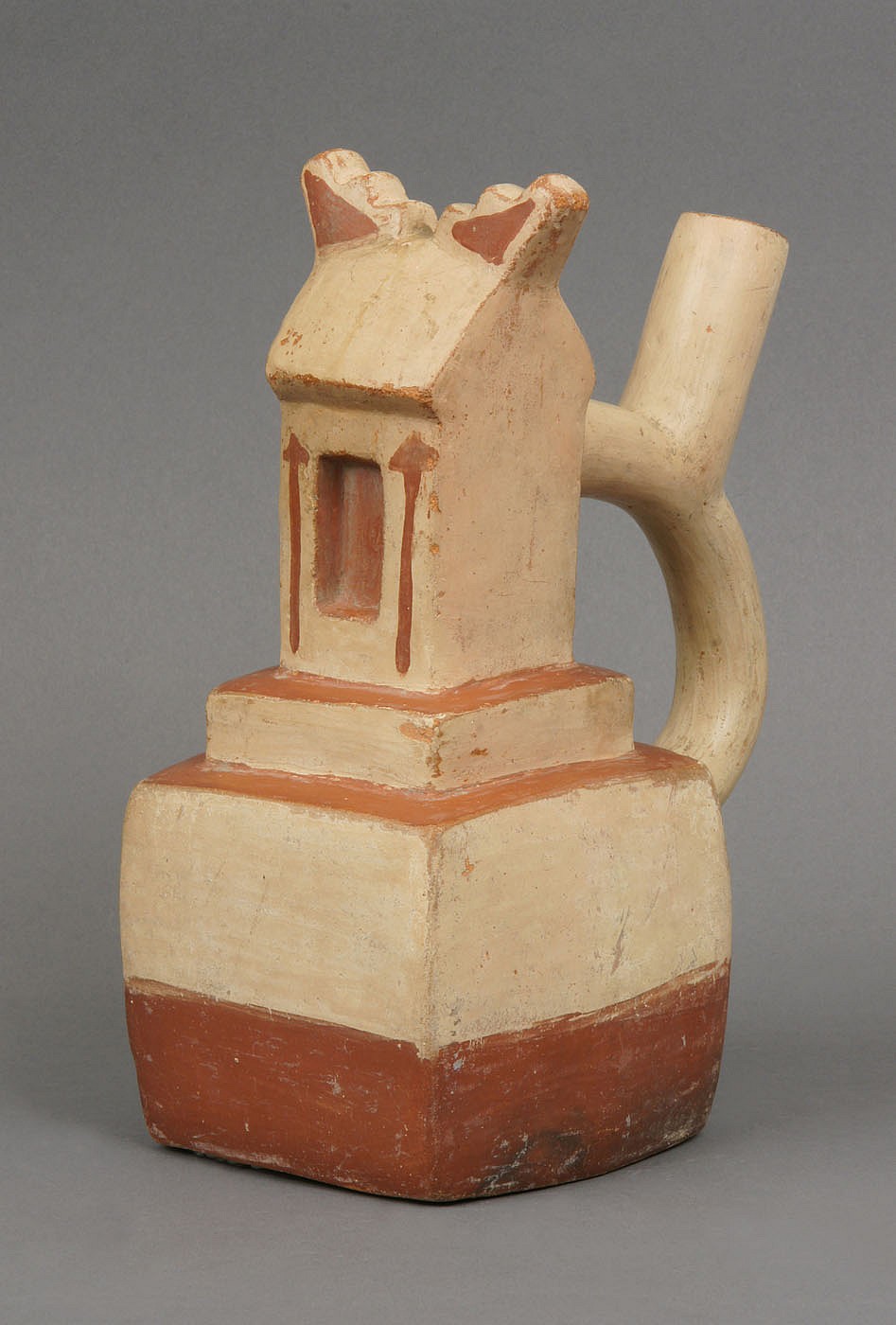



Peru, Moche III Ceramic Vessel in the Form of a Gabled House
This house or religious center is detailed with a gabled roof and stucco decoration with painted spears. A priest is portrayed in the doorway in full regalia. Ex Collection Of Sue Tishman, prior to 1970.
Media: Ceramic
Dimensions: Height 9"
$7,000
M7019
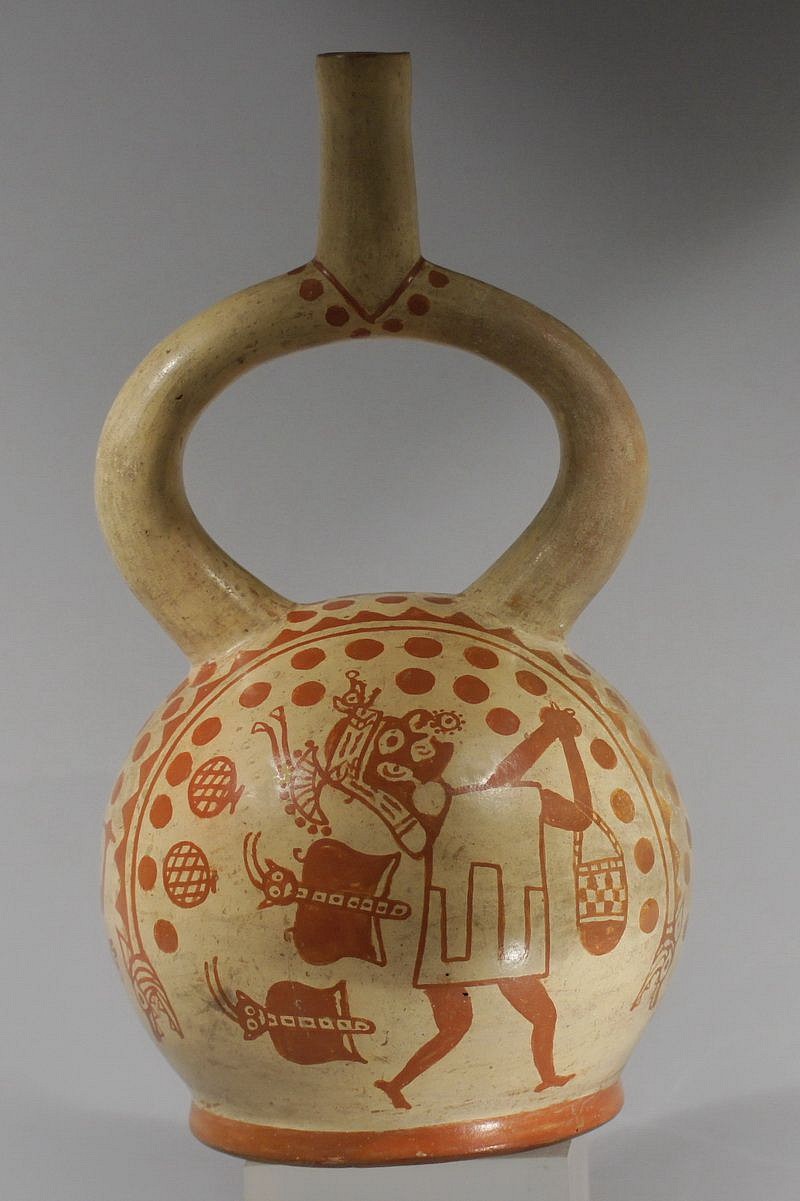
Peru, Moche III Fineline Vessel Depicting a Coca Ceremony
A fine example depicting the coca ritual. On one side we see 4 seated men holding the traditional gourd lime containers and administrating lime to extract the coca from the leaf. On the other side we see a figure with hands clasped holding a coca leaf bag and surrounded by bats, dark balls, and the Bicephalus Arc (double-headed serpent) which symbolize psychic flight and the praying for rain. There are three other known examples of the Coca-ritual under the Bicephalus Arc in Pre-Colombian art. One is in the Linden Museum in Stuttgardt and two others are in the collection of the Museo Arqueologico Raphfael Larco Herrera, Lima. All three are discussed in an article THE PRIESTS OF THE BICEPHALUS ARC by Santiago Uceda and published in THE ART AND ARCHAEOLOGY OF THE MOCHE, pg. 153-178, University of Texas Press 2008 . Formerly in the collection of Benno Mattel and exhibited at the British Consulate in Punta Del Este. Subsequently sold to a US collector in the US where it remained for ten years. Rollout drawing in Moche Archive #157.
Media: Ceramic
Dimensions: Height 10" x Diameter 5 3/4"
Price Upon Request
n2002
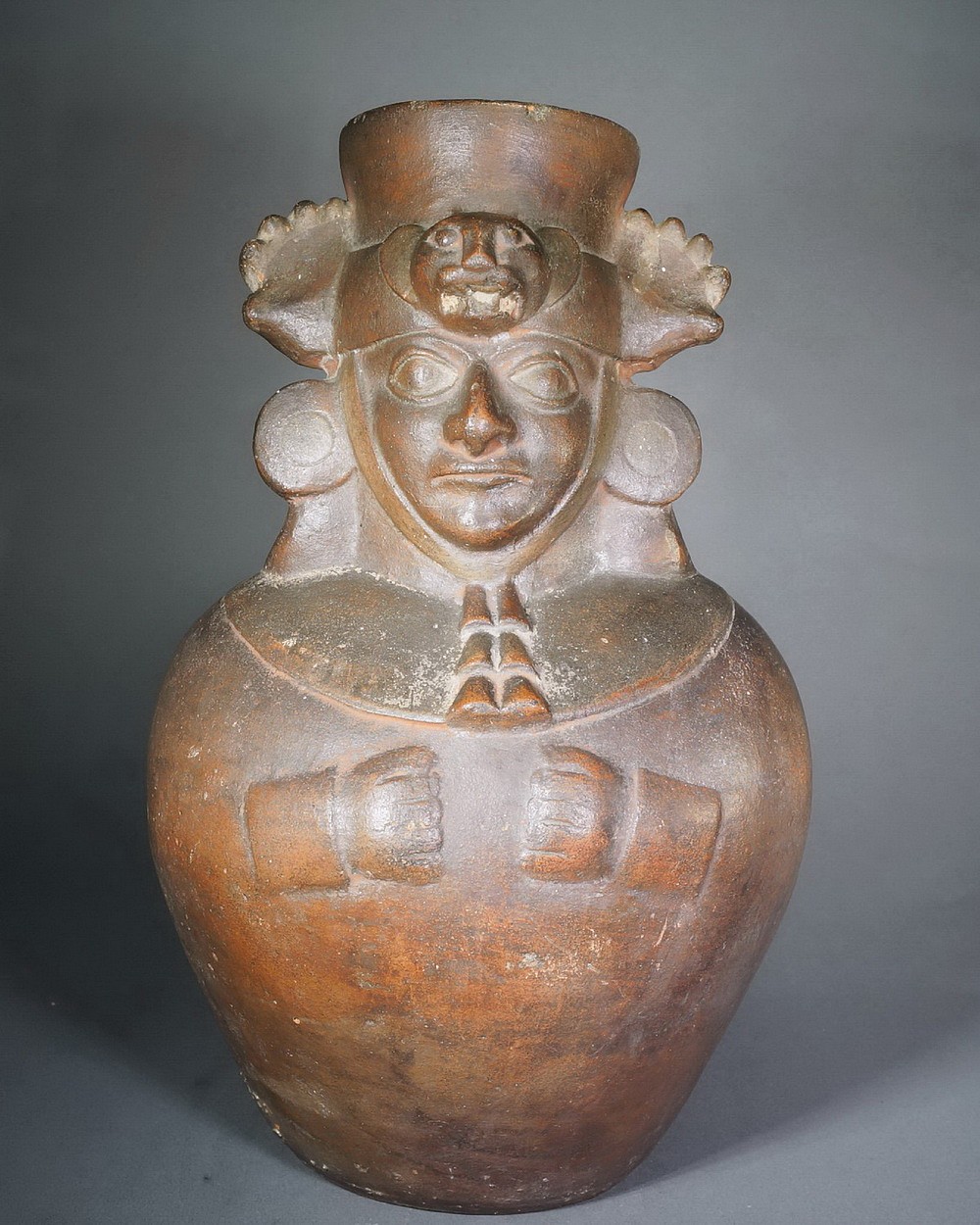






Peru, Moche III/IV Redware Mold Made Jar Depicting a Dignitary
The figure is wearing a head cloth underneath a Puma head ring with straps ending in tassels and large paws, with its polka-dot tail down his back. He also wears large ear spools which denote his status. He holds his hands to his chest below a semi-circular breast ornament. These vessels were made in a two-part mold, one for the front and the other for the back.
Media: Ceramic
Dimensions: Height: 12 1/2"
Price Upon Request
n6049
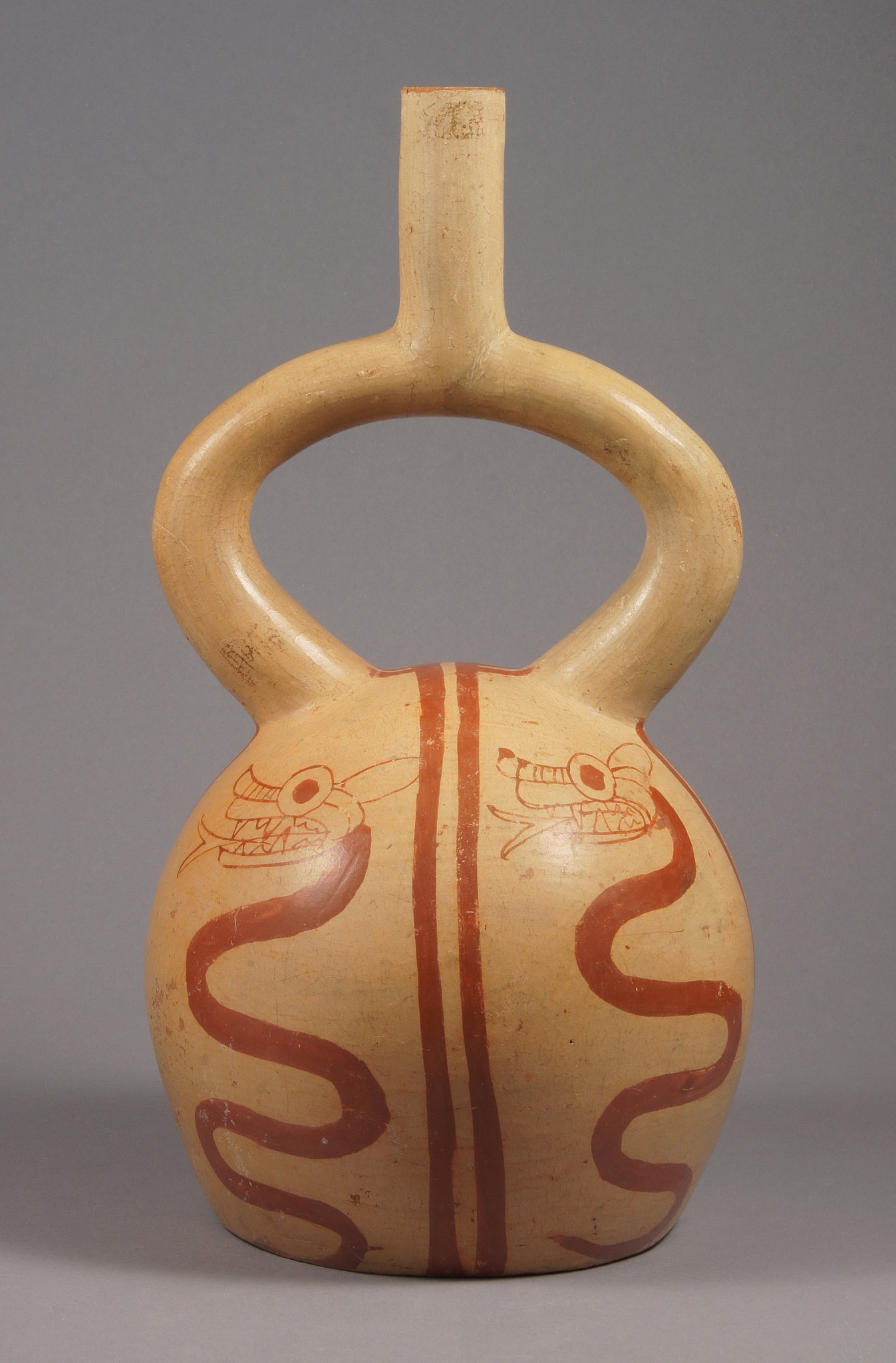


Peru, Moche IV fine line ceramic stirrup spout vessel of Serpents
A large stirrup spout vessel painted with four undulating serpents facing upwards, one in each quadrant in red/brown on a beige ground. The serpent represents rebirth, the shedding of its skin repeating as much as four times, perhaps for each season. Stirrup spout vessels were used to hold ceremonial corn beer and the spout allowed the air to enter one channel while the liquid was able to pour through the other channel.
Media: Ceramic
Dimensions: Height 11 1/2"
$4,500
90078
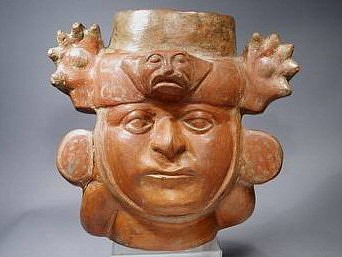
Peru, Moche Portrait Vessel of a Lord
Reddish brown ceramic, open top, portrait vessel of a man wearing ear spools and a headdress with a puma head motif and two enormous front paws emerging from the sides. There are traces of spotted, beige slip decoration on the ear spools and spots on the headdress. This vessel is significantly larger than most portrait heads which average slightly more than half life-size, and it is in good condition. Portrait vessels play a significant role in Moche art as forerunners of a period of realism that followed them. It is believed that portraits were of powerful leaders, and that their presence in a grave signified an honor bestowed upon the deceased. A very similar portrait vessel is illustrated in "Ancient Peruvian Ceramics: The Nathan Cummings Collection," by Alan Sawyer (1996: pl: 37). Another, perhaps of the same person, is illustrated in "Moche Portraits from Ancient Peru" by Christopher Donnan (2004: fig.: 4.27).
Media: Ceramic
Dimensions: Height: 9 3/4"
Price Upon Request
96077
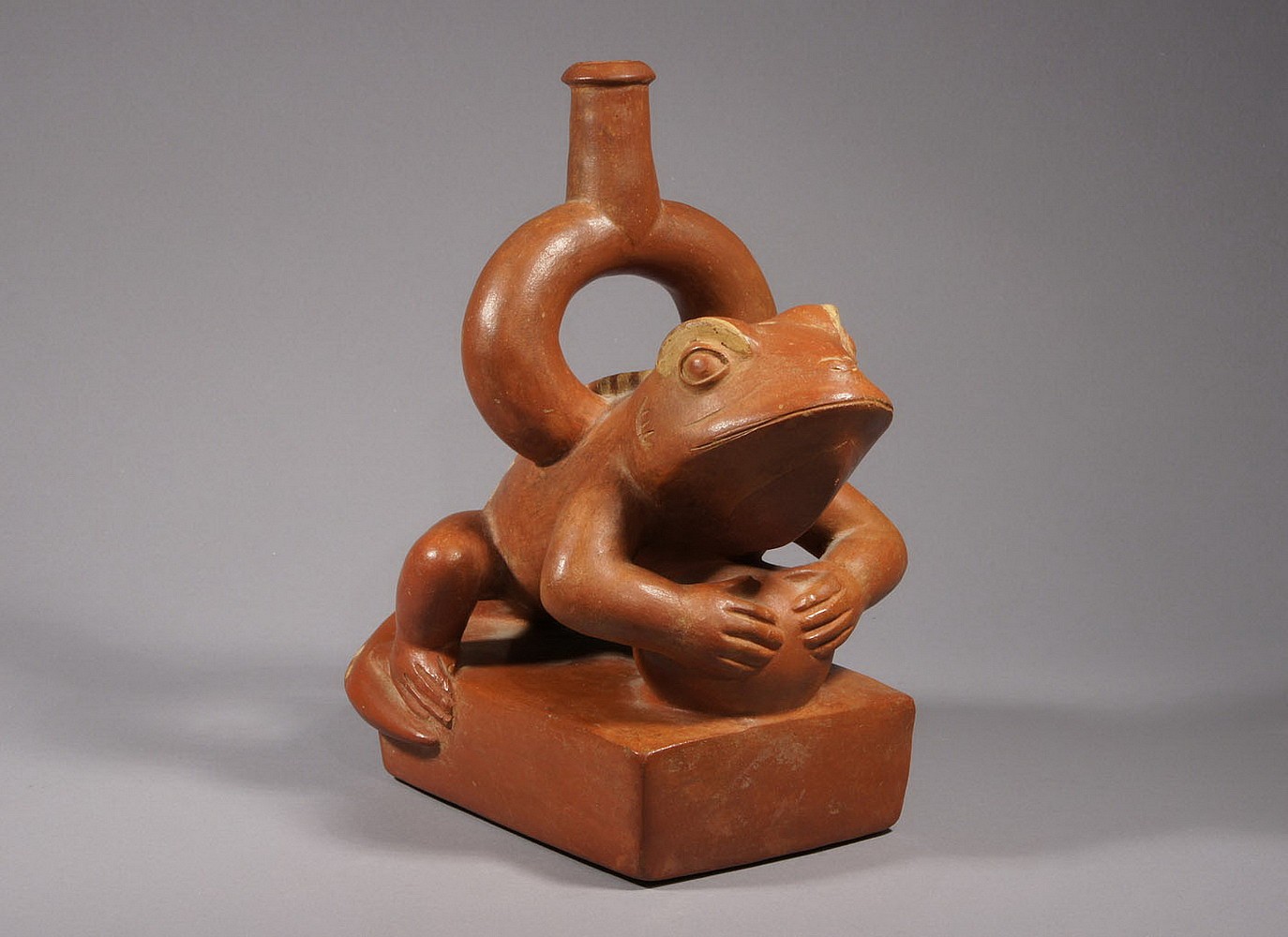
Peru, Moche Stirrup Spout Redware Vessel effigy vessel of a Tadpole
The tadpole is identified by the gullet under the mouth and long tail. This tadpole has highlights in buff slip over the eyes, on the gills on each side behind the eyes, on the nostrils, and under the mouth. The tadpole has human fingers and toes. This effigy is holds a large sphere to the chest and is crouches on a rectangular vessel. Very good condition. Cracks repaired at elbows.
Media: Ceramic
Dimensions: Length: 10" x Height: 8"
Price Upon Request
n2018
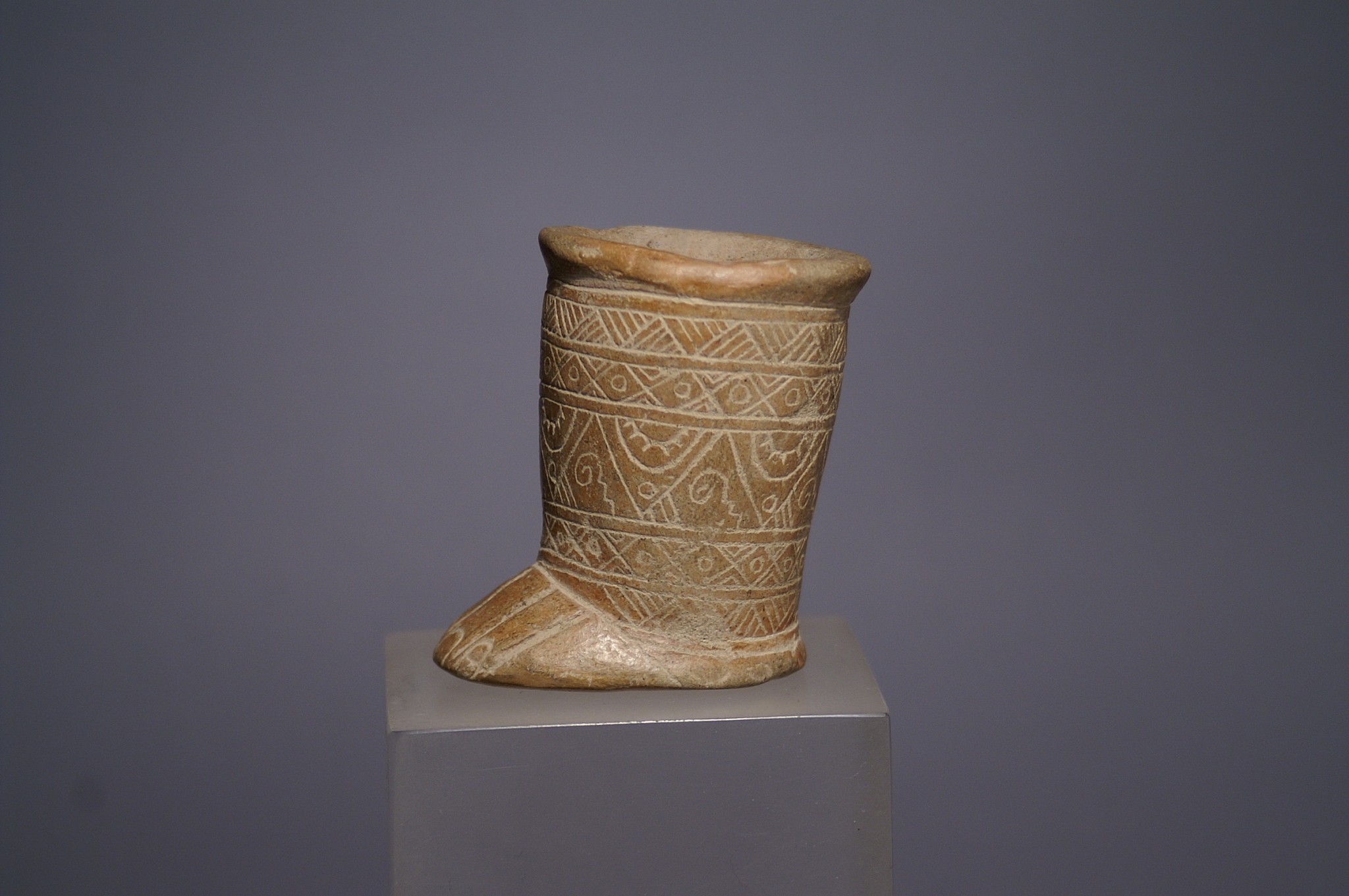




Ecuador, Monteno incised ceramic container in the form of a foot with suspension hole
This is typical of a lime container from the Monteno region and decorated with 4 bands of geometric designs. A similar votive foot vessel is illustrated in Amerindian Signs item 141
Media: Ceramic
Dimensions: Height 2 3/4"
$950
N1049
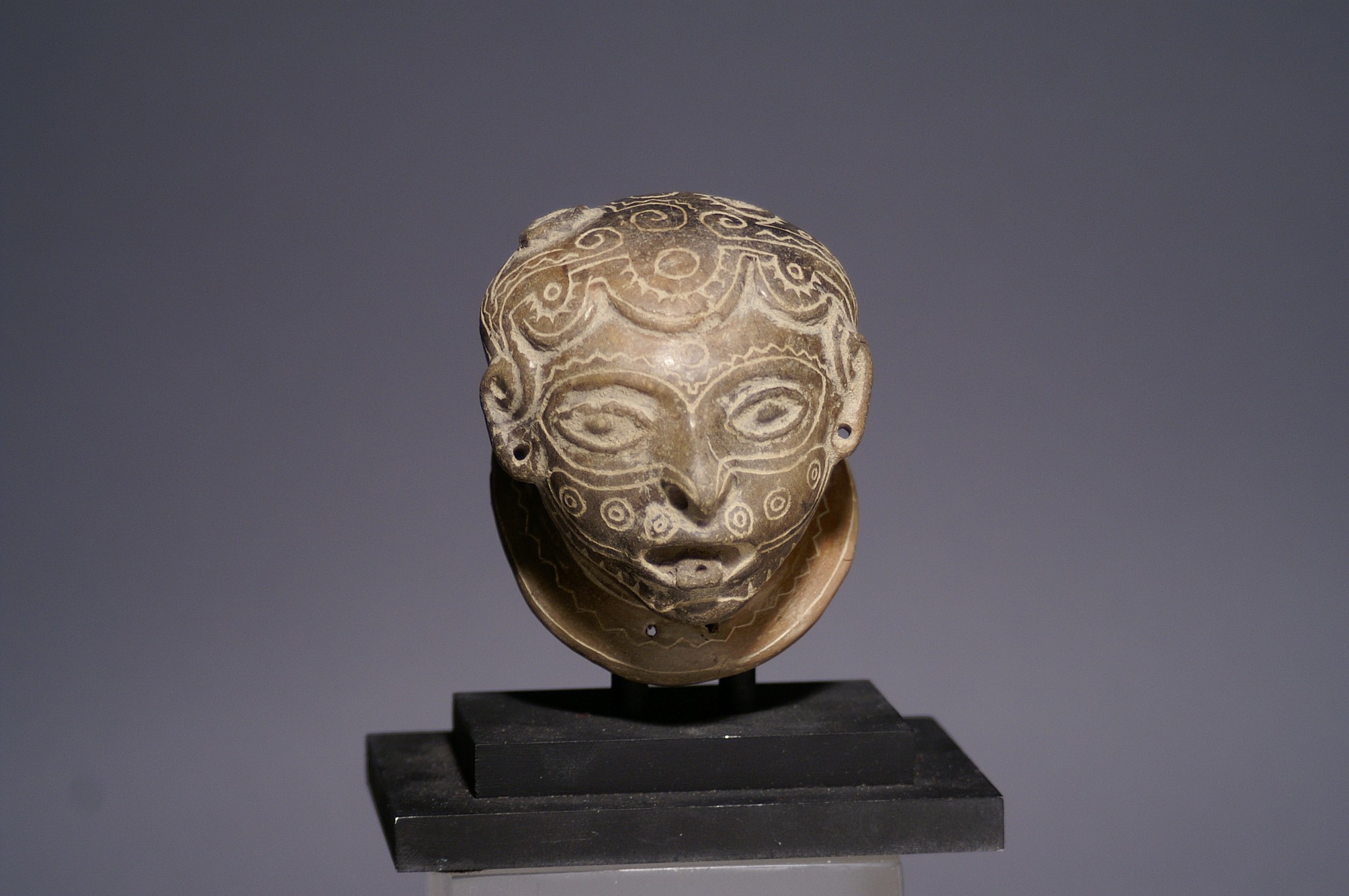




Ecuador, Monteno incised ceramic container in the form of a head with tattoos all over
This is typical of a lime container from the Monteno region and decorated with 4 bands of geometric designs. A similar votive foot vessel is illustrated in Amerindian Signs item 141
Media: Ceramic
Dimensions: Height 2 3/4"
$1,100
N1050
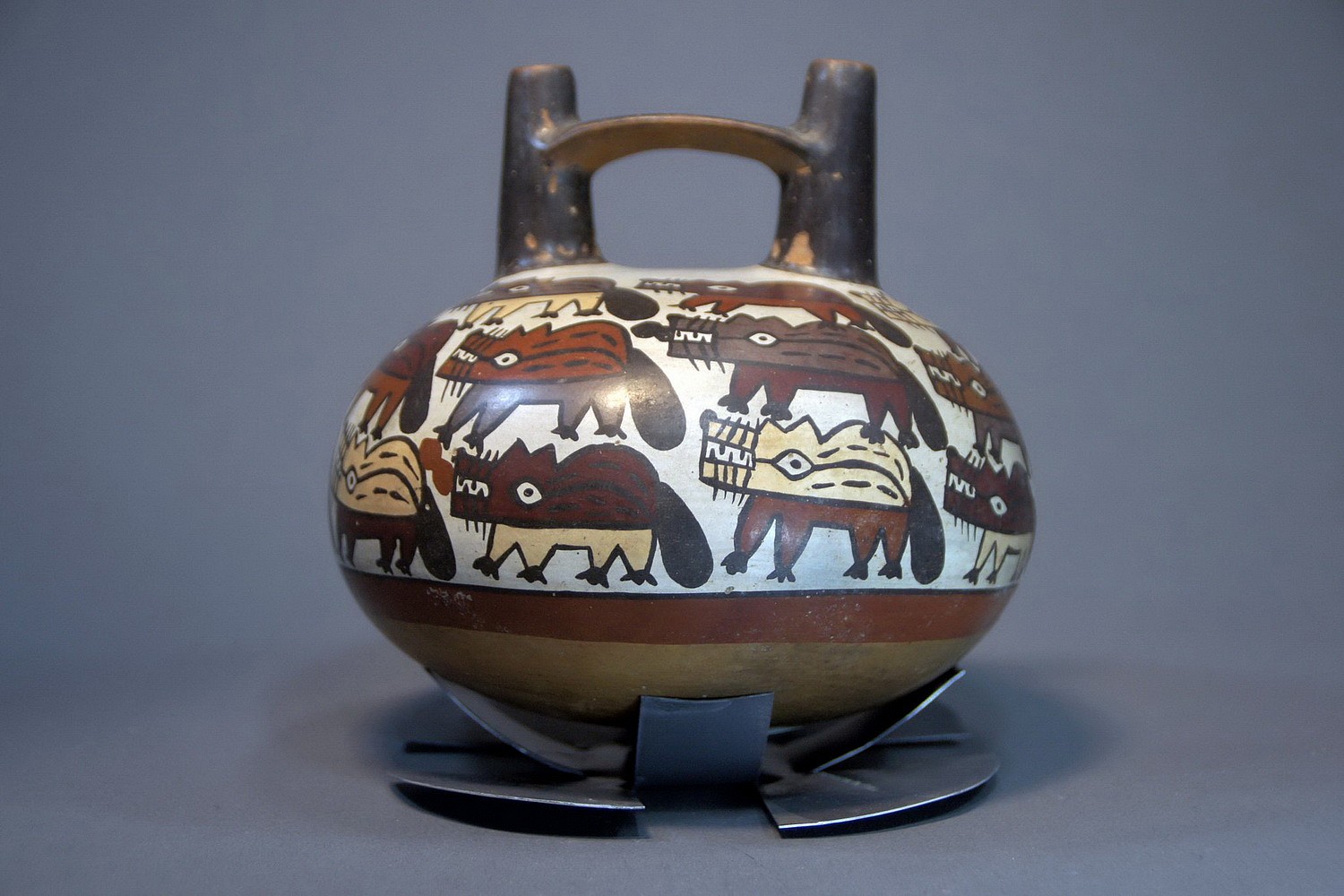
Peru, Nasca Bridgespout Vessel Painted with 23 Foxes On White Ground
A late Nasca period vessel, T/L tested, verified as 1650 years old by CIRAM Labs. Prof. Donald Proulx in his Sourcebook of Nasca Ceramic Iconography (pg. 141) describes the Andean Fox with the following characteristics, drawn in profile with elongated snout, pointed ears, whiskers and thick black tail. Deiter Eislab Illustrated 5 ceramics with similar painted foxes in ALTPERUANISCHE KULTUREN NAZCAII, plate 6-9.
Media: Ceramic
Dimensions: Height; 5 1/2" x Diameter: 6"
Price Upon Request
n4052
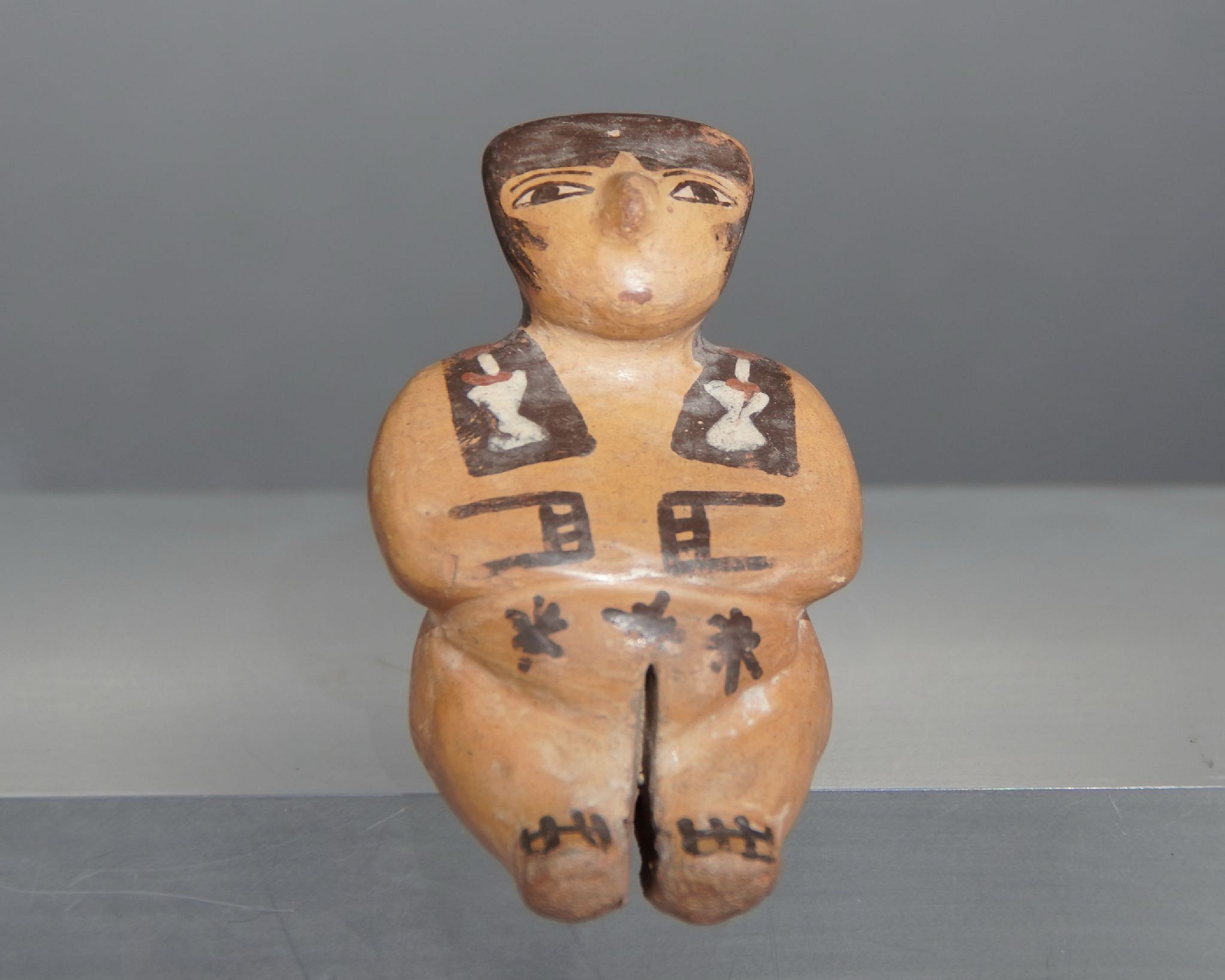





Peru, Nasca Miniature Female Seated Figurine
This seated ceramic female has hands painted on her belly, black hair painted falling over the shoulders, white hair ornaments, and tattoos painted on each buttock. The intricate tattoos depict the San Pedro cactus, which is known to have psychoactive properties. The archaeological record indicates that San Pedro cactus was likely used by the ancient Andeans as a libation during shamanic ceremonies. This figurine would originally have been dressed in a miniature woven garment, which was eroded or lost over time. A similar figure is illustrated in A Sourcebook of Nasca Ceramic Iconography, p. 146. Ex. collection Jean Lions, France.
Media: Ceramic
Dimensions: Length: 7.1cm
$1,800
M4049
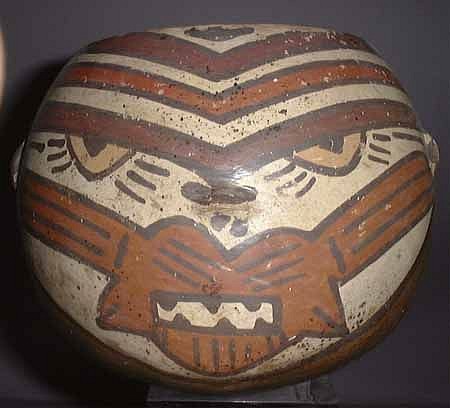
Peru, Nazca Ceramic Bowl with puma head wearing a mouth mask
This large and colorful bowl is decorated with a feline type face wearing a fanged mouth mask with flaring whiskers. The nose, ears and chin are subtly raised. The forehead is decorated with a succession of chevron stripes and the back of the vessel is decorated with two series of semi-circular motifs floating on a band of warm dark brown. The shape of the vessel is globular and the color scheme is maroon, sienna, cream, tan and black. Trophy heads are represented with the most frequency on these vessels. With the exception of foxes, animal portrait masks are seldom represented on this type of vessel. Ceramic vessels with similar masked iconography are featured in "Nasca Geheimnisvolle Zeichen im Alten Peru," Museum Reitberg Zurich, 1999 (exhibition catalog).
Media: Ceramic
Dimensions: Height 6 1/2" x Diameter 6 1/2"
Price Upon Request
97130
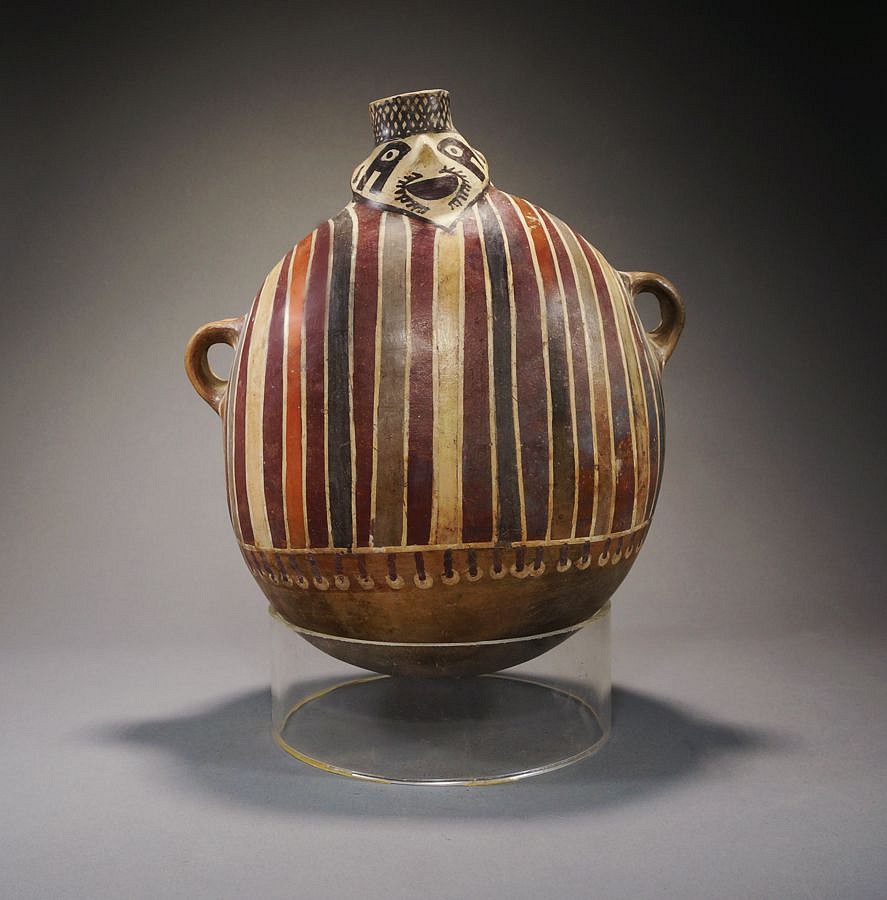


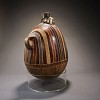

Peru, Nazca lug handled vessel wearing a striped tunic
The figure is wearing a woven read headband and has a painted mustache with bird head decoration for his eyes. He is wearing a colorful stripped tunic with fringe, which is typical for Nazca weaving. This lug handle vessel was made for carrying Chicha or corn beer with a temp line passing through the lug handles so that it could be carried on a person's back.
A similar vessel wearing a tunic is illustrated in CATA PGP DE A CERA OCA MAZCA, by Concepcion Blasco Busqued, 1991, Madrid, pg 94.
Media: Ceramic
Dimensions: Height 11" x Width 10"
Price Upon Request
n3042
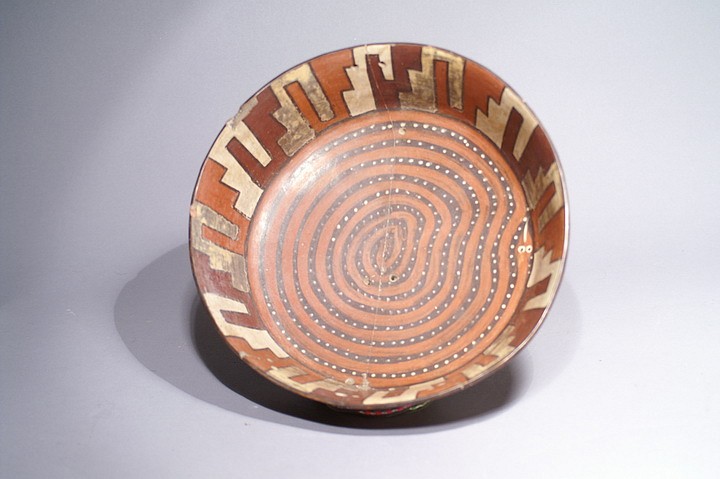
Peru, Nazca Polychrome Dish with Serpent Motif
This wonderful Nazca ceramic dish is painted with a spiral serpent motif at the bottom. The serpent is painted with a pattern of white dots. The inner edge of the dish’s high wall is painted with a step-fret pattern in alternating in colors of maroon, white and orange. The step-fret motif likely represents stairs to a temple or stepped agricultural plains, both of which were important to the Nazca. On the outside rim of the dish are 10 painted zoomorphic faces with long noses. The bottom of the dish is painted black. There is evidence of ancient repairs made to the dish, which can be seen via small drill holes made on each side of a crack and binding applied to the crack. Benno Mattel collection, Punta del Este, Uruguay.
Media: Ceramic
Dimensions: Diameter 9 1/2" x height 2 1/2"
Price Upon Request
N1032
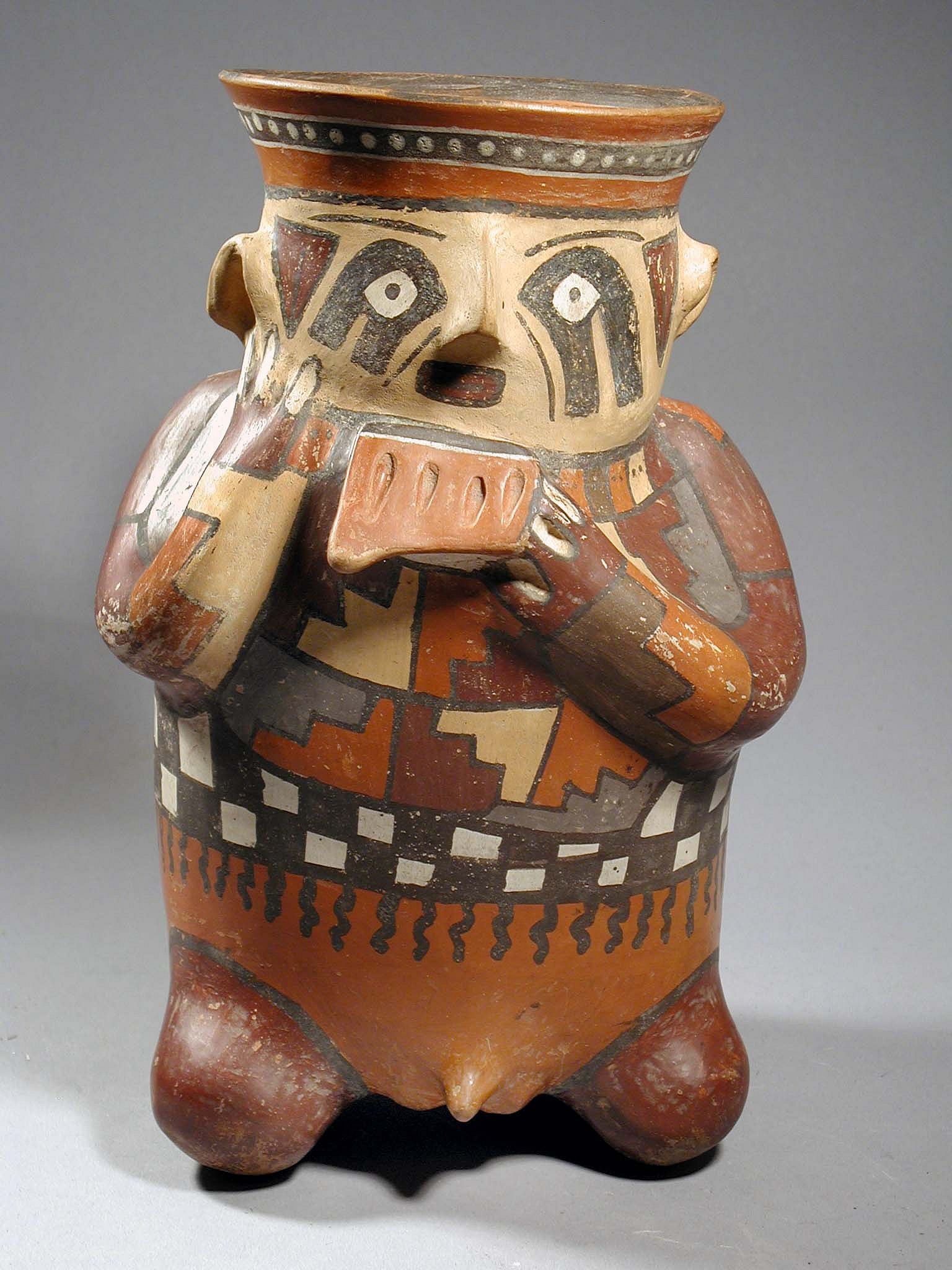




Peru, Nazca Polychrome Effigy Jar with Flute Player
This is one of the few effigy figures in the Nazca ceramic sequence that portrays a musician. The figure is holding a five chambered panpipe in his right hand and has his left hand to his cheek. He is elaborately dressed in patchwork tunic, with a black and white checkered undergarment. Around his neck is a series of plaques in alternating colors of beige, brown and gray. On top of his head is a polka dot band in grey. Below he is wearing a red/brown loin cloth covering prominent genitals. The musician has facial decoration, including black condor profile heads around the eyes and red triangles in front of his ears. This figure is illustrated by Lavalle "Nazca" (1986: 132).
Media: Ceramic
Dimensions: Height 9 1/2"
Price Upon Request
M3015
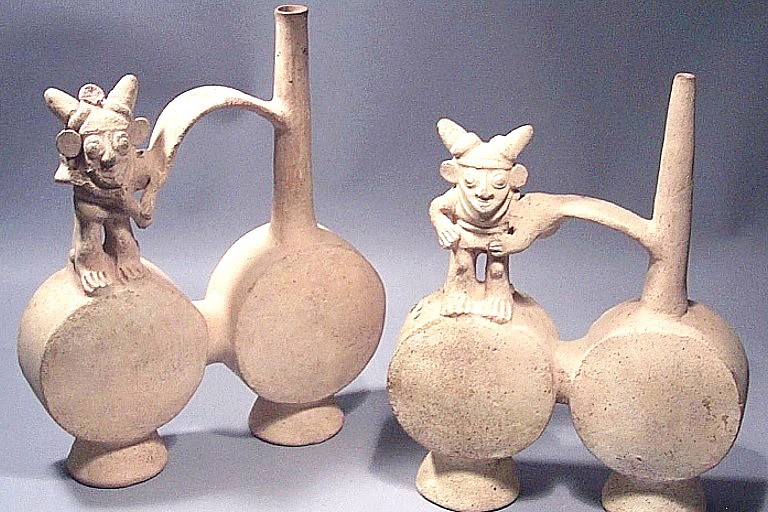
Peru, Pair of Chancay White, Double-chambered Whistling Vessels with figures
It is a rarity to find ceramic vessels in pairs that provide such excellent examples of the elegantly restrained aesthetics of the classic Chancay style. The presence of the musician figures atop one of the chambers on each vessel attests to the Chancay artist's stylish wit that cleverly enforces the sibilant properties of the vessels. Each is comprised of two circular chambers that connect at the sides. Each chamber sets on its individual pedestal, and a bridge handle links a tall conical spout on one of the chambers to a decorative musician figure identified by his double cone headdress and large earspools. When liquid is poured from one chamber to another the air between them is displaced, resulting in a whistling sound made through a fipple under the figure. Ceramic vessels in the Chancay style are illustrated and discussed in "Contemporaneidad del Arte Chancay," Museo de Arte de Lima (1998).
Media: Ceramic
Dimensions: Height: 10" & 10 1/2"'
Price Upon Request
97000
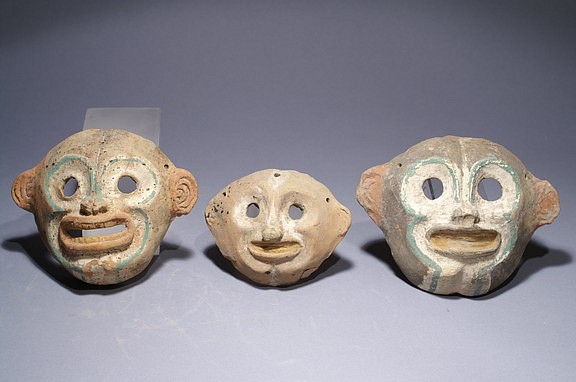
Ecuador, Pair of Jamacoaque Monkey Maskettes
These small monkey masks were decorated with post-fire pigments in blue, green, and white over a gray slip, and were probably headdress adornments for a larger ceramic effigy figure. The artisan clearly intended these masks to depict howler spider monkeys (Ateles paniscus), the largest primates in the New World. These monkeys prefer the branches of the upper forest canopy, where they feast on ripe fruit supplemented by leaves and insects. In the Amazonian mythology monkeys are associated with creator deities and cultural heroes who bestowed gifts of abundance. Monkeys were understood by ancient Andeans to be older spirits reincarnated from a mythical period prior to the presence of human beings on earth. For further reading on the legends of tropical peoples see Klein and Cevallos’ "Ecuador: The Secret Art of Pre-Columbian Ecuador," 2007, page 25.
Media: Ceramic
Dimensions: Height: 3" to 4"
Price Upon Request
M7102AB
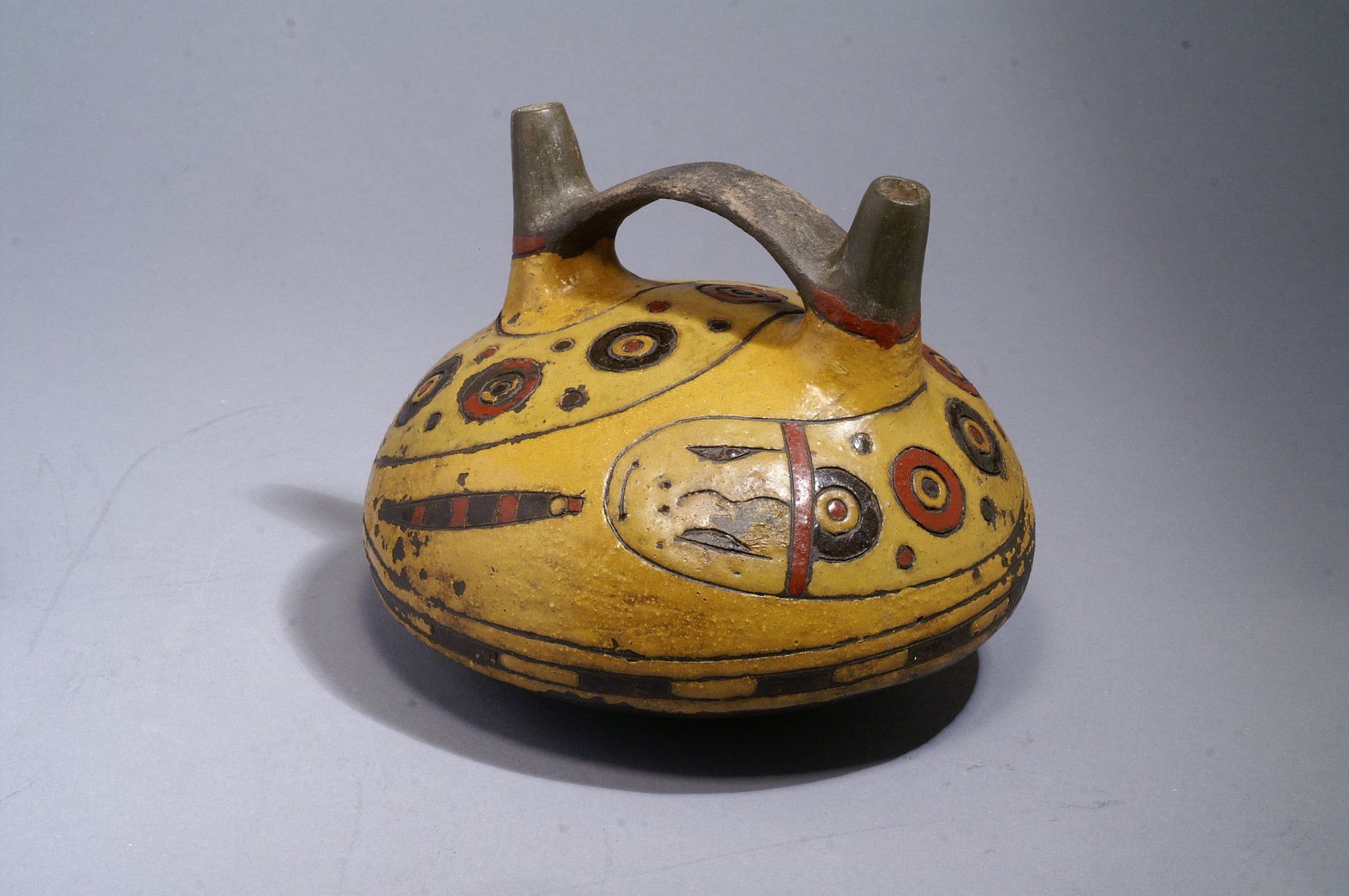



Peru, Paracas Bridge Spout Vessel Painted with Double-headed Undulating Eel
This vessel was painted with two neighboring hues of neutral yellow resinous paint, one for the ground and the other for the double-headed serpent. The rare color palette of this vessel departs from that of most Paracas vessels, which generally employ starkly contrasting colors. The animal depicted in the painting is probably an Amphisbaena, a species of worm-like snakes whose tails resemble heads as an evolutionary adaptation to fool predators. Acquired from a Miami collector in 2006.
Period: Peru, Paracas, Ocucaje Phase 9, Ica valley, South Coast, c. 300 - 200 BC
Media: Ceramic
Dimensions: Diameter: 6 1/4" x Height: 5"
$8,750
M6088
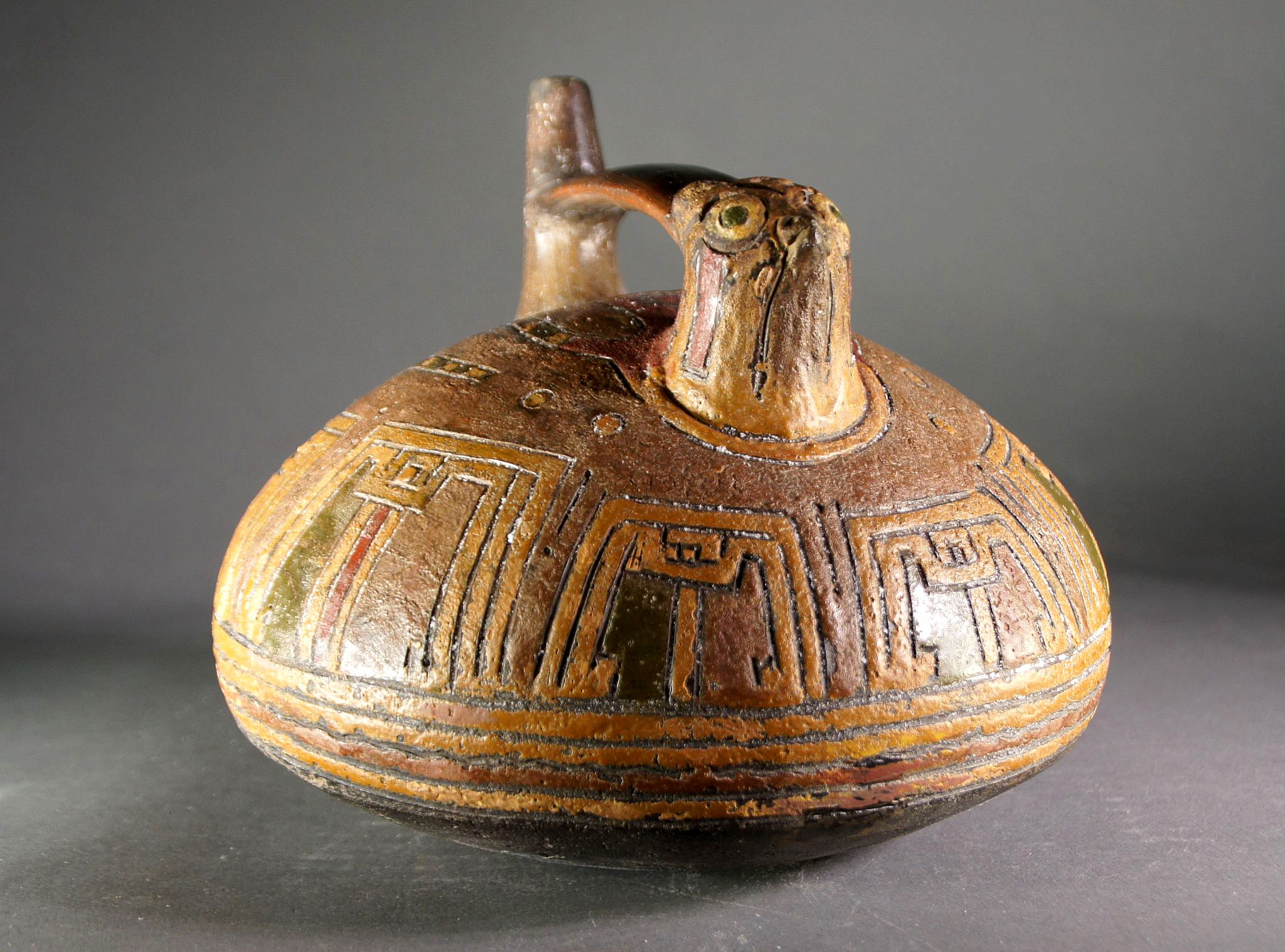







Peru, Paracas Bridge Spout Vessel with Falcon's Head
Peru, Paracas, Upper Callango basin phase 8, South Coast, c. 700 - 200 BC
This beautiful ceramic blind bridge spout vessel is crafted in the shape of a falcon with a sculpted head and incised drawings to create the falcon’s body and wings. The chamber was enhanced with a series of squarish "U" shapes, accented with a single Chavinoid eye in profile. The vessel is decorated with post-firing slip colors of red, green, brown, and tan. A similar vessel is illustrated ANCIENT PERUVIAN CERAMICS: THE NATHAN CUMMINGS COLLECTION, pages 116 & 117. A detailed discussion regarding these vessels can be found in THE PARACAS POTTERY OF ICA - A STUDY IN STYLE AND TIME on page 333.
Period: Peru, Paracas, Upper Callango basin phase 8, South Coast, c. 700 - 200 BC
Media: Ceramic
Dimensions: Height: 5 in. Diameter: 6 in.
Price Upon Request
n2044C
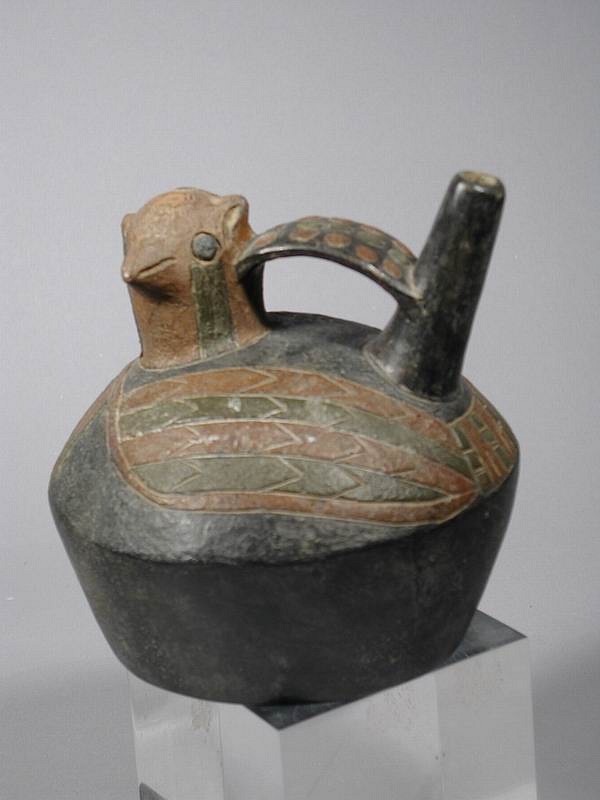





Peru, Paracas Falcon Effigy Vessel
This Paracas vessel has a blind-spout in the form of a falcon with pointed ears. The compressed, ovoid-shaped body was decorated with resin, painted, and incised, directly below the bridge spout handle. The chamber was enhanced with a series of squarish "U" shapes, accented with a central red stripe flanked by blocks of dark olive green and yellow ochre. These geometric configurations could be interpreted as highly abstracted bird forms and their presence is consistent within the development of the Phase 8 ceramic style. The use of resin painted designs outlined by incisions, referred to as "zoned" design, can also be assigned to Phase 8. Excellent literature and illustrations of the various phases of Paracas style ceramics are provided in Menzel, Rowe and Dawson's "The Paracas Pottery of Ica: A Study in Style and Time," 1969. Acquired by David Bernstein in 1994.
Period: Peru, Callango style, Paracas, South Coast, c. 700 - 500 BC
Media: Ceramic
Dimensions: Height 4 5/8"
$2,800
94131
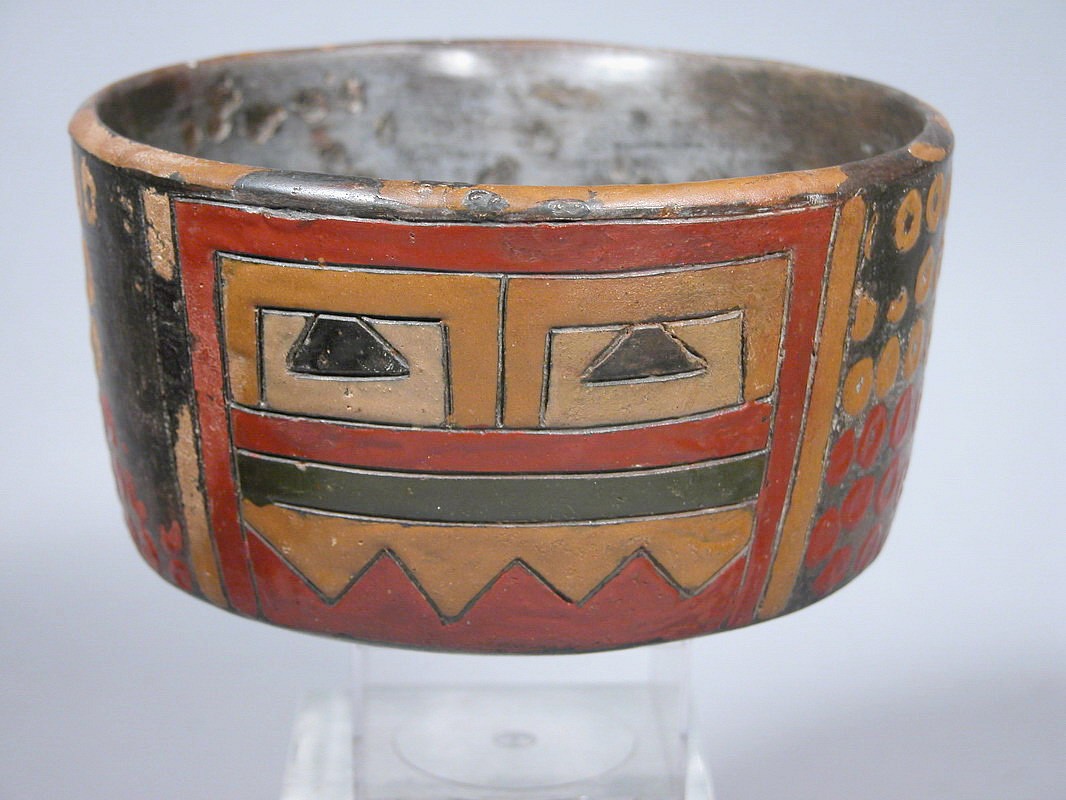

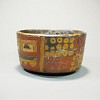


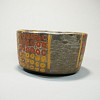
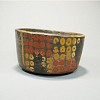
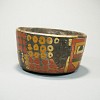


Peru, Paracas Polychrome Bowl with Incised Mask Design
This Paracas bowl was decorated with an abstracted geometric mask painted in rich post-fire pigments of red, ochre, olive green, and buff. The bowl also features geometric checkerboard patterns to the left and right of the face. There is a slight lip on the upper rim for pouring or drinking ritual libations. Abstract geometric vessels such as this were highly sought after by European and American painters during the heyday of the Modernist movement in the early and Mid-20th Century. A similar example is on display at the Metropolitan Museum of Art in New York and is illustrated in Alan Sawyer's, "Ancient Peruvian Ceramics," 1966, on page 74. This vessel has excellent provenance. It was acquired prior to 1970 and was loaned by the Landmann family of Westchester, NY, to the American Museum of Natural History in New York, where it was on view from 1984 to 1994.
Period: Peru, Paracas, Late Phase, South Coast, c. 300 - 200 BC
Media: Ceramic
Dimensions: Height 3.14" Diameter 5.3/4"
$16,500
94081
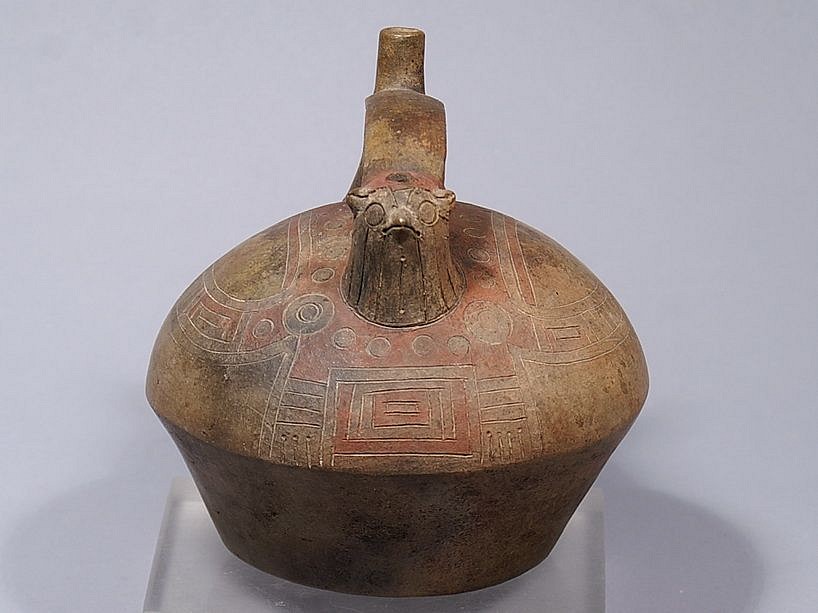







Peru, Paracas, Juan Pablo Style Falcon Bridge-spout Vessel
The blind spout at one end of the bridge handle of this vessel is modeled with a falcon's head, a typical feature of the Early Paracas style found at the Juan Pablo site. The surface on the upper body of the vessel has been delicately incised and painted to show the outstretched wings and tail feathers of the falcon. The falcon's body is decorated with circular pelt markings in a precise arrangement, with clearly delineated talons. The lower portion of the body has been left undecorated, as it would have been buried in the desert sand. The overall color scheme consists of red, orange, ochre, black, and cream pigments. This is a beautifully preserved example of Phase 3 of the Early Paracas period, in contrast to most Juan Pablo vessels which have been heavily restored. Similar examples of this style are illustrated and discussed in Alan R. Sawyer's "Ancient Peruvian Ceramics: The Nathan Cummings Collection," published by The Metropolitan Museum of Art, New York in 1966. Ex Collection of Jerome Pustilnik, acquired from Alan Lapiner prior to 1970.
Period: Peru, Paracas, Ocucaje, South Coast, c. 300 - 200 BC
Media: Ceramic
Dimensions: H. 5 3/4 x L. 5 1/2 in.
$8,500
91002
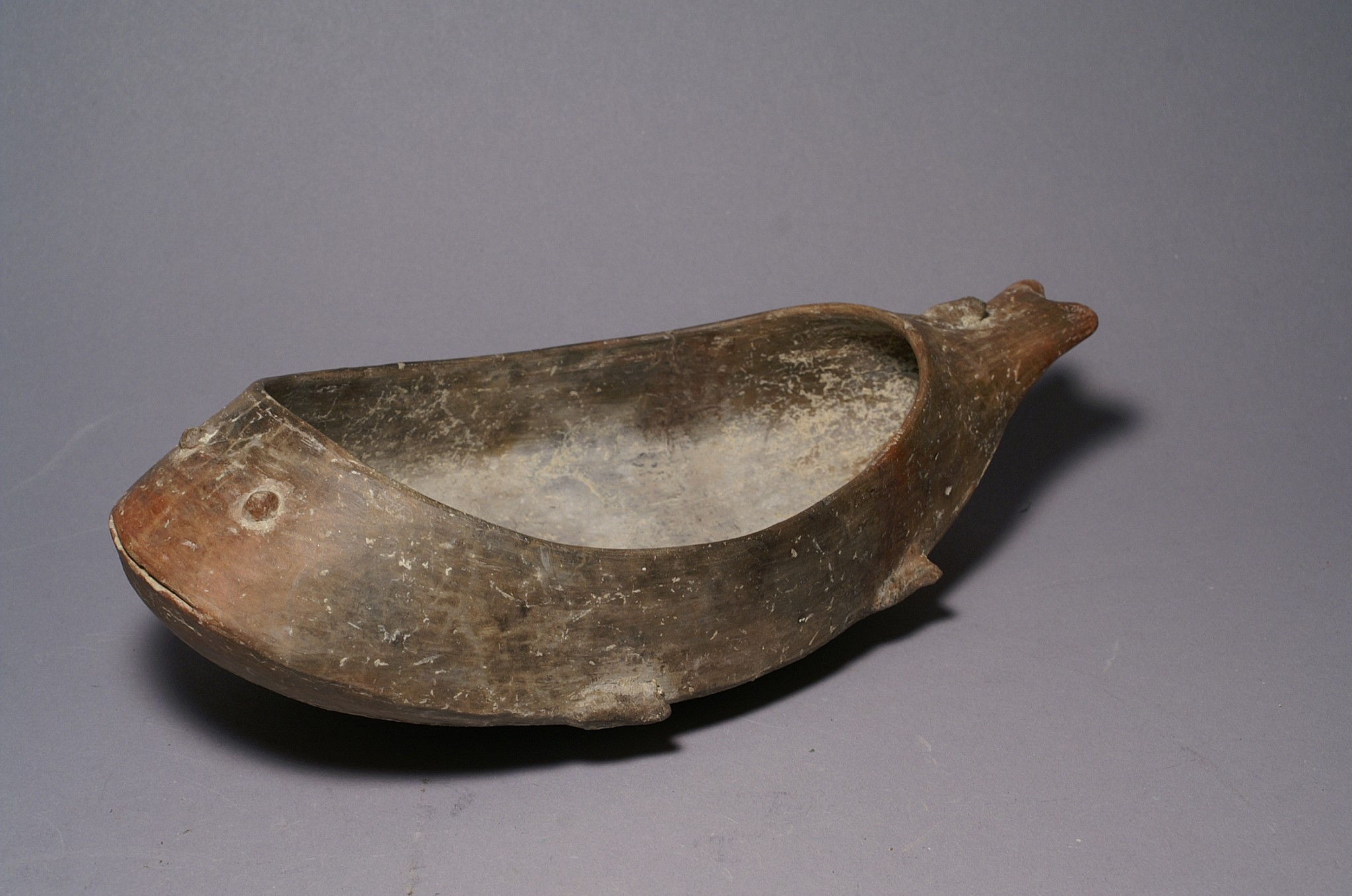





Ecuador, Pompano Fish Bowl
This is an early example of Chorrera ceramics, depicting a Pompano. Pompano are found in warm waters along the Pacific and Atlantic; they appear in larger numbers during El Niño currents. Illustrated in OCEAN FISHING IN PRECOLUMBIAN CHILE AND PERU.
Media: Ceramic
Dimensions: Length: 9 3/4" inches
Condition: All parts original.
$3,250
M7154
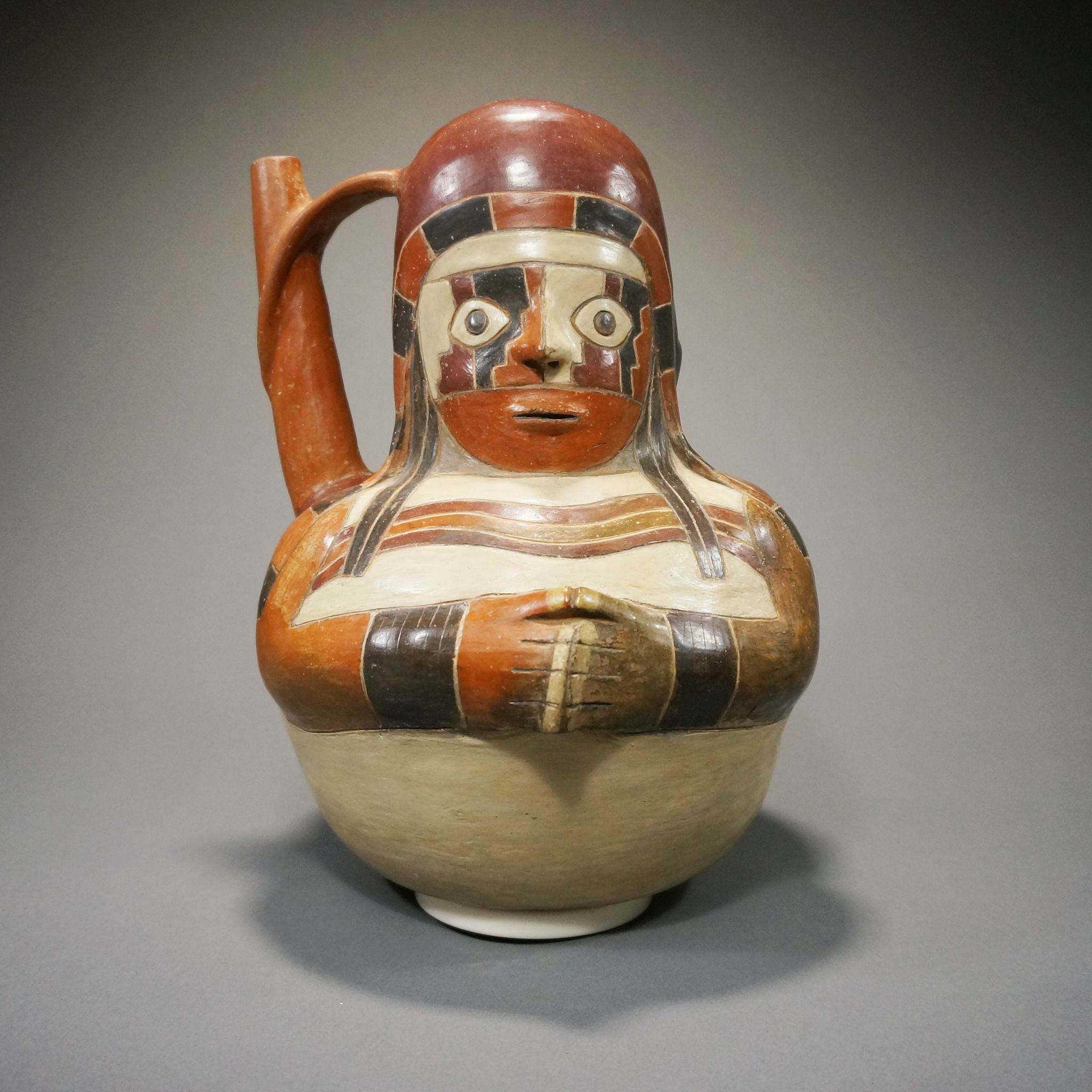
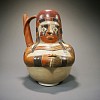


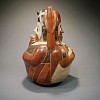
Peru, Proto Nasca Janus Head Effigy of a Smoker
This rare Nasca Janus-headed shaman has two faces, one on either side; both faces depict the same individual who morphs in behavior as the vessel is rotated, telling a narrative story. At the starting side of the narrative, the shaman is smoking a psychoactive plant, possibly tobacco combined with another entheogen. When the vessel is rotated, the same shaman has his face painted and is starring as if he is in a trance. In addition, he is seen wearing an elaborate ritual garb that includes a headdress, a face mask with a step-fret design, and a band of three waved lines across his chest. These garments were not every day utilitarian clothing, and instead indicate a ritual shamanic costume reserved for important ceremonies. The archaeological record indicates that many ancient Andean cultures may have smoked or drank preparations that contained mixtures of tobacco combined with other psychoactive substances. There are very few representations of people smoking in Andean art, but the Spanish chroniclers describe the prevalence of smoking tobacco among the Inca. The early date of this ceramic suggests the use of tobacco in Pre-Columbia as early as AD 100. Acquired in 2004 in Paris. Formerly in the collection of Jean Lions.
Period: Nasca, Proto Phase, South Coast, c. 100 BC - AD 200
Media: Ceramic
Dimensions: Height: 10 1/4"
$28,000
M4047
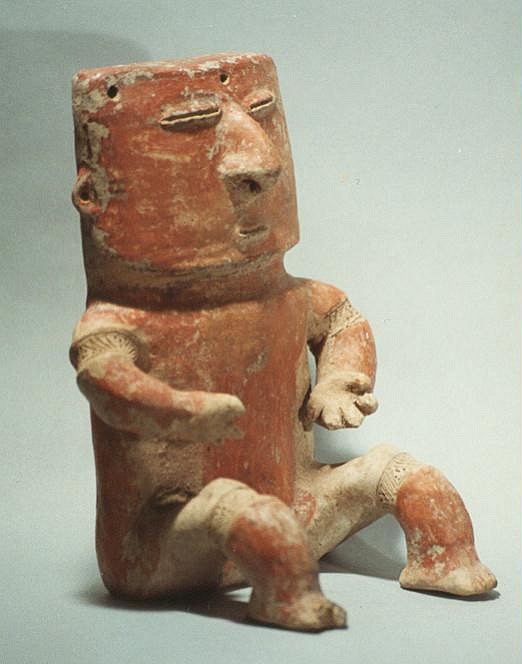


Colombia, Quimbaya Seated Male Warrior with Gold Nose Ornament
This male figure sculpted in solid red clay is in a sitting position with outstretched hands. He is wearing his original ancient gold crescent nose ring. His arms and legs are decorated with incised geometric banded depressions, representing ligature bands intended to constrict the flow of blood. It was believed that this strengthened the adjacent muscles. Similar examples are illustrated in "Columbia Before Columbus," by Armand J. Labbe, Rizzoli, NY 1986, p. 75.
Media: Ceramic
Dimensions: Height 8 in. x Width 7 in.
$4,800
94272B
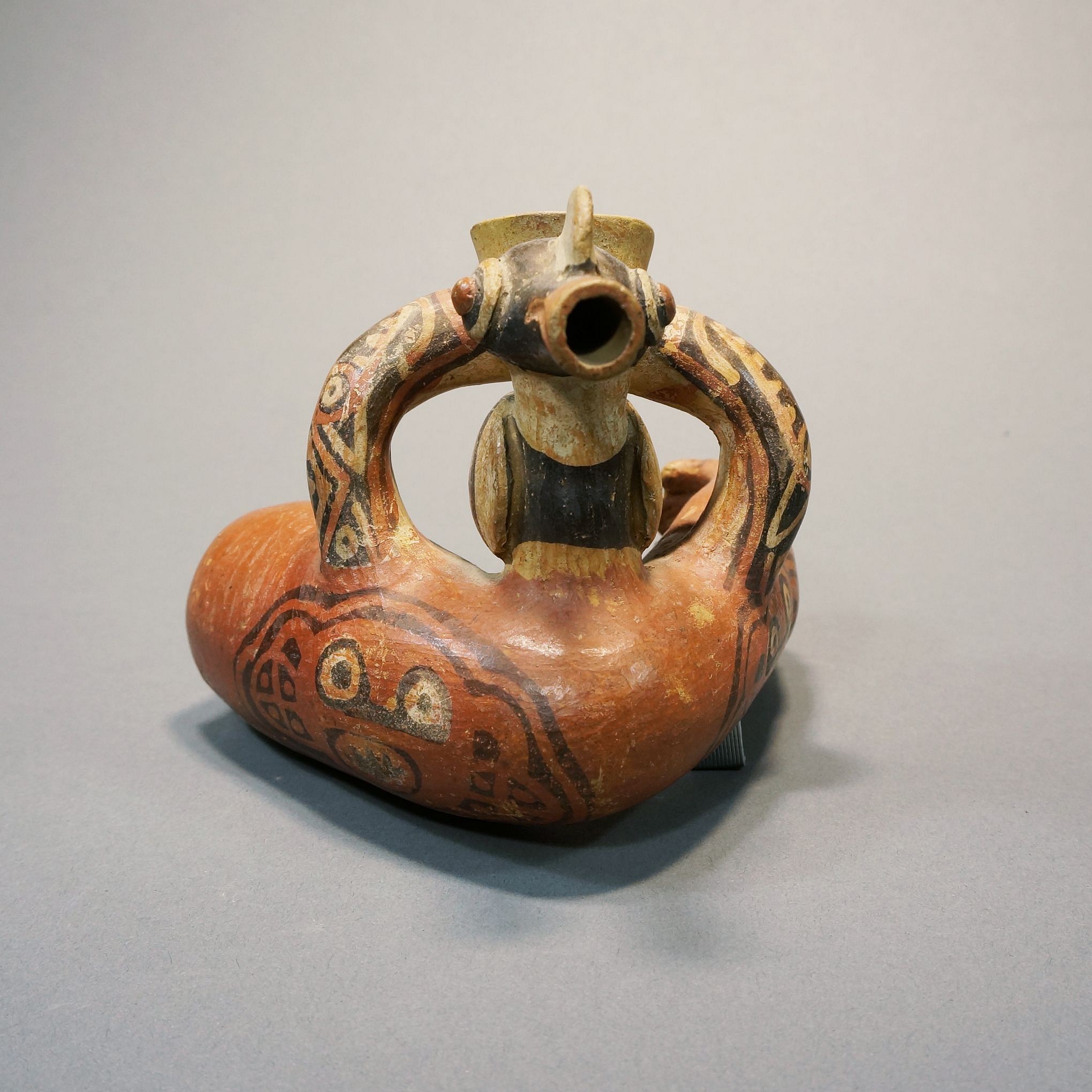
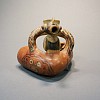
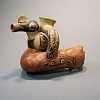
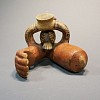
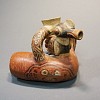
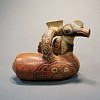
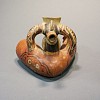


Peru, Recuay Bridge Spout Effigy Vessel
This unusual figurative effigy depicts a clenched human arm decorated with a tattoo of a face with ear spools and a large-eye condor siting under the bridge spout.  The painted face is referred to as the "circular head motif" and signifies a celestial deity (Grieder, Terrence, The Art and Archaeology of Pashash, 1978). The condor is the largest and most powerful bird in the Andes. The clenched fist motif depicts a severed bone, the meaning of which is not clear, however, condors were known to eat the remains of sacrificed captives.  A similar example is in the Berlin Volkeunde museum and is illustrated in KULTUREN RECUAY IV by Deiter Eisleb, pg.194.
Media: Ceramic
Dimensions: Height 4 1/8"
$3,500
96148
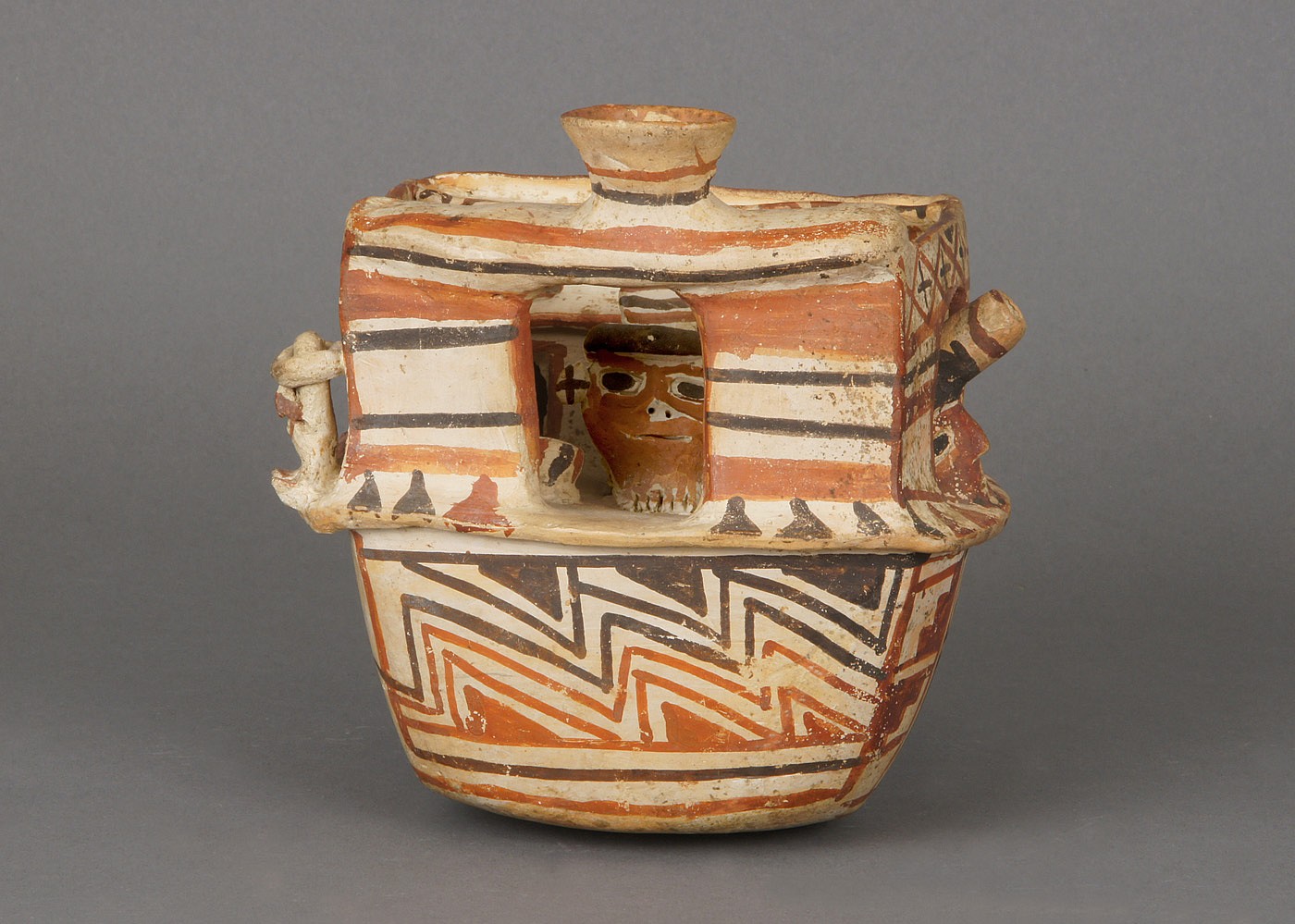









Peru, Recuay Ceramic House Scene
Creamware with geometric painted designs in red, orange and brown polychrome. This is an elaborate house model with six figures modeled inside. This is one of the few houses with two windows and a door, as most of the known examples have only one opening. The house is also a good example of negative resist decoration, which was characteristic of Recuay ceramics. Similar examples are illustrated in Lapiner, "Pre-Columbian Art of South America" (1976: pls. 422 and 433).
Media: Ceramic
Dimensions: Length: 5 in x Width: 5 in. x Height: 5 in.
$8,000
M2032
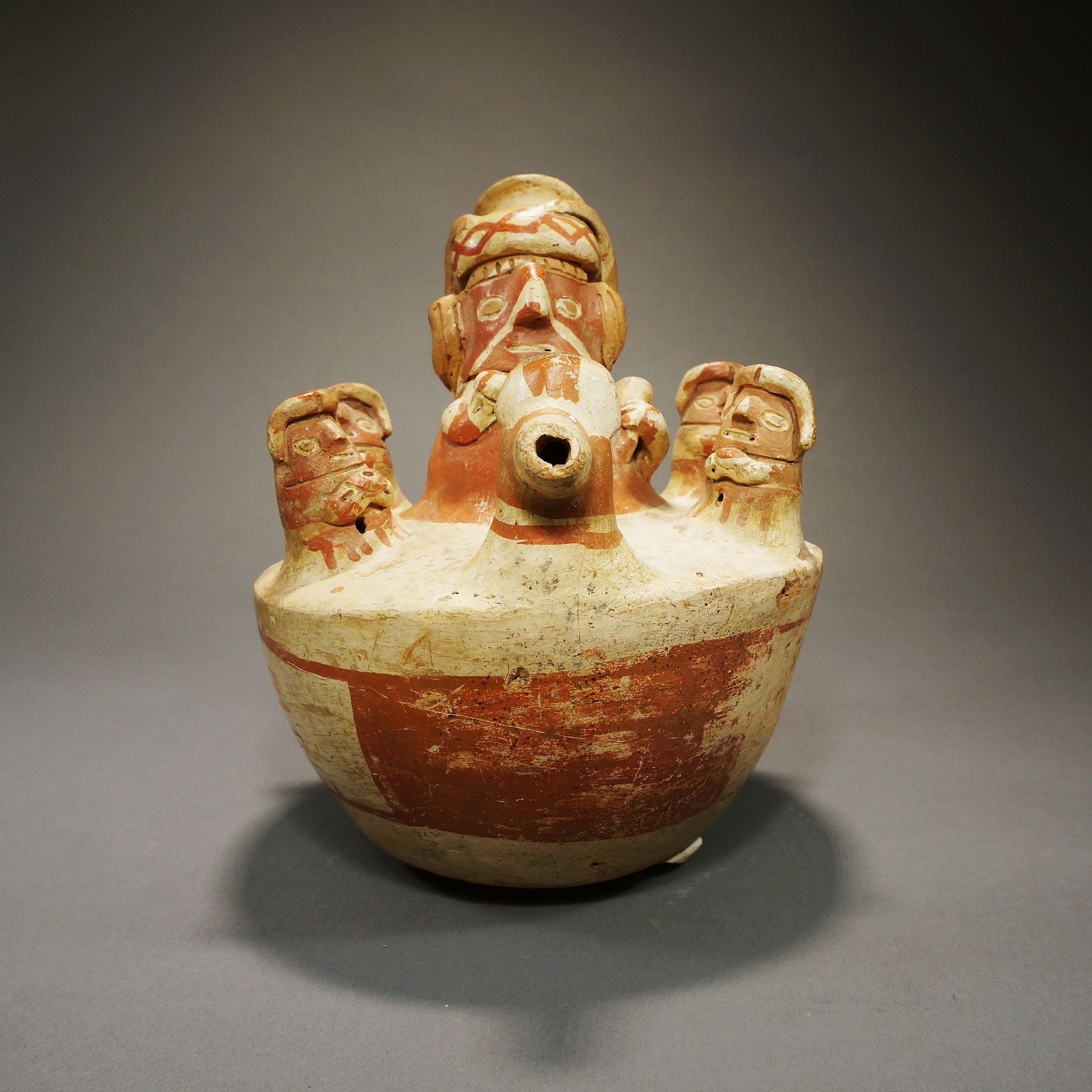
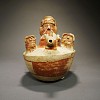
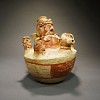
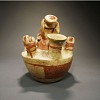



Peru, Recuay Ceremonial Procession or Audience Vessel
A shaman is the central figure surrounded by five attendants all holding what appears to be lime containers for the coca chewing ritual. The shaman is wearing an elaborate headdress while the attends are wearing cloth headdress. Decorated in orange slip on white ground. A very similar piece is illustrated in ALTPERUANISCHE KULTUREN - RECUAY IV pg. 117-120
Media: Ceramic
Dimensions: Height 8" x Diameter 6.5"
Price Upon Request
M9014
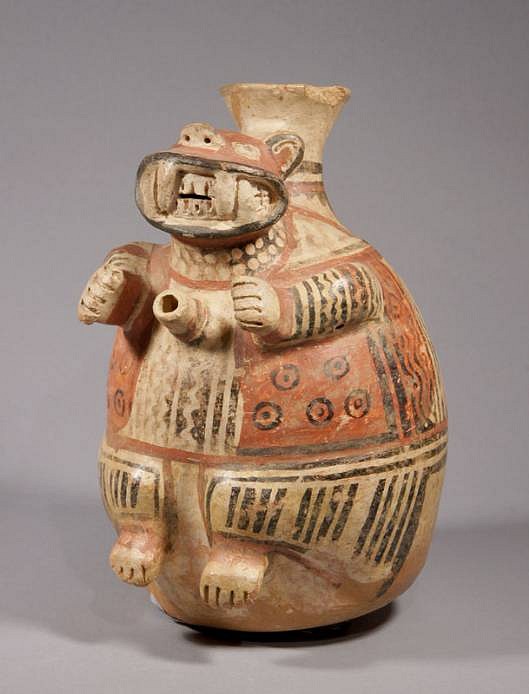







Peru, Recuay Mythical animal effigy vessel
The animal has attributes of a feline with oversized incisors and a long tail in the rear. The animal is anthropomorphic with human hands and feet displayed in a sitting position. He has red slip and negative resist decoration on a white ground. This motif is unusual in that the same posture is mostly represented by males on ceramics, while this is an animal. I know of other such examples illustrated in the literature.
Media: Ceramic
Dimensions: Height 8"
Price Upon Request
M9015
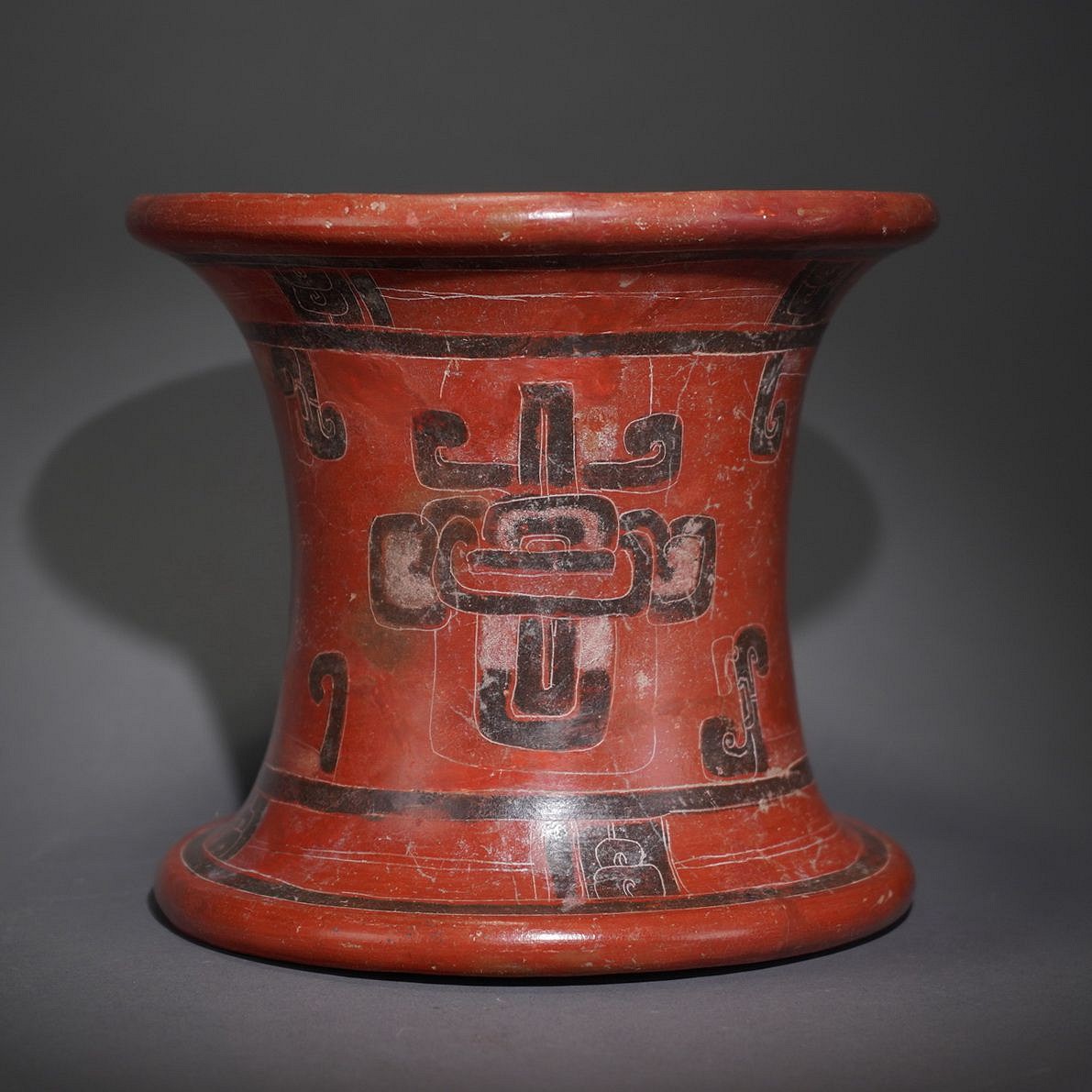
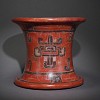
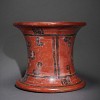
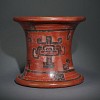
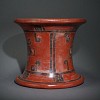
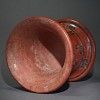
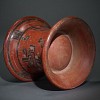
Costa Rica, Rosales Ceramic Pedestal Engraved with Glyph Designs
This pedestal is decorated with incised glyphs outlined in black on red ground in three registers. The Rosales artists' ceramics were highly prized and were traded throughout the Nacoya peninsula.
Media: Ceramic
Dimensions: Diameter 7 1/4" Height 6 1/2"
$4,450
94114
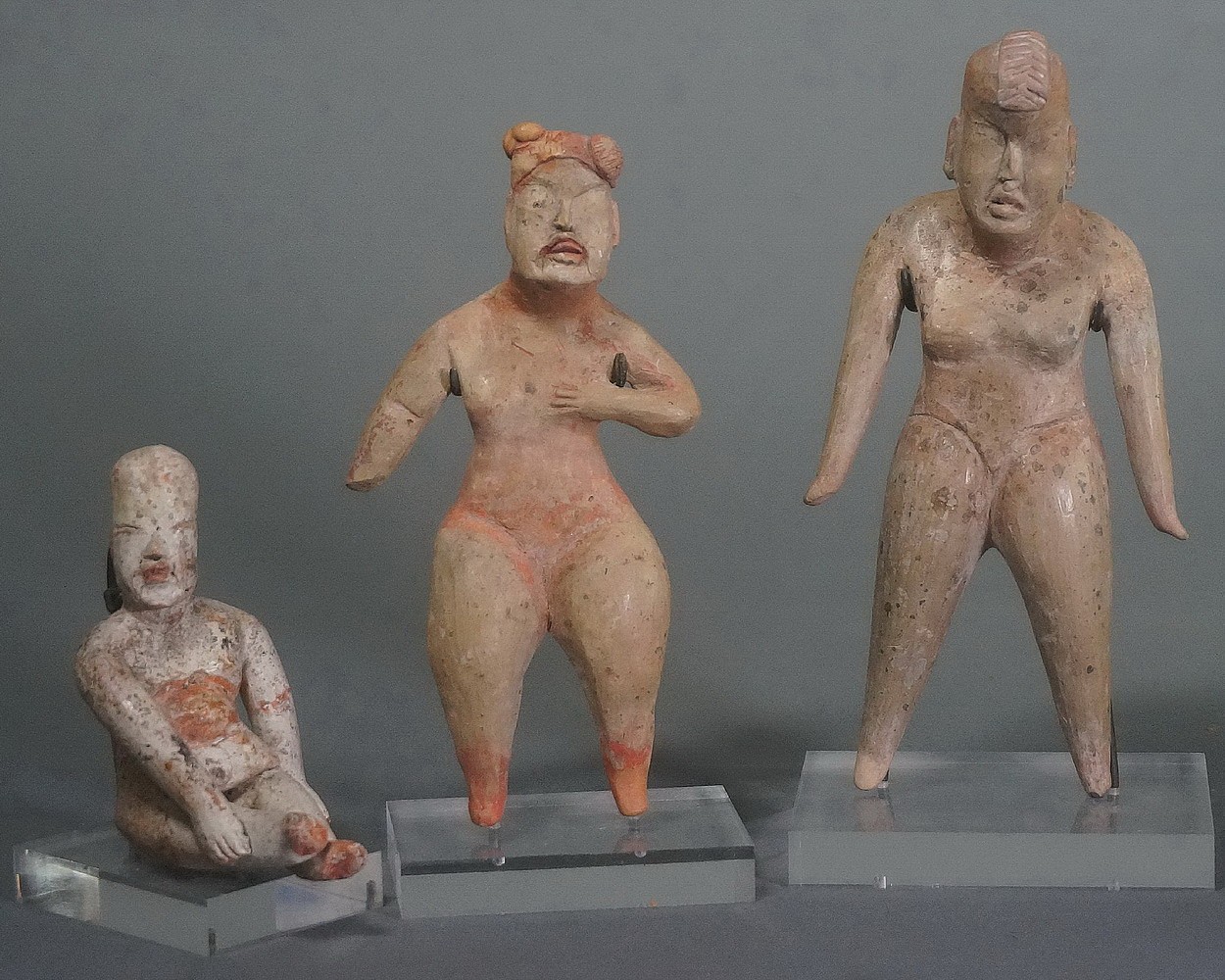






Mexico, Set of 3 Olmec Ceramic Figurines
These three figurines were exhibited together at Taguchi Fine Art in Tokyo and are illustrated in “JAGUAR'S CHILDREN: The Art of The Olmec,†May 7 - June 30, 2007. From left to right: seated cross-legged female with kaolin and cinnabar, standing eyeless female figure with traces of cinnabar, and standing figure with traces of kaolin slip.
Media: Ceramic
Dimensions: Height: 6.9 cm, 12 cm, and 13 cm.
Price Upon Request
n7064
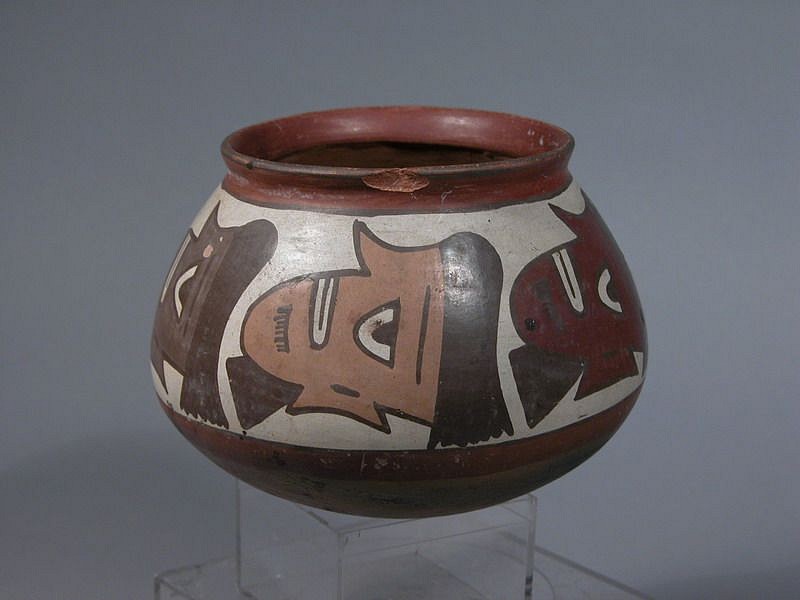




Peru, Small Nasca Bowl with Painted Trophy Heads
The trophy heads are in profile and alternating in red, grey and beige on a cream ground. Trophy head paintings by the same artist are in the Volkunde Museum in Berlin and are illustrated in ALTPERUANINISCHE KULTUREN –NAZCA II, in figures 120 & 121. Ex. collection Hans Monheim, Achen Germany.
Media: Ceramic
Dimensions: Height 3 3/4" x Diameter 3 3/8cm
Price Upon Request
M4035
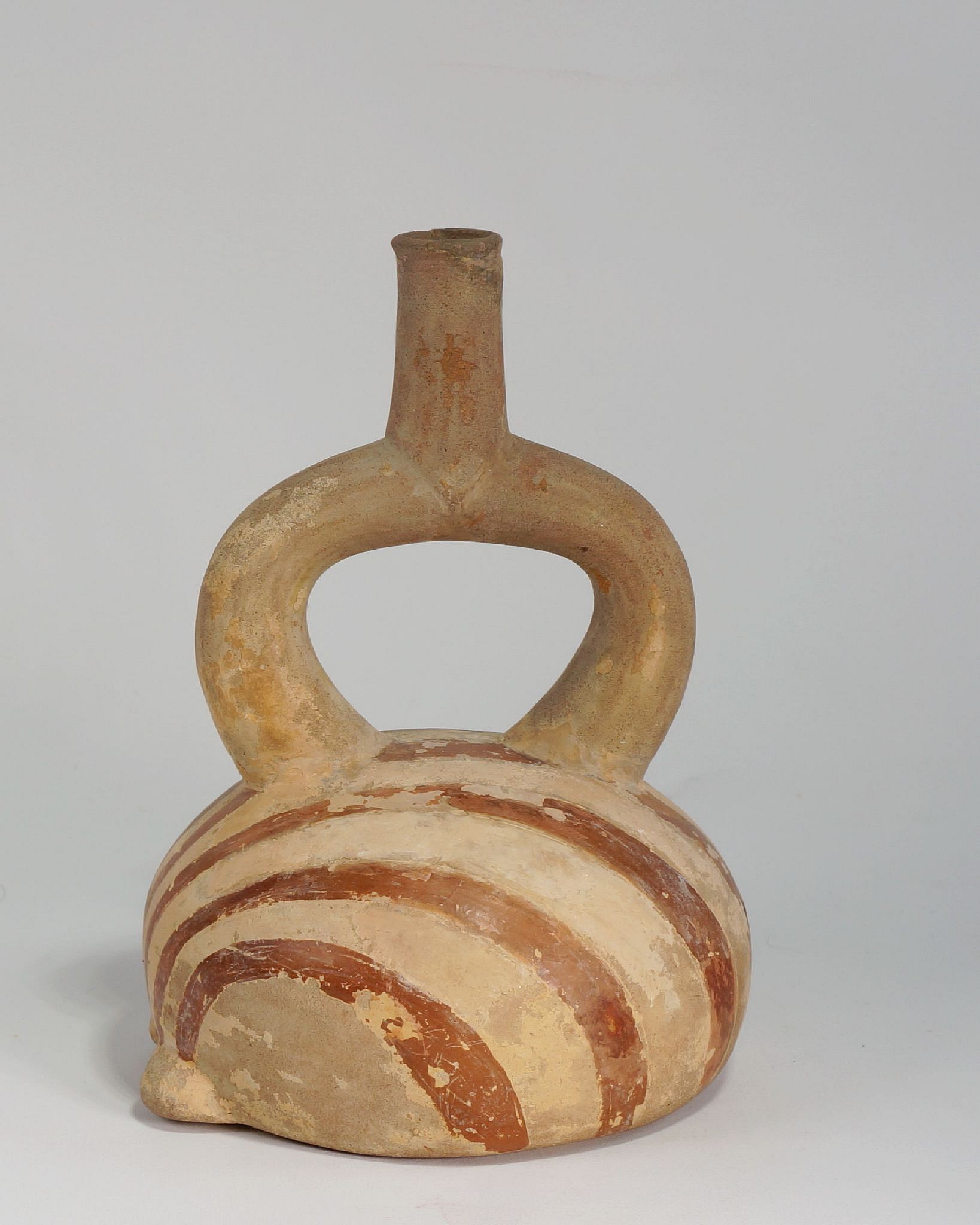




Peru, Stirrup Spout Vessel Depicting a Scallop
This elegant vessel is modeled after the Argopectin purpuratus (the Peruvian calico scallop). It is decorated with swirling painted stripes in brown slip on a cream ground and is a typical example of Moche realism. During El Niño events, bivalves proliferate along the coast; scallops are the most abundant species. The bivalves, in turn, attract octopi, which feed almost exclusively on these mollusks. Octopi are a frequent theme in Moche art. A similar example of a stirrup spout vessel in the form of a bivalve shell is illustrated in The Spirit of Ancient Peru: Treasures from the Museo Arqueologico Rafael Larco Herrera, edited by Kathleen Berrin (1997: fig. 41).
Media: Ceramic
Dimensions: Height 7"
Price Upon Request
95065
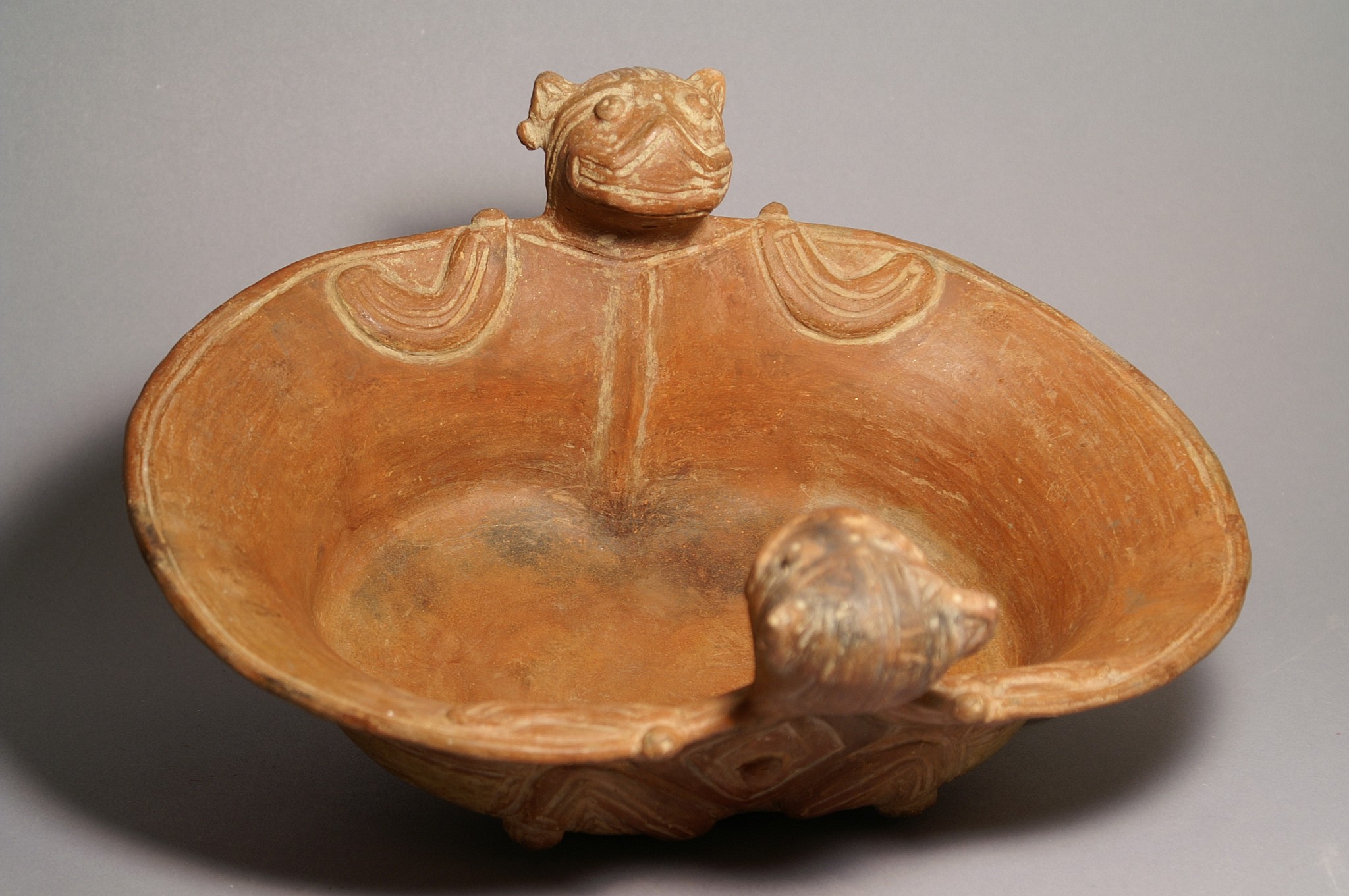



Colombia, Tairona Ceramic Tray with Bat Adornos
A redware ceramic tray embellished with two smiling bats with outstretched wings. The head and the body of the bat are decorated with incised lines, the back with a diamond-shaped motif. The outer wall of the bowl is incised with squarish scroll designs.
Media: Ceramic
Dimensions: L: 13", W: 10-1/2"
$8,000
94271
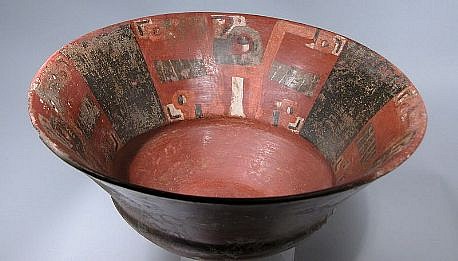




Bolivia, Tiahuanaco flared bowl with inner painted band of Condor and puma heads
A classic style flared bowl with flat base is described by Posnansky in "Tihuanacu, The Cradle of American Man" pl. XXXIVc. and "Tiwanaku, Citta eterna delle Ande" pg. 207 for illustration. From a Swiss collection for over 30 years.
Media: Ceramic
Dimensions: Diameter 13" x Height 6 3/4"
Price Upon Request
M4054
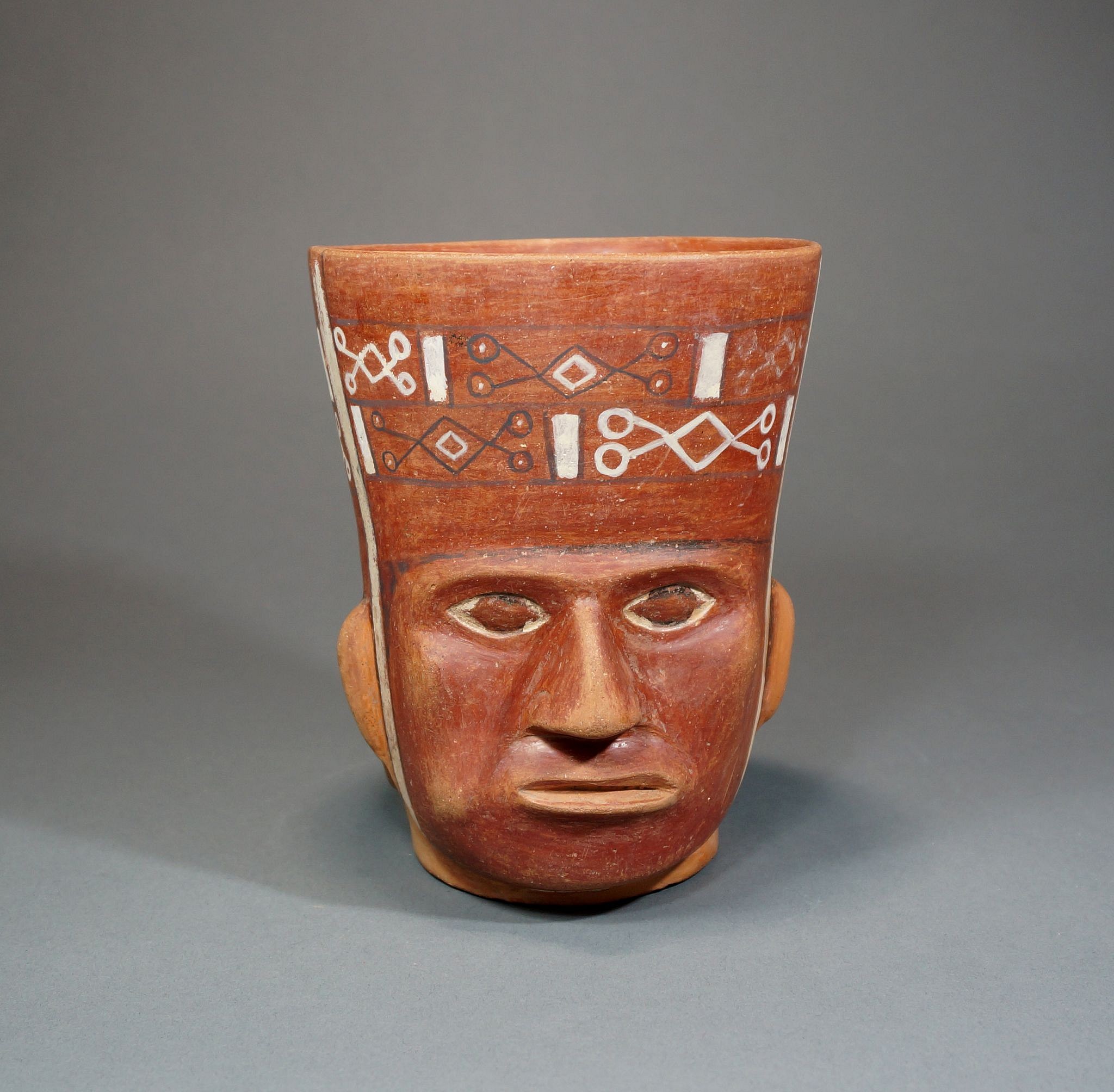





Bolivia, Tiawanaku Portrait Vessel Wearing a Woven Headpiece
This portrait vessel has a modeled coca leaf on the left cheek. A similar portrait vessel is illustrated in TIAWANKU, ANCESTORS OF THE INCAS, edited by Margaret Young-Sanchez (fig. 5.24). The portrait vessels from the Tiawanku culture must have been heavily influenced by the Moche People of the coast. Ex Collection Arthur Sackler prior to 1970.
Media: Ceramic
Dimensions: Height: 5 7/8", Diameter 4 3/4"
n2006
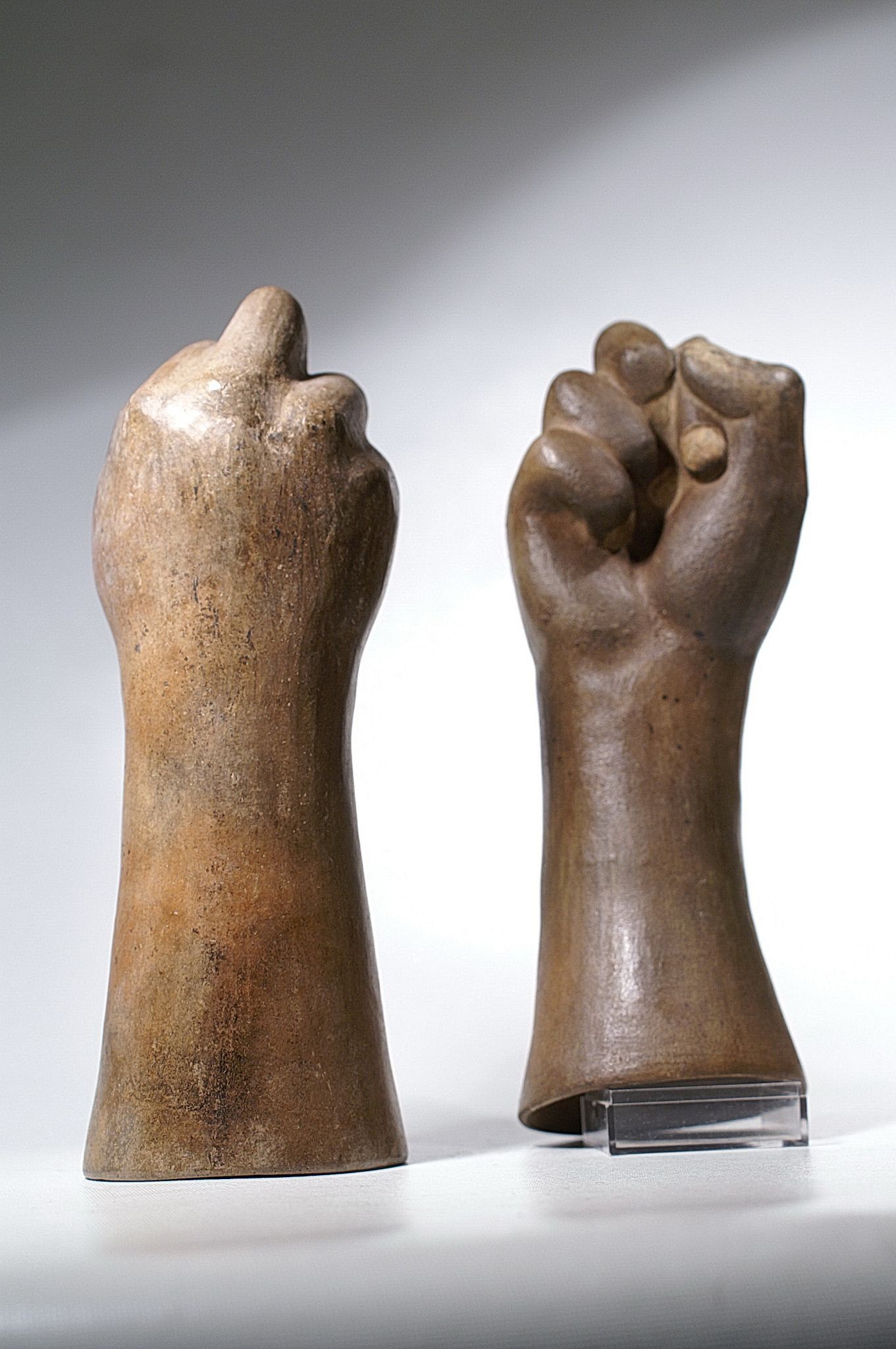





Peru, Two Moche Ceramic Hands with Clenched Fists
Although hands such as these are well documented for the Moche, it is rare to find two together from the same artist / workshop. The clenched fist, with raised middle knuckle, represents mountains and highland lagoons where sacrifices and divinatory rituals took place (Donnan, Moche Art of Peru 1978: 152-153 and fig. 235). Christopher Donnan further discusses the symbolism of such hands in "Andean Art at Dumbarton Oaks (1966: I: 136-139), where a bone carved as a clenched fist was studded with inlays of precious turquoise.
Media: Ceramic
Dimensions: Height 10"( 25cm) and Height 9 3/4"(24 cm)
Price Upon Request
M6064
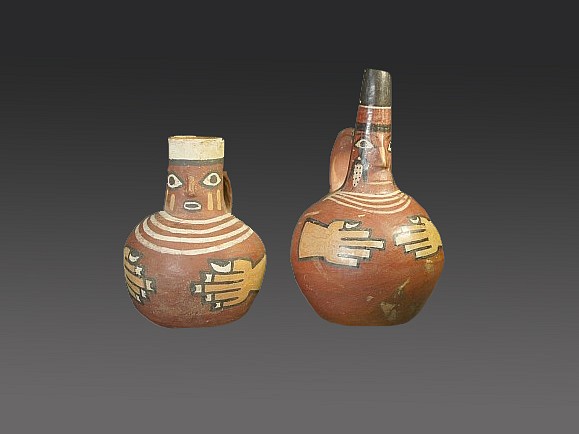

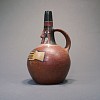
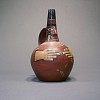
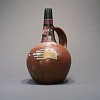
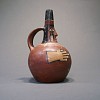
Peru, Two Wari Strap Handle Effigy Vessels with Faces on Spouts
Two lovely miniature single spout vessels depicting corn gods. Both are wearing 5 strand necklaces nicely tied at the back. These are stunning examples done in miniature with gestures of exaggerated hands holding the stomach as is after a feast. There is a group of Wari vessels which have necklaces and large hands, which could mean that they came from the same tomb. A similar example is illustrated in WARI LORDS OF THE ANCIENT ANDES. Pg 83. T-L tested in Berlin.
Media: Ceramic
Dimensions: Height 6 3/4"
Price Upon Request
94120A
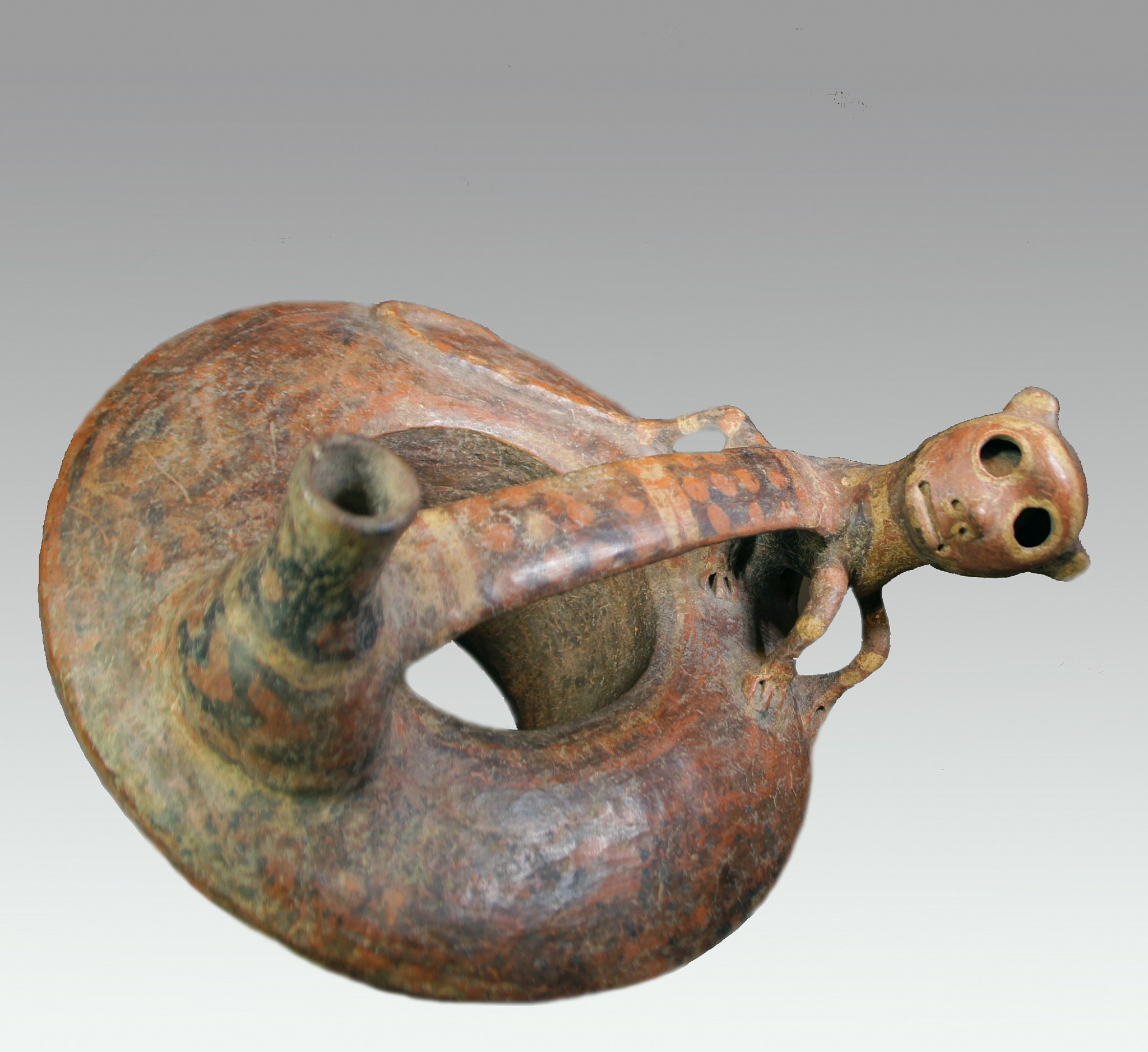





Peru, Vicús Donut-shaped Whistle Vessel with Monkey
This donut-shaped whistle vessel has a monkey figure one side of its bridge spout and the mouthpiece at the other end. The monkey sits on top of the vessel, with its head slightly tilted, hunched on its hind legs and placing his front legs forward and spread apart. The design motif consists of negative resist decoration. There is a whistle inside the monkey (not working) and would operate when the fluid inside the vessel moved the air out through it. A similar example can be found in Lapiner's "Pre Colombian Art of South America" pls.456 & 459. The piece has a crack on the bottom, which has been restored.
Media: Ceramic
Dimensions: Diameter 8 1/2 x h.7 in.
$3,300
92233
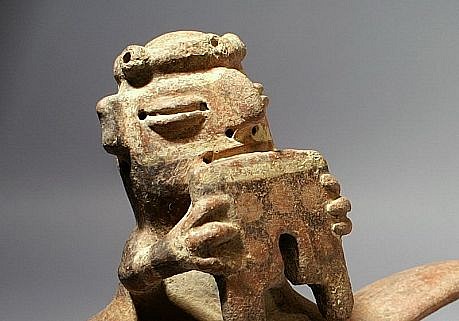




Peru, Vicus Double Chambered Whistling Vessel of a Figure Playing a Panpipe
This is the most published image of a whistling vessel from the early Vicus culture, but in actuality very few exist.
Media: Ceramic
Dimensions: Length: 11 1/2 in. x Height: 7 in.
$4,500
M2096
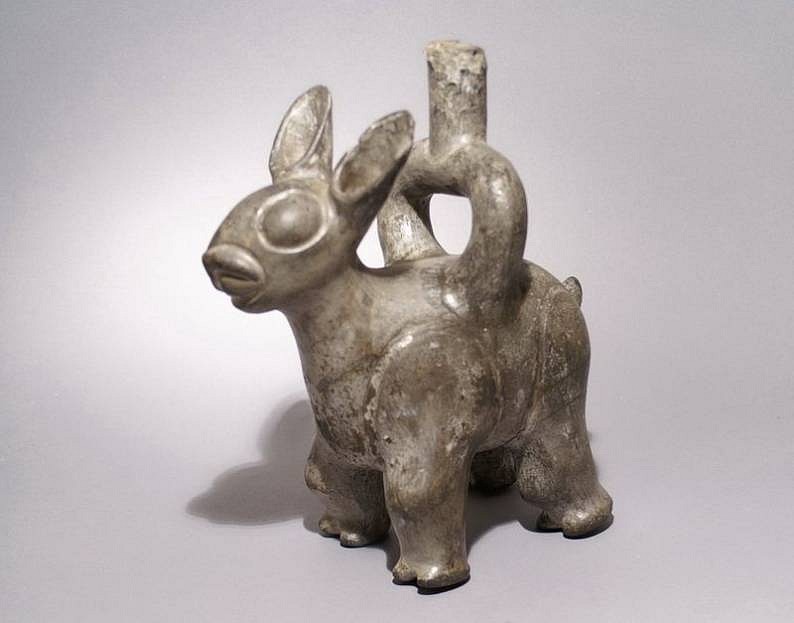




Peru, Viru ceramic greyware single spout vessel in the form of a Viscaya
A ceramic single spout vessel in the form of a standing Viscay, a large member of the rabbit family, noted by its long ears.
Media: Ceramic
Dimensions: H. 9 1/2
$7,500
92047
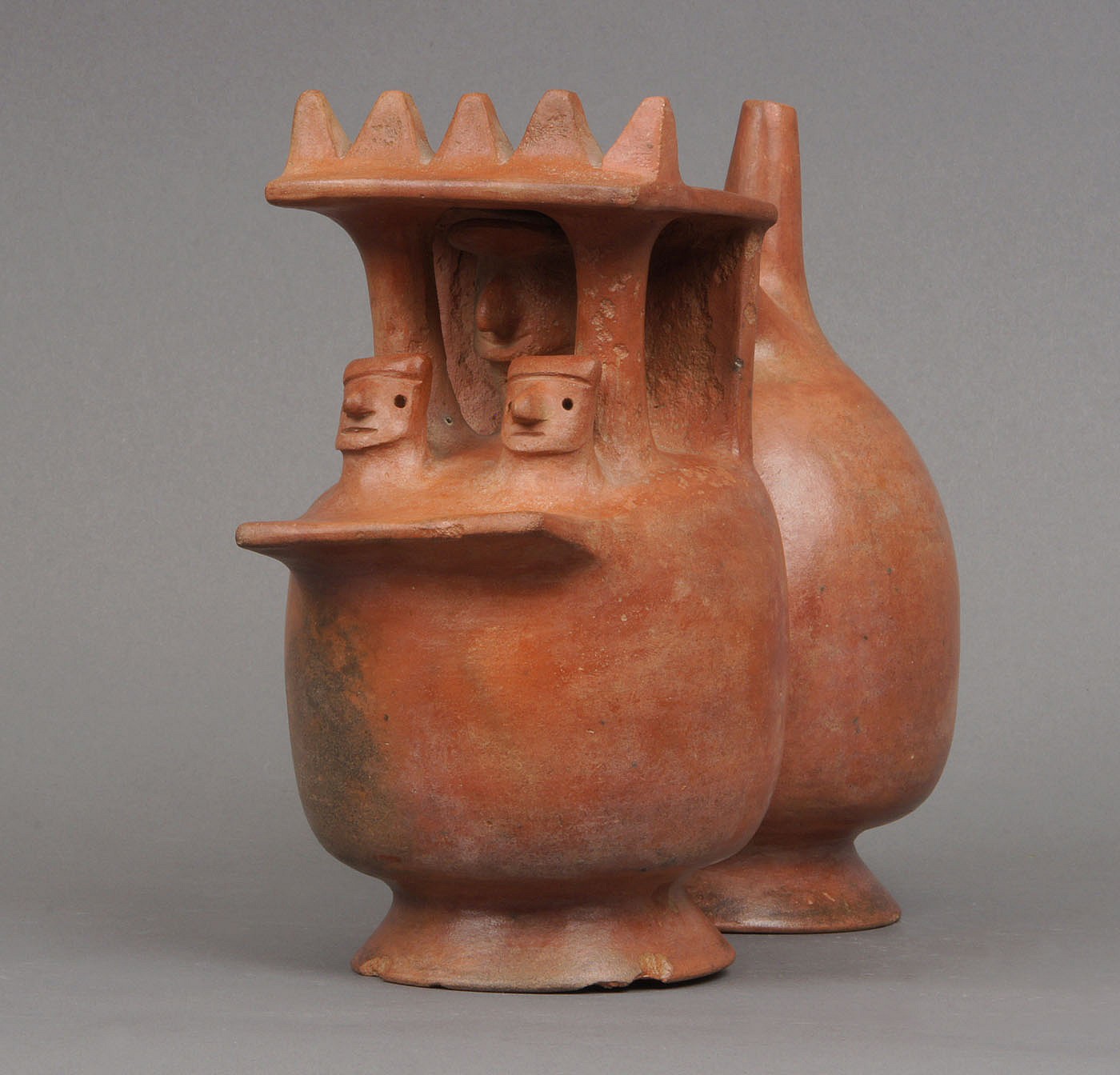



Peru, Virú Double Chambered Single Spout Whistling Vessel in the Form of a Temple
A strap handle orangeware vessel of a temple with lord and two attendants. The two heads could also be architectural elements or trophy heads. There are traces of negative resist decoration. Larco Hoyle describes and llustrates similar shaped vessels in his monograph "Cronologia del Norte de Peru, La Cultura Virú" (1945: 4 and 8).
Media: Ceramic
Dimensions: Height 8" Length 7 1/2"
$4,500
92080
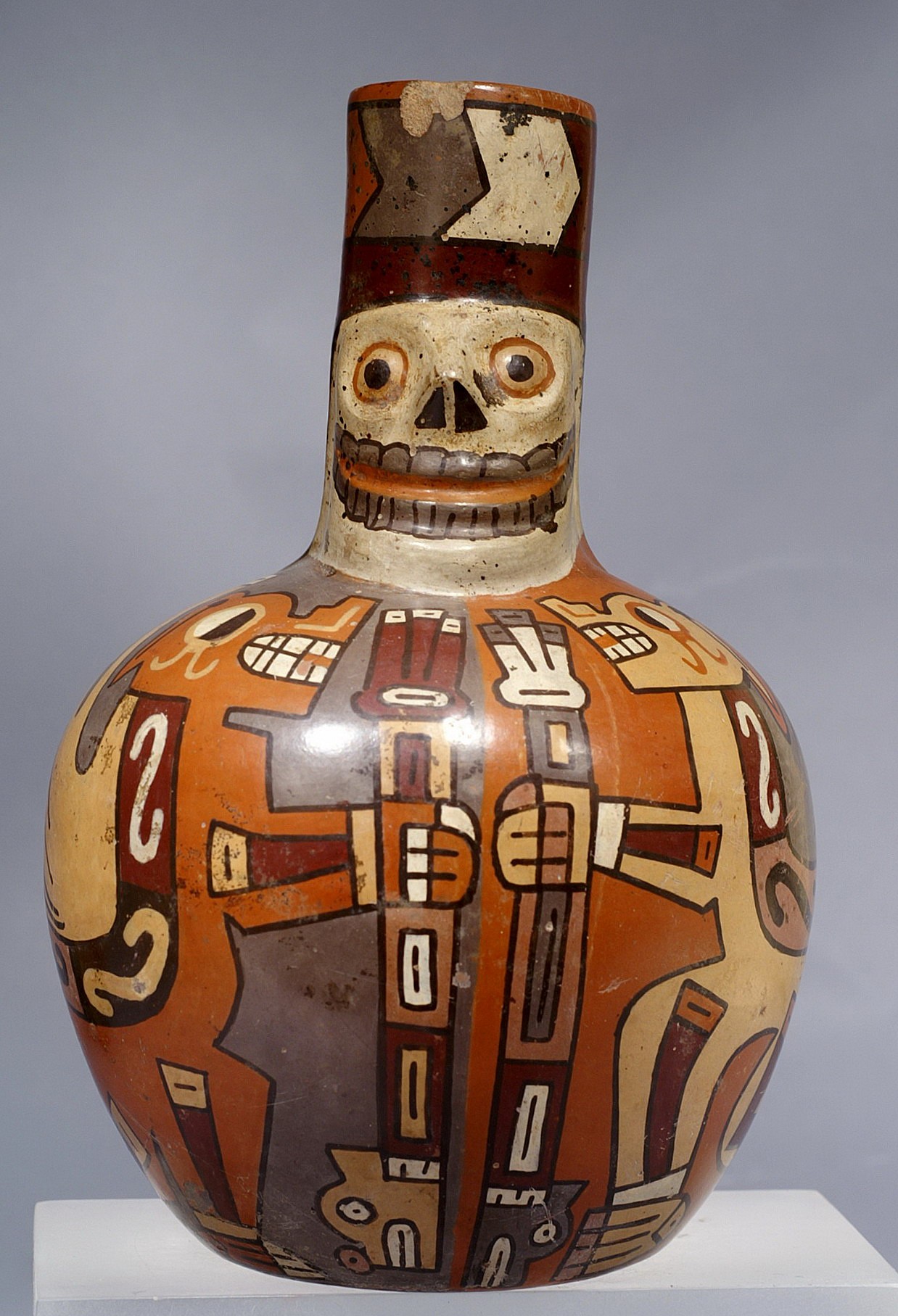




Peru, Wari Death-head Vessel with winged felines
This beaker with skeletal head in relief was painted with winged felines holding staffs. Both the skeletal relief and the mythical felines are characteristic of Wari pottery. A smaller similar vessel in the American Museum of Natural History in New York is published in Alan Lapiner, "Pre-Columbian Art from South America (1976: #542) and Margaret Young-Sanchez, "Tiwanaku: Ancestors of the Inca" (2004: fig. 6.6) Height 6 3/4" compared to the above of 8". The skeletal deity wears a class Wari tapestry tunic and a lovely hair-do on his black. The crouching winged pumas holding staffs are classic features of Wari Art & Iconography. This vessel was formerly in a German collection collected prior to 1970.
Media: Ceramic
Dimensions: Height: 8"
Price Upon Request
M7046
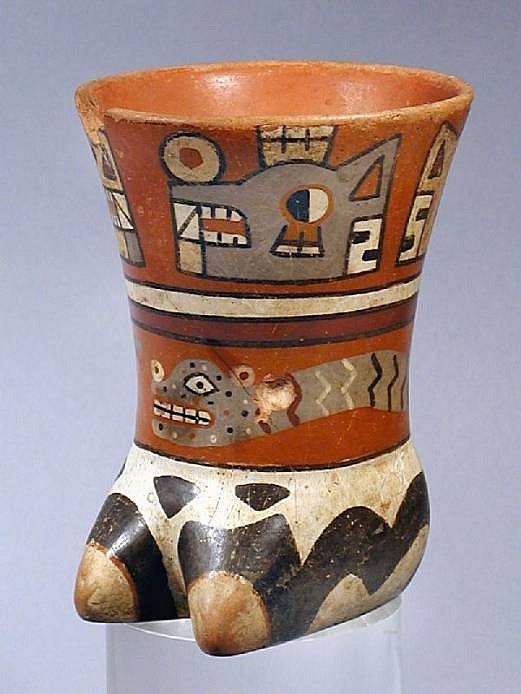



Peru, Wari Effigy Vessel of a llama hoof
The llama hoof is decorated in three bands, the upper with two sets of sun/moon heads facing each other. The middle band has an undulating serpent and the lower band is a black on white llama skin decoration.
Media: Ceramic
Dimensions: Height 5"
Price Upon Request
M3079
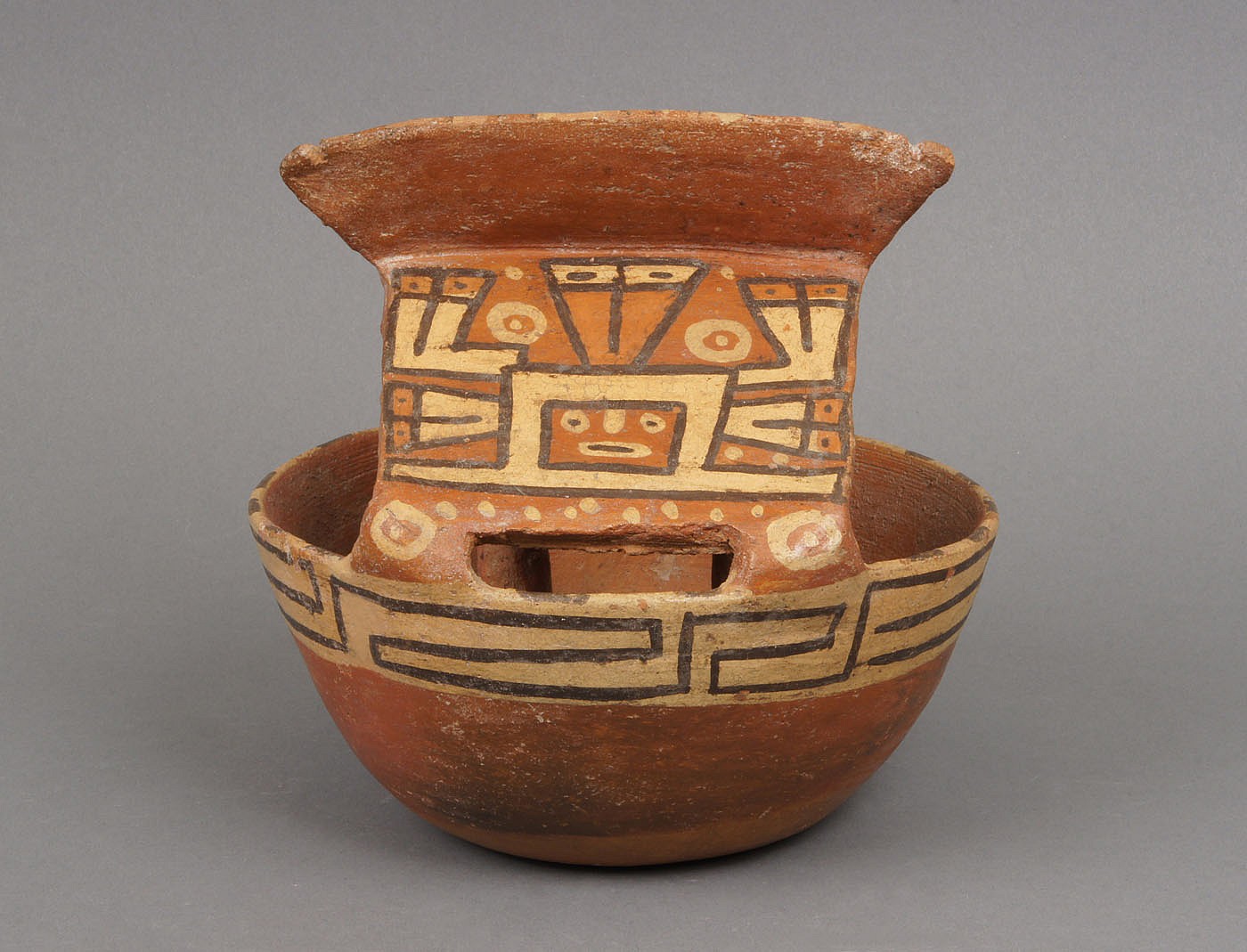





Peru, Wari House Vessel with Overhanging Roof on Two Pillars
An effigy bowl in the form of a temple with a decorated roof. The sloping roof supported by pillars was likely decorated with a fresco. There are some temples in Southern Peru which still have traces of fresco decoration dating from the early Wari period. The columns taper to the top and have a lentil support. Photographed by Justin Kerr for Alan Lapiner, New York, June 1968.
Media: Ceramic
Dimensions: H. 7 in.
$5,400
91993
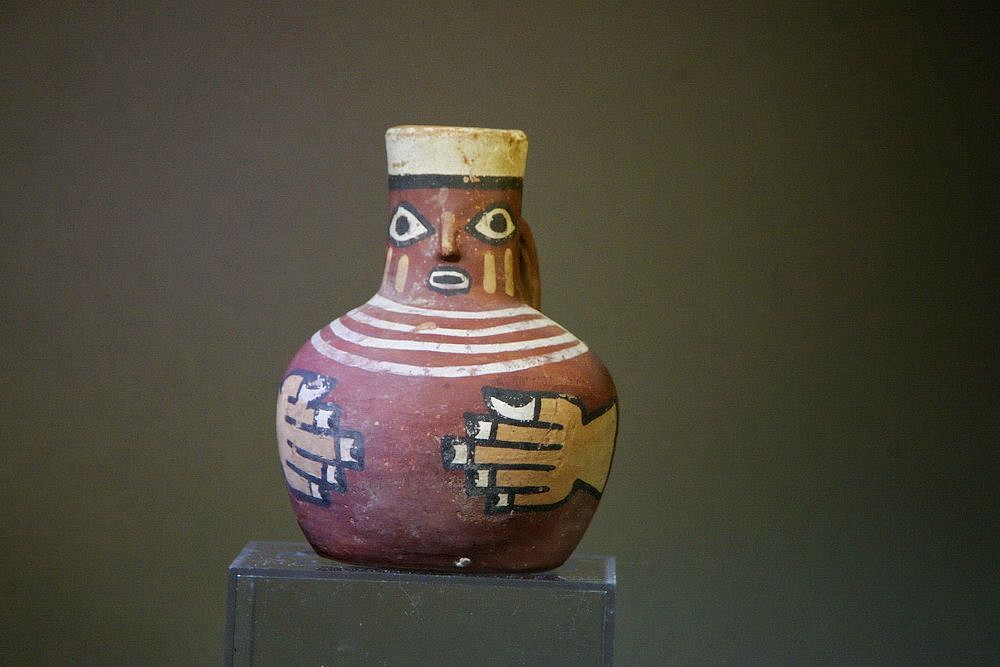





Peru, Wari Miniature Effigy of a Man with Large Hands
This is a common style of figurative vessel painted by the Wari and most likely represents a feasting man with a full belly. The Wari held large communal feasts where food was served along with chicha, corn beer, which was spiked with psychoactive plants such as Peruvian pepper – as found at Wari archaeological sites. This vessel is one of a set that was found at the same gravesite.
Media: Ceramic
Dimensions: Height 4 3/4"
Price Upon Request
n3024
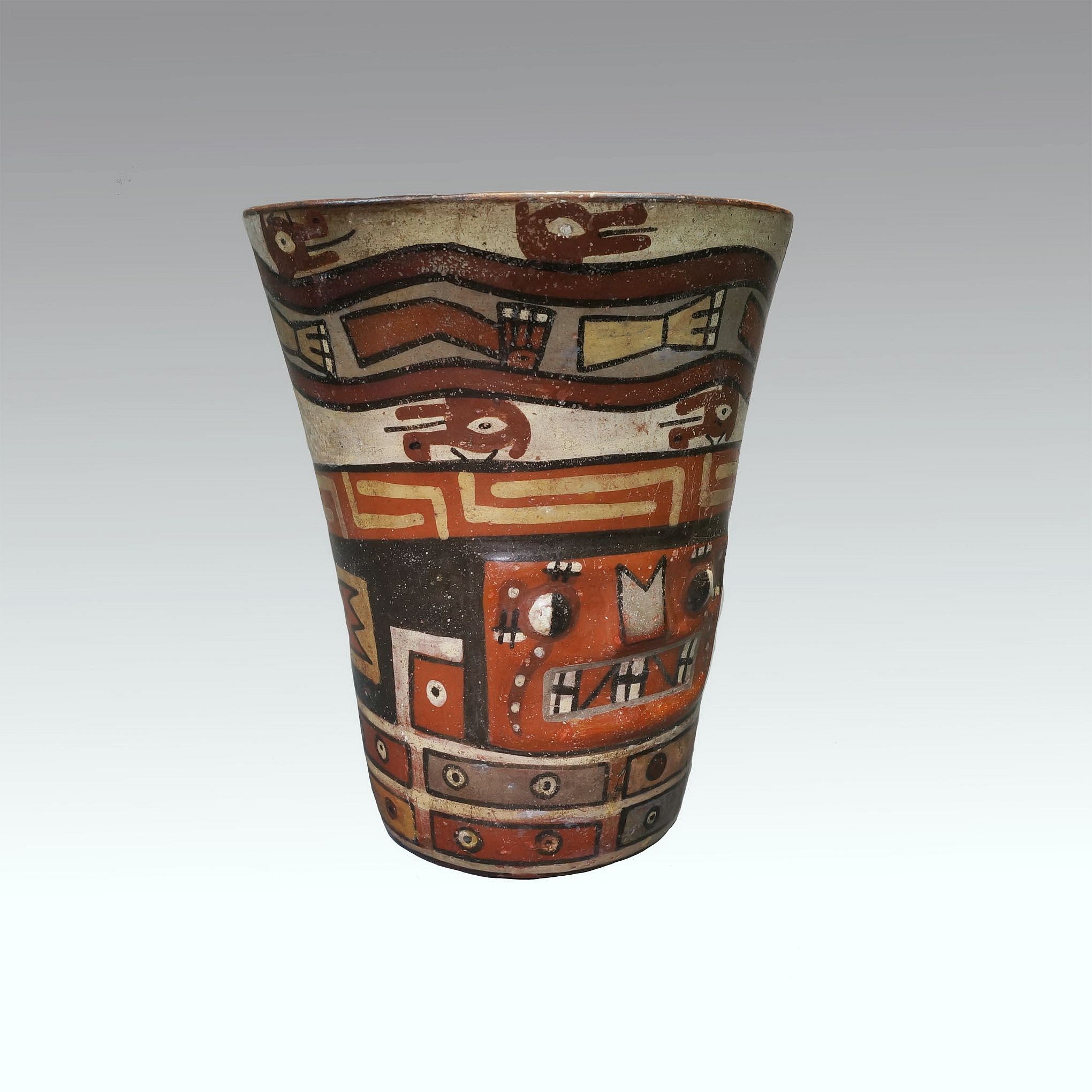
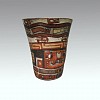
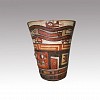
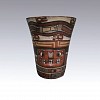
Peru, Wari Polychrome Kero
This is a very colorful example of a classic Wari kero wtih the facial features in relief. There are three registers above the deity's face and one below. Ex-collection Hans Monheim (Achen, Germany).
Media: Ceramic
Dimensions: Height 71/4"
Price Upon Request
M4087
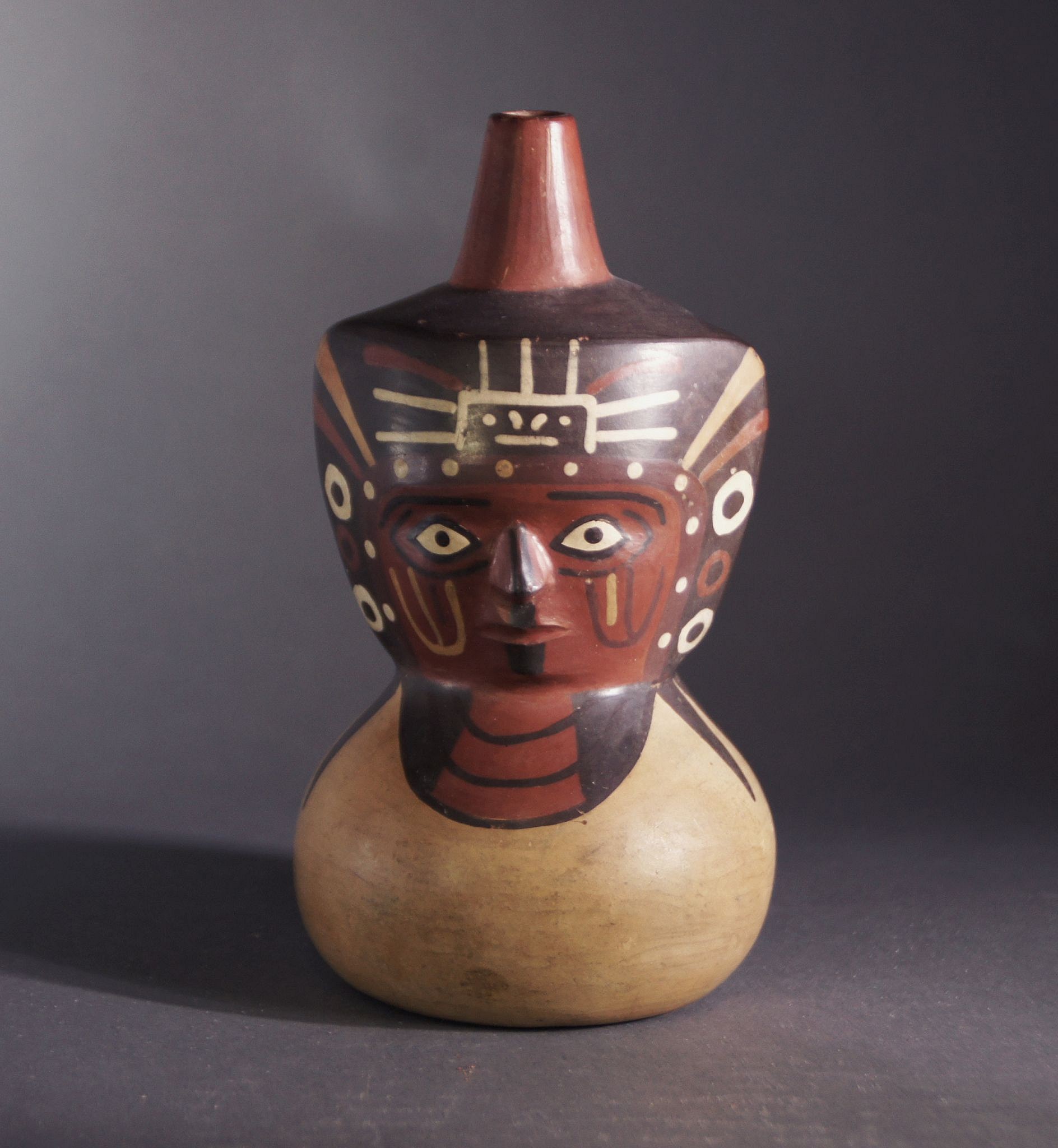


Peru, Wari Single Spout Figural Bottle with Elaborate Facial Decoration
This effigy vessel is painted with an individual wearing a diadem on his headdress and as well as a triple-strand necklace, indicating that he is a shaman or other important personage. He wears a black head covering, which is depicted draped around the shoulders. Ex. collection Anton Roeckl, Munich. T/L tested in Berlin.
Media: Ceramic
Dimensions: 6 in.
Price Upon Request
94114A
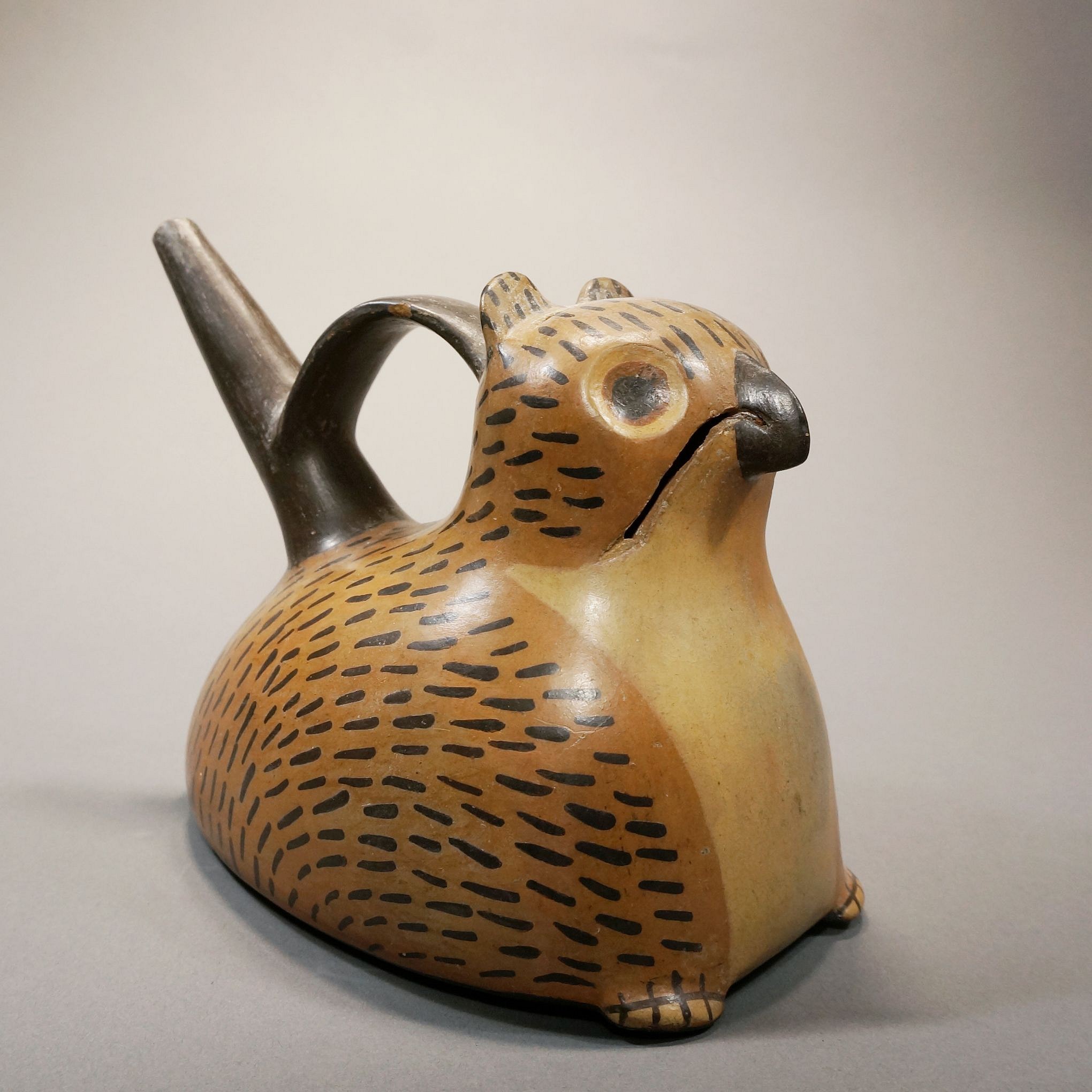
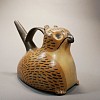
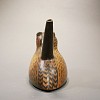
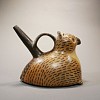
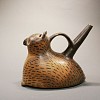
Peru, Wari Single Spout Owl Effigy Vessel in tan with black highlights
The effigy has black dashes representing feathers along its body. The chest of the owl is painted a lighter shade of tan with two feet protruding from the base. A very similar vessel is illustrated in José Antonio Lavalle "Nazca" (1986: 158). Ex-Collection Monheim (Achen, Germany).
Media: Ceramic
Dimensions: Height 8" (20cm) x Length 8.5" (21.5cm)
Price Upon Request
M4093


